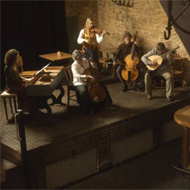
From Airs de Cour, Étienne Moulinié, Paris 1629 as early Folia on the text 'Om sijn vlam wat te vermijden' (from: Hemelschen Parnassus-bergh, 1678 Couplets de Folies variation no. 9 - Marin Marais
'Follia' variation no. 4 - Arcangelo Corelli 'Folies d'Espagne' - Raoul-Auger Feuillet including choreography (1700)
- Camerata Delft (Quirine van Hoek violin and soprano, Lotte Beukman cello, Ilil Danin recorder and virginal, Earl Christy Renaissance lute, Ricardo Rodríguez Miranda viola da gamba, Jarmila Boonstra dance)
Folias by Camarata Delft
Duration: 4'39" direct link to YouTube
© 2022 by Camerata Delft- Title: La Folia
- Published at YouTube 2 Decemer 2022
- Duration: 4'39"
- Recorded live in Restaurant/ & Eetcafé De Waag, Markt 87, Delft, The Netherlands, 28 September 2022
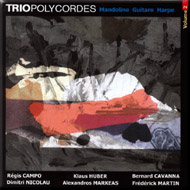
'Chaconne' as part of 'Dancing' (édition Henry Lemoine), a suite in four parts (1 Rag-tango, 2 Chaconne, 3 Fly Dance in the night, 4 Chicken rock)
The chaconne follows rather accurately the Folia chord progression throughout the piece. The repetitive character reminds me of the Folia by Ian Krouse. A piece that instantly pops up in my mind listening to Chaconne is "Continuum" by Gyorgy Ligeti a classical in the contemporary repertoire for harpsichord, another instrument with plucked strings. Although plucked strings cannot create a continuous motion of legato, the very fast repetition of tones, resulting in three wavelike movements, suggests that such an impression can be created in Chaconne.
- Trio Polycordes: Isabelle Daups (harp), Jean-Marc Zvellenreuther (guitar),
Florentino Calvo (mandolin) 'Volume 2'
Trio Polycordes wrote for the slipcase (in a translation by E. Doucet):
Duration: 3'13", 2938 kB. (128kB/s, 22050 Hz)
Chaconne, the entire piece as part of 'Dancing'
© 2002 Régis Campo/La Follia Madrigal, used with permission
Carrying out an adventure, sowing long-lasting seeds is what the Trio Polycordes intends to do with this second record, focusing on the creative processes at a given time in a sort of inventory of today's musical praxis. The first recording recounted the genesis of an ensemble and a repertoire. Now time has come to develop both a story and an identity, to lay solid foundations. This second record aims at clearing a musical "terra incognita", giving each instrument the opportunity to reveal itself, making sure this shared land will be flourishing. Régis Campo's filiation can be traced back to the Baroque age . He pays a tribute to this musical tradition and at the same time perpetuates and renews it. Dancing is closely related to the "Suites de danse" made famous by composers such as Couperin or Rameau but Campo adds his own touch of night club atmosphere. The work is built round a glorious and luxuriant Chaconne. The theme of La Follia, clearly brought out at the outset, is gradually blurred by rich arabesques but can still be heard distant and faint as in a dream. Main panel of a contemporary altar-piece, this brilliant part is enhanced by the extremely minimalist movements that surround it. The first of them - Rag-Tango - is a double humorous reference. Regis Campo follows both Rag Time's spasmodic rhythm and the glissandos of the double-bass typical of a tango band. This unlikely mixing results in a strange ballet of sounds, a poetical evocation in which the dancers' steps on the stage may be heard through muffled notes. The last two movements belong to the tradition of animal paintings or that of the bestiary. Fly Dance in the Dark pursues the trill of the Chaconne and turns it into a key element in that behavioural study of flies' life. The buzzing insects induce a progressive fall into drowsiness in the listener. It's a lazy summer day's rest. But hey! What sheer pandemonium at the beginning of the fourth movement! Clucking, squawking, cackling, flapping of wings wake us up in an infuriated henhouse. Chicken Rock is a true, boisterous, gallinaceous Woodstock.
- Title: Dancing, (éditiopn Henry Lemoine)parts: 1 Rag-tango 2 Chaconne, 3 Fly Dance in the night, 4 Chicken rock. Chaconne is derived from the later Folia theme
- Released 2002 by La Follia Madrigal compact disc LFM11101, barcode 3 760023 510081 French distributor : EPI
- Duration: 3'13"
- Recording date: November 2001 at La Cave Dîmière, Argenteuil, France
- Revel, Jean-Christophe 'La Musique aujourd'hui: Régis Campo'
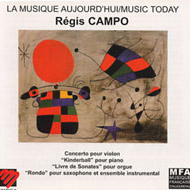
Régis Campo wrote in March 1999 for the slipcase:
Duration: 2'50", 2604 kB. (128kB/s, 44100 Hz)
Sonate la Follia, the entire piece
© 1999 Régis Campo/Jean-Christophe Revel, used with permissionThe Livre de Sonatas ('Book of Sonatas') for organ groups several commissions from the Spanish Ensems 97 festival, the city of Auch and Radio France. Composcd between 1997 and 1999, this is the fruit of a wonderful. lasting oollaboration with the young Frcnch organist Jean-Christophe Reve1. Each sonata is conceived in a single movement developing a single idea, in the manner of Domenico Scarlatti's sonatas or, better yet, Rameau's harpsichord pieces. L'extravagant is a sort of mechanical fantasy mingled with obsession ansd false naïvete. Le Don and La Nuit are the two most nocturnal sonatas of the cycle, the second, of course, being dedicated to the great master Vivaldi, whereas La Follia makes use of the famous 15th century dance. [...]
.- Title: Sonate la Follia (1998) from Livre de Sonates for organ
- Released October 1999 by Mandala compact disc MAN 4948 (distribution Harmonia Mundi)
- Duration: 2'50"
- Recording date: January 1999 in church of Saint Ferdinand des Ternes, Paris, France
- Publisher : editions Henry Lemoine, Paris, France
- Rouet, Pascale 'Autour de l'Espagne'
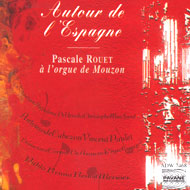 Régis Campo wrote for the slipcase:
Régis Campo wrote for the slipcase:
The sonata 'La Follia' is taken from my 'Livre de Sonates' composed betwen 1997 and 1999 for the benefit of the young organist Jean-Christophe Revel. This 'Livre' gathers together several orders from Radio France, the Spanish festival Ensems at Valencia, and the Association of the Friends of the Organs at the cathedral of Auch.
Each Sonata, built in a single movement and developed around one theme only, is a reminder of Scarlatti's Sonatas or Rameau's Pieces for the harpsichord. Sonata no. 4 'La Follia' brings back the famous 15th century dance in a somewhat ironical and outmoded way. Pascal Rouet gives us a dynamic and personal version, highly consistent with the forceful spirit of my music.- Title: Sonate no. 4 'La Follia' (Edition Lemoine) for organ
- Released 2003 by Pavane Records compact disc ADW 7468
- Duration: 2'29"
- Recording date: July 2-4, 2001 in l'Abbatiale B-D de Mouzon, France
- Borbye, Anders 'Refolia, contemporary works for guitar'
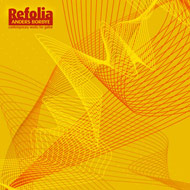 Régis Campo wrote for the slipcase:
Régis Campo wrote for the slipcase:
This version for guitar was written with the help of the French guitarist Jean-Marc Zwellenreuter. I was looking for a very playful sound, Baroque in character and with humour and wit. This version is very different from the original version for organ with respect to texture and dynamics. I like the idea of the bottleneck in this piece; it is a good example of my ludic musical style.
- Title: Sonate la Follia (1998)
- Released October 2008 by Gateway compact disc AB001
- Duration: 3'28"
- Recording date: August-September 2008 in the Frederikskirken, Aarhus
- See the page Recommended Folia recordings
- More about Anders Borbye at http://www.andersborbye.dk
- Zvellenreuther, Jean-Marc 'Folias'
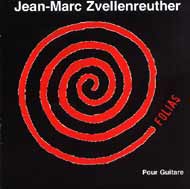 Jean-Marc Zvellenreither (translation into english by Atez Eloiv) wrote
for the slipcase:
Jean-Marc Zvellenreither (translation into english by Atez Eloiv) wrote
for the slipcase:
Régis Campo made a new Folia-version, in the spirit of composers of the 17th century, who didn't hesitate to transcribe their works for different instrumental formations. After the presentation of the theme in a rather baroque style, the composer uses different modes in the aim of disarticulating the phrase and introducing different kinds of interferences. The long development in harmonics was suggested by Régis Campo by a cadence in a concerto for guitar by Villa-Lobos.
- Released 1999 by La Follia Madrigal compact disc LFM099900
- Duration: 2'56"
- Recording date: September 1999 at La Cave Dîmière, Argenteuil France
Little is known about this group who performs popular songs in Italy near the border of Austria. I tried to contact them in English but I guess their English is even worse than my Italian. The Folia-performance consists of 3 times the Folia theme (16 bars) and ending with another 8 bars of the ending of the Folia with some modulation. The instrumentation and way of humming the notes is in a very folky way (a setting of a party with a campfire would be an excellent ambiance I suppose). Although the vocal parts are dominant no words are articulated, pure mouth music accompanied by mandoline, accordeon, some winds and drums in the background.
- Canzoniere del Progno 'Tornarà el tramvai'
- Released 2005 by unknown company with unknown order number.
- Duration: 1'14"
- Recording date: unknown place and date of recording
- More about this ensemble in the Italian language at http://www.canzonieredelprogno.it/

 |
Folías Españas (Follies of Spain) for piano |
- Carbajo, Víctor
- Released 2017 by Carbajo, Victor for ILSMP
- 17 Variations, 16 pages of A4 format
- Duration: 6'30"
- Publishd at YouTube by Victor Carbajo 19 January 2018 https://www.youtube.com/watch?v=hUaRXklCUQ0
- The sheet music can be found in the ILSMP Library https://imslp.org/wiki/File:PMLP736921-carbajo-follies_of_spain-2016-pf.pdf
- Website of the composer: http://www.carbajo.net/obra/obra-2016-i.html
Work commissioned by Solisti Aquilani
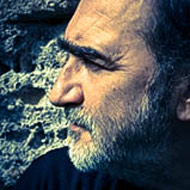
Mauro Cardi wrote about his composition in the Italian language at his website:
La Follia è uno di quei temi la cui origine si perde nella notte dei tempi, spingendoci a ritroso, in Portogallo, almeno fino al XV secolo, per arrivare fino ai nostri giorni, dopo aver attraversato tutta la storia della musica, con centinaia di versioni e variazioni sul tema. Nel mio lavoro il riferimento è soprattutto alle versioni della Follia date da Marin Marais nelle Variazioni “Les Folies d’Espagne” e da Georg Friedrich Händel nella Sarabanda dalla Suite in Re minore. Sul tema della Follia si reggono alcune campate che sostengono il pezzo, strutture di otto misure, o multipli, in cui spesso il frammento diviene un materiale che si dispone anche verticalmente, arrestando il flusso melodico-armonico, raggelandolo in cluster, diatonici, o creando scie sonore che prolungano la memoria tematica e che conducono lentamente l’ascolto altrove, pur evocando un’illusoria caleidoscopica staticità.
Dalla Follia diventa poco alla volta impossibile liberarsi, questa è l’esperienza che ne ho fatto. C’è infatti una forma ossessiva nel tema che attraversa tutto il pezzo, una follia lucida, straniante, ipnotica nel suo ruotare sempre intorno a se stessa. Nomen omen.
La viola d’amore è accordata in maniera tradizionale (La Re La Re Fa La Re), mentre le sette corde di simpatia contengono anche due note eccentriche, Mib e Sib.
- Solisti Aquilani (with Luca Sanzò viola and viola d'amore)
- Première 15th February 2017, Auditorium del Parco, L'Aquila, Italy
- Repeat: 16th February 2017, Accademia Filarmonica Romana, Teatro Argentina, Roma, Italy
- Duration: ca. 15'30"
Patrick Cardy wrote about this composition:

La Folia is a set of variations for chamber orchestra, commissioned by l'Ensemble du Jeu Présent, with the assistance of the Canada Council. La Folia was one of the most popular bass progressions used for sets of variations, songs and dances in the late Renaissance and Baroque eras. Its origins are obscure, although it probably originated in Spain or Portugal some time in the early 16th century, from whence it spread to Italy, France and England. It goes under many names in many countries - la folia , la follia , les folies d'Espagne and Farinel's Ground , among others. And it is often, though not always (and not in this piece), associated with a standard discant melody. Some of the more famous treatments of la folia include a set of keyboard diferencias by Antonio de Cabezön (1510-66), a set of variations for violin by Michel Farinel (1685), the masterly set of 24 variations in d, Op. 5, No. 12, for violin and continuo, by Archangelo Corelli (1700), and the Sonata in d, Op. 1, No. 12, for two violins and continuo, by Antonio Vivaldi (1705). In La Folia a variant of the original bass progression is woven, usually very audibly and clearly, but in many different voices and textures, into the fabric of each variation.
The oeuvre of Patrick Cardy can be found at http://www.carleton.ca/~pcardy/- Cardy, Patrick
- Score of La Folia for string orchestra (for sale or on free library loan) and parts (rental only) are available from: The Canadian Music Centre, 20 St. Joseph Street, Toronto, Ontario, M4Y 1J9, tel.: 416-961-6601, fax: 416-961-7198, e-mail info@musiccentre.ca, webside: www.musiccentre.ca or www.centremusique.ca
- The score is 101 pages (plus title page and instrumentation/performance note page); full size, it is 11"x17", but the Canadian Music Centre can also reproduce it in smaller sizes.
- 14 parts (flute/piccolo,oboe, clarinet in Bb, bassoon, horn in F, trumpet in Bb, trombone, percussion (one player: triangle, high sizzle cymbal, medium cymbal, low cymbal, crotales, glockenspiel, vibraphone, tam-tam, bass drum), piano/celesta, violin I, violin II, viola, violoncello, contrabass), reproduced in booklets on standard 9-1/2"x12" sheets.
- l'Ensemble du Jeu Présent/Bellomia, Paolo conductor
- Premiere November 2, 1997 (place unknown), recorded for broadcast on Musique Actuelle (TBA) May 15, 1998
- Duration: 16'00"
- Recording date: May 15, 1998 in the National Gallery of Canada, Ottawa
- Grupo Koan, conducted by José Ramón Encinar, violin solo
Luis Navidad
- Released by unknown
- Duration: 9'10"
- Recording date: March 4, 1980 in the Casa de la Radio de Radio Nacional de España, Prado del Rey
- Orchestra da Camera del Cantiere, conducted by José Ramón
Encinar
- World premiere
- Recording date: August 9, 1978 in Montepulciano, Italy
Originally published in IIIeme Recueil de menuets, allemandes, et contredances, avec vingt et une variations des Folies d'Espagne, touttes en pincés différents, et d'un genre nouveau, entremêlés d'ariettes avec leurs accompagnements pour le cythre, ou guitthare allemande, qui peuvent néantmoins s'exécuter sur la Mandore et sur la guitthare espagnole..., edition Paris, 1771
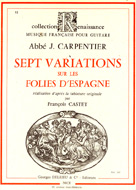
 |
Duration: 3'54", 11 kB. |
- François Castet 'Collection Renaissance , Musique Française pour guitare Vol VI'
- Published 1968 by Georges Delrieu & Cie., Nice
- Order number G.D. 1415
- 4 pages in modern sheet music, created after the original tablature
- Collection Dr. D.F. Scheurleer (inv. 7388 Royal Library, Den Hague, Netherlands)
- Title: IIIeme recueil, de menuets, allemandes et contredances : avec vingt et une variations, des folies d'Espagne, touttes en pincés differents, et d'un genre nouveau, entremelés d'ariettes, avec leurs accompagnements : pour le cythre, ou guitthare allemande, qui peuvent neantmoins s'executer sur la mandore et sur la guitthare espagnole / par Mr Carpentier Chan. de St. L. du Louvre amateur
- Published by Le Marchand, Paris, France
- Size 26 pages, 33 cm
- Le Concert Impromptu (oboe, clarinet, bugle, bassoon and flute) 'Nouvelles
folies d'Espagne'
- Released February 2002 by Aime La Belle Records compact disc without order number
- Duration: c. 20'
- Recording date: February 2002 in Temple St Marcel, Paris, France
Michael L. Carroll wrote about his Variations on Folias for String Quartet:

I just composed a new variant of the Folias. These are "loose" variations in that I allowed myself to modulate to other keys and to insert a parallel major version of the Folias chord progression. The piece starts in D minor and is written in 17th century style counterpoint and gradually evolves into a more modern treatment with modulations to a variety of keys and ending in D major. Although my variations are based on the Folias chord progression, nowhere in the piece do I actually quote the Folias melody The playing time at 100 bpm should be about 6 minutes. I was inspired to write this after seeing the Folias-website. The PDF score and an mp3 file are attached.
- Carroll, Michael L.

All Variations on Folias created with Finale (GPO) by Michael L. Carroll
Duration: 5'58", 2451 kB. (56kB/s, 22050 Hz)
© 2009 Michael L. Carroll, used with permission
Variations on Folias in pdf-format, size 60 Kb
The complete sheet music
© Michael L. Carroll 2009, used with permission.- Published 2009 by Michael L. Carroll
- Soundfile generated from within Finale using the Garritan Personal Orchestra (GPO). Although the samples sounds of the GPO are vastly superior to the ordinary, monotonous synthesized MIDI sounds, there is nonetheless a computer-generated feel to these. They sound much, much better, of course, with real human performers. This file is only intended to give you an idea.
- Duration 5'58"
- Score 12 pages for 4 instruments (violin 1, violin 2, viola and cello)
- More about the oeuvre of Michael L. Carroll you can fin at http://www.musicarroll.com/
Michael Carroll wrote about his Theme and Canonic Variations on Folias of Spain in an e-mail the 13th of March 2015:
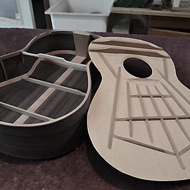
I've completed another folias composition, this time a duet for two guitars. It starts off with the traditional folias with variations in d minor and then modulates to a minor where it presents variations on a different chord progress but similar in some ways to the folias; then it modulates back to d minor and the folias chord progression for a short reprise.
You have my permission to post on the Fol website.
- Carroll, Michael L.

Theme and Canonic Variations on Folias of Spain in pdf-format, size 70 Kb
The complete sheet music for two guitars
© Michael L. Carroll 2015, used with permission.
Theme and Canonic Variations on Folias of Spain in pdf-format, size 60 Kb
The complete sheet music for guitar I
© Michael L. Carroll 2015, used with permission.
Theme and Canonic Variations on Folias of Spain in pdf-format, size 60 Kb
The complete sheet music for guitar II
© Michael L. Carroll 2015, used with permission.- Published 2015 by Michael L. Carroll
- Soundfile generated from within Finale using the Garritan Personal Orchestra (GPO). Although the samples sounds of the GPO are vastly superior to the ordinary, monotonous synthesized MIDI sounds, there is nonetheless a computer-generated feel to these. They sound much, much better, of course, with real human performers. This file is only intended to give you an idea.
- Duration 7'03"
- Score 9 pages for 2 guitars and two parts (4 and 5 pages)
- More about the oeuvre of Michael L. Carroll you can fin at http://www.musicarroll.com/
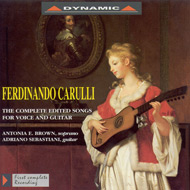
- original manuscript in Biblioteca Musicale Greggiati Ostiglia
- Sebastiani, Adriano 'The Complete Edited Songs for Voice and Guitar'
- Title: Les Folies d'Espagne variées Op. 75 in D minor (for solo guitar)
- Released January 1, 1996 by Dynamic compact disc 124
- Duration: 7'31"
- Recording date: 12-12 September 1994, Florence
- Soloist: Adriano Sebastiani
Salvador Castro de Gistau, originally from Madrid became editor of the "foreign music" magazine 'Journal de Musique Etrangére pour la Guitare ou Lyre' in this Paris
- Castro de Gistau, Salvator

Theme and 9 var. in pdf-format, size 2.44 Mb
The facsimile sheet music for guitar
© The Royal Irish Academy of MusicOpening of Variations de Las Folias d'Espagne from the original publication 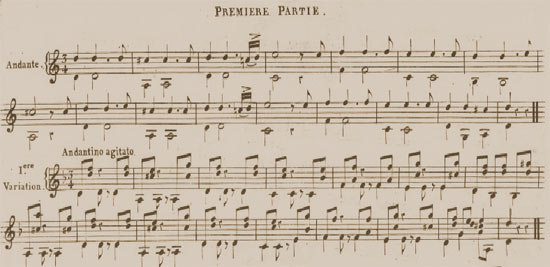
- Title: Première partie: theme and 9 variations
- Published in: Journal de Piéces de Musique pour la Guitarre Tirées de divers Auteurs Espagnols & autres; Publié par S. Castro (de Gistau) No 16
- Published unknown year by Salvador Castrode Gistau (l'Éditeur et l'Auteur) in Paris, France
- 4 pages
- Original source available at the internet by The Royal Irish Academy of Music Call no:H.XXXVIII.10.(37) (Hudleston Digital Library)
- Grohen, Markus (re-published the score)

Duration: 0'39", 02 kB.
The opening as indicated in the sheet music belowOpening of Variations de Las Folias d'Espagne Published in 'Guitarre & Laute', 1995 
- Published by the German Magazine 'Guitarre & Laute', Jahrgang XVII, heft 6, 1995
- Score 14 p., 29 cm
- Vandecauter, Herman (guitar)
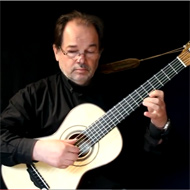 As far as I know this is a worldpremiere recording of an old manuscript in a high quality performance.
As far as I know this is a worldpremiere recording of an old manuscript in a high quality performance.
La Follia by Herman Vandecauter
Duration: 6'41" direct link to YouTube
© 2015 by Herman Vandecauter- Title: La Follia (première partie: theme and 9 variations)
- Published at YouTube May 2015 by Herman Vandecauter
- Duration: 6'41"
- Recorded May 2015 in Belgium
- For the website of Herman Vandecauter see: http://www.earlyguitar.be/
- La Cetra d'Orfeo: Didier Laloy (diatonic accordion), Michel Keustermans (recorder and director), Hervé Douchy (violoncelle), Jacques Willemijns (harpsichord), Jurgen De Bruyn (theorbo and baroque guitar),
Stephan Pougin (percussion), Laura Pok (recorder), Ingrid Bourgeois (violon).

Duration: 1'27", 1.4 Mb. (128kB/s, 44100 Hz)
Fragment of Poule Noir
© 2007 La Cetra d'Orfeo, used with permission
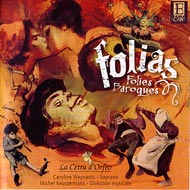 Michel Keustermans wrote for the slipcase (translation by Rachel Stacchini-Betton-Foster):
Michel Keustermans wrote for the slipcase (translation by Rachel Stacchini-Betton-Foster):
Finally, it was difficult to resist this last temptation: our Walloon Folklore has an abundance of tunes going back to the beginning of time, and 'Poule Noire' (Black Hen) is nothing if not an authentic Folia which has come down the ages through popular dancing.
- Title: Poule Noire (black hen), unfortunately no sources mentioned for this tune
- Released 2007 by EOLE compact disc EAD002
- Duration: 3'25"
- Recording date: May 2006 at Chapelle du Bois
- See also the page Recommended Folia-recordings
- Chatham Baroque (Julie Andrijeski baroque violin, Patricia Halverson viola da gamba, Scott Pauley theorbo and baroque guitar)
with guest artists Daniel Mallon percussion and Becky Baxter harp
Folias by Chatham Baroque with guests live
Duration: 10'34" direct link to YouTube
© 2011 by Chatham Baroque- Title: Folias
- Broadcasted by unknown radiostation
- Duration: 10'34"
- Recorded live March 11, 2005 in St. Paul's United Methodist Church, Houston, United States as part of the Houston Early Music Series
- See for the program: http://www.houstonearlymusic.org/hemarchive/archive/2004/chatham.htm

Set of twelve variations on the Folia theme for brass quintet (Trumpet in C1, Trumpet in C2, Horn in F, Trombone, Tuba)
A very nice and transparent composition for brass quintet. Somewhat in the idiom of the Folia variations by Jan Bach, which I consider as one of most interesting and enjoyable efforts to translate the Folia theme to modern times. The nice thing of a brass quintet is that the voices are so clear that the listener can distinguish the action and interaction bewteen the voices. Further on the Folia theme has a somewhat fragile setting with that modest melody line but the brass instruments transform the music into a very powerful statement especially with those firm trumpets. Those intriguing features strike me again when listening to the music of Jean Chatillon with his Fantaisie sur La Folia
Jean Chatillon wrote about his Fantaisie sur La Folia:It was after listening to the fine compositions of my two friends of the Delian Society (editor: Thomas Matyas and David W. Solomons) that I became intoxicated by this tema.
- Chatillon, Jean written in Finale2005

Duration: 7'58", 7.56Mb. (128kB/s, 44100 Hz)
The complete set of variations
© 2009 Jean Chatillon, used with permission
Fantaisie sur La Folia, 22 pages in pdf-format, size 255 Kb
The complete sheet music
© Jean Chatillon 2009, used with permission.- Title: Fantaisie sur La Folia
- Duration: 7'58"
- Published by Editions de l'Ecureuil Noir, Becancour, Canada
- 22 pages, size 21 x 29 cm (and 5 parts)
- More about the composer and his compositions at: http://www.jeanchatillon.com/
- Musicians from Budapest (Hungary)
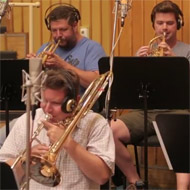
Musicians from Budapest
Duration: 8'20" direct link to YouTube
© 2009 and 2018 by Jean Chatillon- Title: Variations sur La Folia pour quintette de cuivres
- Duration: 8'14"
- Published by Jean Chatillon, 13 October 2018 at YouTube
- Recorded August 2018
- Link to the YouTube performance https://www.youtube.com/watch?v=jJOO8h0RrxM
- Ensemble Oni Wytars 'La Follia, the triumph of Folly'
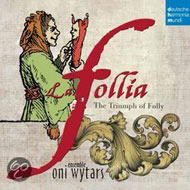 Great performance with the unusual nickelharpa to give the tune a Scandinavian setting.
Great performance with the unusual nickelharpa to give the tune a Scandinavian setting.
- Title: Les Folies d'Espagne
- Released 2013 by Deutsche Harmonia Mundi compact disc 88765449782
- Duration: 2'44"
- Recording date: October 1-3, 2011 in Kurtheater, Bad Kissingen, Germany
- See also recommended recordings
- Van Kerckhoven, Pieterjan & Van Troyen, Bart (bagpipes)
Ever heard two bagpipes play the Folia in full harmony?
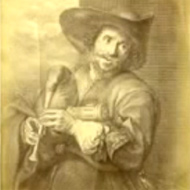
Pieterjan Van Kerckhoven and Bart Van Troyen
Duration: 7'50" direct link to YouTube
© 2013 by Pieterjan Van Kerckhoven and Bart Van Troyen- Title: Les Variations Amusantes Les Folies d'Espagne
- Released 2013 at YouTube by Bart Van Troyen
- Duration: 7'50"
- Recording date: 2013
- Bagpipes (musette) built by Remy Dubois
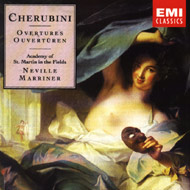
In the opening of the ouverture the folia-theme is several times ingeniously quoted, even in a somewhat fugative style.
- Academy of St. Martin in the Field/Mariner, Sir Neville 'Cherubini:
Ouvertures'
Basil Deane wrote in 1992 for the slipcase:Sometimes there is a historical reference - the use of the traditional theme 'La folia'in L'Hotellerie portugaise
.- Released 1992 by EMI CLASSICS compact disc CDC 7544382
- Duration: 9'43"
- Recorded 1991 in Studio Abey Road London, England
- City of Birmingham Orchestra/Foster, Lawrence 'Luigi Cherubini Ouvertures'
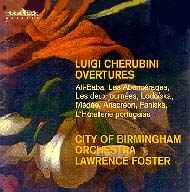 From the slipcase:
From the slipcase:
L'Hôtellerie portugaise, one of three one-act opéras comiques written in 1798 and 1799, is based on the familiar plot of the lovers who have to outwit the old guardian bent on marrying his pretty young ward himself. Set in an inn on the border between Spain and Portugal, the story this time moved Cherubini to make a discreet application of local colour, in the form of allusions to the popular Portuguese tune La Folia, in the slow introduction to the ouverture. The main Allegro section is a skilfully achieved accumulation of eager expectation which reaches its climax just before the end.
- Released 1996 by Claves Records, Switzerland compact disc CD 50-9513
- Duration: 11'58"
- Recording date: 5-6 February and 20 June 1995 in Birmingham, Town Hall

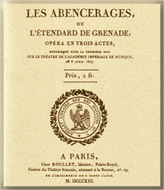 Nowadays this opera has sunk into almost complete oblivion and this may be the main reason that the quite substantial Folia in the Ballet in act 1
is never mentioned in the Folia literature, although the opera itself was the subject of a recent
dissertation. Fortunately a live recording of this opera from 1956 exists, although of an absolute poor quality.
In fact the Folia-theme in Les Abencérages is more prominently stated and worked out in variations throughout the above mentioned
Ballet than in the Ouverture from L'Hôtellerie portugaise. But fate decreed that it was the Ouverture that established Cherubini's fame
in the Folia literature; for instance in the New Grove Dictionary of music and musicians.
Nowadays this opera has sunk into almost complete oblivion and this may be the main reason that the quite substantial Folia in the Ballet in act 1
is never mentioned in the Folia literature, although the opera itself was the subject of a recent
dissertation. Fortunately a live recording of this opera from 1956 exists, although of an absolute poor quality.
In fact the Folia-theme in Les Abencérages is more prominently stated and worked out in variations throughout the above mentioned
Ballet than in the Ouverture from L'Hôtellerie portugaise. But fate decreed that it was the Ouverture that established Cherubini's fame
in the Folia literature; for instance in the New Grove Dictionary of music and musicians.Paul Korenhof wrote for the slipcase
The premiere of Les Abencérages took place at the Paris Opéra on 6 April 1813 in the presence of Napoleon and his wife and it proved one of the greatest successes of Cherubini's career.
- Orchestra di Theatro Comunale di Firenze conducted by Carlo Maria Giulini 'Gli Abencerragi'
- Released 2002 by Gala compact disc GL 100577 2cd-set
- Duration: 8'50"
- Recorded May 9, 1956 in Maggio Musicale Fiorentino, Florence, Italy
- Orchestra sinfonica di Milano conducted by Peter Maag 'Les Abencérages'

Gian Andrea Lodovici wrote for the slipcase:
The fact that this was one of Cherubini's most successful operas is confirmed not only by the enthusiastic comments of the many personalities present at the first performance, including Napoleon and Marie. Louise, but paradoxically also by the request made by the composer himself after about twenty performances that the dramaturgical part of the opera be cut and reduced into two acts in order to create more space for ballets. A practice reserved in France only for those operas that sought to becomepart of the "repertoire" [...]
To hear again the French version of 'Les Abencerages, however, we had to wait for the radio production of 15th January 1975 which Peter Maag and Radio Italiana chose to perform. This is a production that returned to the original three-act version of the opera, with limited use of ballets, and is proposed without significant cuts compared to the radio performance tradition of the time.- Title: Danses (cd 1: track 13)
- Released 1975 by MRF Records MRF/C-07 (C-071 - C-072) 2 lp-set and remastered 24bit/96kH by Archives January 2006 for a 2-set compact disc 43066-2
- Duration: 3'06"
- Recording date: January 15, 1975 in Milan, Italy

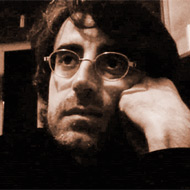
Antonio wrote in the preface of his composition (here indicated in an English translation):
The idea of ??composing variations on the famous theme of Folía (madness) was born from the proposal made to me by the dedicatee of this composition il Maestro Sergio De Blasi. I took the proposal with great pleasure as the theme Follía is a theme that has always fascinated me. The structure of the entire composition is spread over 15 variations of which the last is a 3-part escape and can be performed both on the harpsichord and on the organ. As for the organ it can be safely performed even on an ancient organ, leaving the performer free to eventually fill some parts with the pedals. The indication of the registers indicated in the score is not intended to be binding, but only a small idea of ??how I thought the song phonically, therefore the performer is left full freedom and imagination. The harmonic system of the piece develops on harmonies deriving from the superimposition of fourths and fifths for most of the song. While in the latest variations I preferred to use gradually a return to harmony classical-tonal and it seemed interesting to me, at the end of the song, to make the theme of Follía with the usual classical harmonic relationships, so that the listener can also elaborate a "pleasant musical journey" that with a modern style start leads to a more classic style. In conclusion I tried to be adherent to my style, but at the same time to turn my gaze towards the past, with the hope that these pages will enter the repertoire of organists or harpsichordists.
- Leonardo Antonio Di Chiara (organ or harpsichord)
- Title: Variazioni su tema della Follía per organo o cembalo
- Published June 2020
- 14 Pages, A4-Format, 368 bars.
- More about the composer at his homepage https://www.leonardoantoniodichiara.com/
- You can find the YouTube page of Leonardo Antonio Di Chiara at https://www.youtube.com/channel/UCQXg8Dxd4Nb1Ko8fjYfvFWg
Bernard de Chiacourt seems to be living in the sourtern part of the Dutch Republic.
- Inventory NMI92.0 Royal Library, Den Hague, The Netherlands
- Title: Folies d'Espagne, variés pour la flûte avec accompagnement de violon et basse
- Published 1816 by Plattner (based upon the names Eitner and Mazure), Rotterdam, The Netherlands
- 2 parts, 33 cm
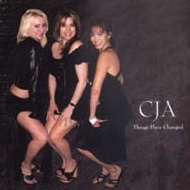
Classical crossover group CJA (pronounced see-jay) consists of Joanne Jolee (vocals and keyboard and her three daughters, Christine (violin), Leiticia (vocals and violin) and Krystle (vocals and cello). CJA's musical style is an alchemic blend of European pop, fused with the likes of J.S. Bach and Scarlatti, Celtic folk songs, traditional Irish fiddling and spiritual and poetic influences, as well as disco, opera and techno-industrial elements.
- CJA (drums: Bill Jaffa, piano and vocals: Joanne Jolee, violin: Christine Adkins, violin and vocals: Leiticia Pestova, cello and vocals: Krystle Delgado) 'Things Have Changed'
- Title: Kissings: lyric - 'Love's Philosophy' by Percy Bysshe Shelley (1792-1822), music - La Folia, 16th Century
- Released 2006 by Pinnacle American Records compact disc LCC 837101274555
- Duration: 4'52"
- Recording date: unknown
- More information about Joanne Jolee and about this recording you can find at http://www.joannejolee.com/joannejolee-Kissings.htm
Collector of music. Was an excellent dancer and violinist so most probably the La Folie d'Espagne was intended for two violins.
 |
La Folie d'Espagne in 26th Recueil de Contre-danses et Waltzes. page 20 and 21 |
| Opening of La Folie d'Espagne | Published ca. 1810 |
|---|---|
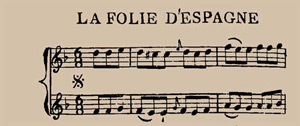 |
|
- Clarchies, :Louis-Julien
- Title: La Folie d'Espagne
- Published in 25th Recueil de Contre-danses et Waltzes, page 20 and 21
- Published by Fr`re, Paris, n.d. [ca.1805-1815]
- Published in ILSMP 2013 by Pierre Chepelov
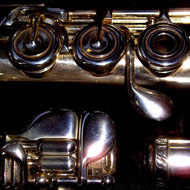
 |
Somalia in pdf-format, size 37 Kb |
Somalia by Gintonic |
This is a composition I've made for my jazz-rock band Gintonic. It's based on the Follia (the Intro is the Pasamezzo Antiquo). It's very recent so I don't hace still the audio. I hope i will send you in a couple of months. I play flute and EWI in the jazz-rock band Gintonic.
Although I play mainly jazz - rock by now, my beginnings in music were in the field of early music. I have play many sets of variations upon the Folia (Vivaldi, Marin Marais...) with the recorder. I think the Folia and the Blues (as schema, the 12 measures) are the major cathedrals in music. I've write this music as a reaction to the human disaster in Somalia (the last 3 letters are the same -lia)
Of course, It's possible to publish the sheet music in your website.
Somalia is based on this schema:
Intro: 8 bars (Pasamezzo antiquo)
Theme: Folia (Am7 - E7#9 - Am7 - G9 --- CMaj7 - G9 - Am7 - E7#9 --- Am7 - E7#9 - Am7 - G9 --- CMaj7 - G9 - Am7-E7#9 - Am7) 2 times
Guitar open solo (E7#9)
Intro: 8 bars (P.A.)
Theme: Folia 2 times
Flute solo: second half of Folia many times
All the chords are "jazzified" i.e. (instead of Am-E-Am-G, I've write Am7-E7#9-Am7-G9) but the chord progression of the main theme is the Folia in A minor.
In the future I will send you the link of YouTube with this music.
- Clavell Larrinaga, Mario
- Title: Somalia
- Published 2012 by Mario Clavell Larrinaga for Gintonic (Mario Clavell Larrinaga - flute, Ramón Escobar - guitar, Dabid Martín - fretless bass, Gorka Díez - drums)
- Duration: 3'55"
- Sheet music 1 page (just the framework of the tune for improvisation)
- More about Mario Clavell and Gintonic at http://www.myspace.com/gGintonic4t
- Cardoso, Jorge (guitar) 'Tanidos, Musica Barroca Española'
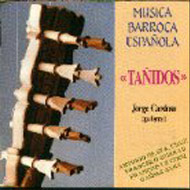
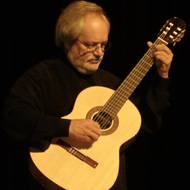

The complete theme and variations as played by the maestro Jorge Cardoso
Duration: 13'23", 15.6 MB. (160kbs, 44100Hz)
© Jorge Cardoso 1988, used with permission- Title: Folies d'Espagne
- Released 1988 by TecnoSaga vinyl MSD 4004 and re-released 1992 by Several records 2-cdset
- Duration: 13'23"
- Recording date: 1988 at Several records, Madrid, Spain
- Prix du Ministère de la culture Spain in 1991
- More about this piece in the French language at http://www.vlamarlere.com/article-20067786.html
- More about this maestro on the guitar at http://guitarreando.iespana.es/cardoso.htm
- Cicero, Rosario (baroque guitar) 'Danzas de Rasgueado y Punteado'
 Rosario Cicero (translated by Andrea Manchée) wrote for the slipcase:
Rosario Cicero (translated by Andrea Manchée) wrote for the slipcase:
It's in the Folies d'Espagne by Le Cocq that we find a compendium of the language of the baroque guitar, in an aesthetic and idiomatic synthesis of the subdued and rarefied folk influences, the peculiarities of a more elaborate performing technique and the profound expressive idiom of musical culture in the baroque era.
- Released 1999 by Nìccolò Guitart collection, Italy compact disc NIC 1009
- Duration: 8'26"
- Recording date: February 1999 at Jambling Studios - Nola (Na), Italy
- Cicero, Rosario (baroque guitar) 'Danzas de Rasgueado y Punteado'
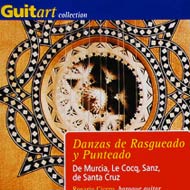
- Released 2002 by GuitArt (magazine), Italy compact disc GUIT 2028
- Duration: 8'26"
- Recording date: February 1999 at Jambling Studios - Nola (Na), Italy
- Mirarchi, Francesco (baroque guitar)

Live performance by Francesco Mirarchi
Duration: 3'44" direct link to YouTube
© 2013 by Francesco Mirarchi- Released May 2013 by liberiamolabellezza for YouTube
- Duration: 3'44" (abbreviation)
- Recording date: 2013
- Recueil des pieces de guitarre, p. 74-81 (facsimile publication)
- Published by: Thesaurus musicus. Brussells: Edition Culture et Civilisation
- Year: 1979
- Storms, Yves (guitar) 'Variations Folia de España'
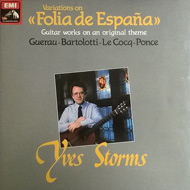 Peter Pieters wrote as introduction to Folies d'Espagne on the inside
of the cover:
Peter Pieters wrote as introduction to Folies d'Espagne on the inside
of the cover:
In Baroque times, no melody or chord schema was more often used in variations than the Folly from Spain. Incontestably, Corelli's «La Folia» is the most famous, but even ].S. Bach used the theme' in his «Peasant Cantata».
Originally, the Folly was a wild dance, in which men in carnival costume often ~eached a state of hysterical trance. The Church did not approve and as a result the Folly was gradually transformed into the slow, solemn melody we know today
The Folly was extremely popular among baroque guitar players, to the point that Robert de Visee - almost alone in not publishing one - felt it necessary to write in his introduction: «Neither will one find here the Spanish Folly. So many of these are now to be
heard, that I could only repeat the follie of others».
There is not the space here to list all the Follies written for the Baroque Guitar, but the three collected on this record are among the most beautiful: that of the Spaniard F. Gereau, the Brussels-born F. Le Cocq and the ltalian A.M.B. whose works have been neglect to this day.
In later times as well, guitar players have shown their partiality for the Spanish Folly and the two greatest guitar composers of the 19th Century, Fernando Sor and M. Giuliani, wrote variations on these themes. In our own times the Mexican Manuel Ponce, who wrote principally for the guitar, also composed some Follies; indeed, his most important work comprises no less than 20 variations followed by a majestic fugue.- Title: Les Folies d'Espagne
- Released 1983 by EMI Belgium 1A 065 1651791
- Duration: 7'30"
- Recording date not mentioned in the documentation
- See also the page Recommended Folia-recordings
- Takeuchi, Taro (5 course guitar) 'Folias!, virtuoso guitar music of
C17th on period instruments'
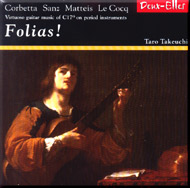 Monica Hall wrote for the slipcase:
Monica Hall wrote for the slipcase:
We are indebted to the Flemish clergyman and amateur guitarist, Jean-Baptiste de Castillion (1680-1753), whose activities as a music copyist have preserved the guitar music of François Le Cocq (fl.1685-1729), Nicolas Derosier (c.1645-1702) and many pieces by Corbetta not found in the surviving printed books. In the preface to the manuscript which he copied in 1730 (B:Bc.Ms.S.5615) Castillion says that in 1729 Le Cocq gave him copies of his music, which he re-copied for his own use, adding pieces by several other composers of the previous century. He says that Le Cocq taught the guitar to the wife of the Elector of Bavaria and refers to him playing to the sister of the Archduke Charles of Austria, later emperor Charles VI. This was probably Maria Antonia, a half-sister of Charles, who married the Elector Maximillian II Emanuel in 1685 and died in 1692. In 1729 Le Cocq is described as a retired musician of the Chapel Royal in Brussels. His variations on Folies d'Espagne is a technical tour de force featuring the 'harpegemens', elaborately arpeggiated chords, which were a jealously guarded secret of Le Cocq's. Castillion says that he rarely indicated them in his music so as to conceal how he played them and to preserve them to himself alone.
- Title: Folies d'Espagne
- Released 2002 by Deux-Elles Limited, Reading, UK compact disc DXL 1030
- 5 course guitar by Martyn Hodgson , Leeds 1982 after René Voboam, Paris, 1641. he original is in the Hill Collection, Ashmolean Museum, Oxford
- Duration: 10'01"
- Recording date: April 16 and 17 at St Martin's Church, East Woodhay, England
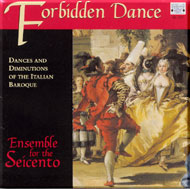
This piece for one voice is listed as 'Follia' in the Tavola dell'arie at the end of the volume.
- Ensemble for the Seicento 'Forbidden dance, dance and diminutions of
the Italian Baroque'
- Title: Lauda Spirituale/Folias di Spagna (improvisations)
- Released 2001 by Musicians Showcase Recordings compact disc MS 1073
- Duration: 7'40"
- Recording date: January 2000 at St. Paul's Episcopal Church Brooklyn New York and January 1998 at Calvary Church, Parish of Calvary/St. George's, New York City
Oddly enough, the almost identical duet with a partly different text was used more than 70 years later as part of the opera 'La Pastorella Nobile', a production of Pietro Alessandro Guglielmi (1728-1804). The music of the duet was attributed on the title page of the Artaria print to 'Sig(nor). Conti' which might easily lead to Giacomo Conti, the violinist and composer who led the orchestra of the Burgtheater from 1793 but the music is almost identical to the earlier version of Francesco Conti. It is an indication how famous Francesco Conti was in the 18th century (there seems to be only one Sig. Conti, and the musical quality of the duet is indeed extremely high).
John A. Rice wrote in March 2006 about the differences between the duet in 'Don Chisciotte in Sierra Morena' and 'la Pastorella Nobile':
I've just looked at a manuscript full score of 'Don Chisciotte in Sierra Morena' in the Austrian National Library, Signatur Mus. Hs. 17207, published in facsimile by Garland, New York, 1982. The duet on La folia is at the end of act 2; it is entitled "Va pure in buon' ora". It is the same duet as the one inserted much later in Guglielmi's opera, with the following differences:
- In 'Va pure in malora' part of the text is different (but much of the text, including the long string of insults, is the same)
- The duet in 'Don Chisciotte' is in da capo form (A-B-A): the first part of the duet (up to the words 'mai non vi fu') is repeated after the second part (ending with the words 'per me sei tu'). So the duet ends in the same key (D minor) in which it began. In the later version the second A section is omitted, so the duet ends in a key (G minor) different from the key in which it began.
- 'Va pure in malora' ends with a short instrumental passage in G minor that is not in 'Va pure in buon' ora.'
- 'Va pure in buon' ora' begins with a short instrumental passage in D minor that is not in 'Va pure in malora.'
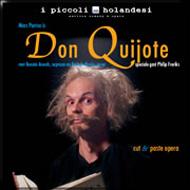
- I Piccoli Holandesi directed by Marc Pantus (with vocals by Anne Grimm, Renate Arends, Ricardo Prada, Marc Pantus)
with some new contemporary songs
- Performance: May 15, 2005 in Muziekgebouw aan 't IJ, The Netherlands
- Duration: 9'09"
- Recorded by De Concertzender, production www.harmonysound.nl

Duration: 0'59", 958 kB. (128kB/s, 22050 Hz)
Anne Grimm, Marc Pantus and the Utrechts Barok Consort conducted by Jos van Veldhoven
© 2005 Marc Pantus, used with permission- Premiere April 27, 2005 in Kampen, The Netherlands
- Duration: unknown
- Recorded by De Concertzender, broadcasted by Dutch Radio 4, Viertakt April 25, 2005
- Akademie für Alte Musik Berlin and Nederlandse Operastichting directed by René Jacobs 'Don Quichotte in Sierra Morena, tragicommedia in five acts, Vienna 1719'
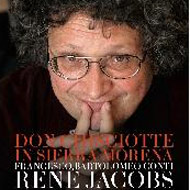 .
.
- Casting duet: Judith van Wanroij (Maritorne) and Marcos Fink (Sancio Pansa).
- Duet at the end of the second act.
- Recording date: June 26, 2010 during the Holland Festival 2010 in the Stadsschouwburg, Amsterdam, The Netherlands
- Broadcasted by NPS radio 4 June 26, 2010 (live broadcasting of performance)
- Akademie für Alte Musik Berlin and Tiroler Landestheater directed by René Jacobs 'Don Quichotte in Sierra Morena, tragicommedia in five acts, Vienna 1719'
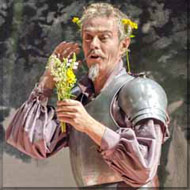
In the program was written:Live performance of Folia parts ending with the famou duet 13 Aug. 2005
Duration: 11'19" direct link to YouTube
© 2011 by Akademie für Alte Musik Berlin
Francesco Conti (1681-1732), now almost forgotten, was a very famous and highly respected composer in his time. The largest part of his life he worked at the imperial court in Vienna. In 1708 he was apointed first theorbo player, in 1713 he became also court composer. After these appointments he became one of the highest paid musicians in Vienna, who was able to perform his own works with the best singers, since he could pay them well. After falling ill in 1726 he returned to Italy, but in 1732 he returned to Vienna to introduce some new works. It is an indication of his reputation that his successor as court composer, Antonio Caldara, had to step aside to make place for Conti. Shortly thereafter Conti died.
The focus of the the 29th Innsbruck Festival of Early Music was the era of the Viennese Court Opera. Directed by René Jacobs, the opera "Don Chisciotte in Sierra Morena" was performed five times at the Tiroler Landestheater. National and international audiences and critics alike were enthusiastic about the young vocal ensemble which was accompanied by the Akademie für Alte Musik Berlin.
This work performed was composed for the Carnival season in 1719. It was extremely successful: it was even translated into German, and was performed 25 times outside Vienna, mainly in Hamburg. Don Chisciotte in Sierra Morena is a tragicommedia, which combines elements of the opera seria and the intermezzo (a form of comedy which was performed in between the acts of the opera seria as a form of compensation for the disappearance of all comic elements from the opera seria). It not only combines these elements, but also ridicules some elements of the opera seria. The way Conti portrays Don Quixote and Sancho Pansa in particular is brilliant. Don Quixote, a puffed so-called knight, who believes that he is a hero, and doesn't want to see the truth, even if it is right under his nose.
In Conti's time, Don Chisciotte lasted about 5 hours.
In Conti's time, Don Chisciotte lasted about 5 hours. Thusly, cuts were made in this performance which consumes just over 3 hours.- Casting duet: Fulvio Bettini (Sancio Pansa) and Gaêle Le Roi (Maritorne).
- Duration: Act 1: 8'40" instrumental and duets (55'53"), Act 2: 0'43" one instrumental variation (60'05") , Act 3: 1'52" three instrumental variations for concluding the act (42'20")
- Recording date: August 13, 2005 during the 29th Innsbruck Festival of Early Music 2005 Tiroler Landestheater, Innsbruck (the performance was also August 16, 22, 24, 26 at the festival)
- Broadcasted by unknown radio-station and posted in the newsgroup alt.binaries.sound.mp3.classical March 2006
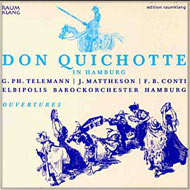
- Elbipolis Barockorchester Hamburg 'Don Quichotte in Hamburg'
Jörg Jacobi wrote for the slipcase:
[...] Such conversations bore Don Quixote and especially Sancho Panza. They leaf through the music of Conti's opera, which he had brought with him. "Look, my dear Sancho, just look at this! Indeed, how marvelously our story is told," exclaims Don Quichote, " how wonderfully fresh the music - I like it! And it also has real Spanish character, even a follia!" Grumbling to himself he recalls the evening's opera performance of this miserable piece of work by Mattheson: "Granted, the music is nice, but the story is not at all the right thing for a Spaniard. here, on the other hand: A follia! A chaconne! A Ballo de Pagarellieri, a ballet of the squires, like Mr. Conti has composed it - this is something that is knightly and would certainly also please my Dulcinea!"
- Released 2005 by Raumklang compact disc RK 2502
- Duration: 2'20"
- Recording date: May 8-12, 2005 in 14943 Schönefeld/Marzahna
| Opening of Conti's Folia | Artaria publication for the opera La pastorella nobile |
|---|---|
 |
|
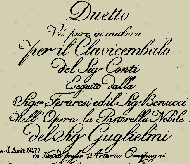 John A. Rice wrote about this piece:
John A. Rice wrote about this piece:This is a printed keyboard vocal score of a duet composed by Conti used for the first Viennese production of Guglielmi's comic opera La pastorella nobile. The singers were Adriana Ferrarese (the first Fiordiligi in Mozart's "Cosi fan tutte") and Francesco Benucci (the first Figaro and Don Alfonso). The entire duet is based on La Folia; the text is probably by Lorenzo da Ponte. The first Viennese production of "La pastorella nobile" is discussed in my dissertation "Emperor and impresario: Leopold II and the transformation of Viennese musical theater, 1790-1792"
In the dissertation John A. Rice writes (p. 125):[...] Also added to the Viennese version in place of the recitative in the original was the duet for D. Florida and D. Polibio, "Va pur in malora," attributed in the Artaria print to one "Sig. Conti." (It is not clear that this duet was in fact sung as part of Guglielmi's opera. The text appears in the 1790 libretto, but a note at the end of the libretto informs us that the duet was omitted in performance; yet Artaria issued a keyboard reduction of the duet and described it as "eseguito dall Sigra. Feraresi ed il Sigr. Benucci nell'Opera la Pastorella Nobile.")
- Ms. score in A Wn, K.T. 338 (A-Wn is the RISM siglum for Austria, Wien,
Nationalbibliothek, Musiksammlung. RISM stands for Receuil International
de Sources Musicales; there is a list of RISM sigla at the beginning of
every volume of the New Grove Dictionary of Music.
K.T. 388 is the call number (signature) of the manuscript; K.T. stands for Karntnertortheater, where the manuscript was kept before being transferred to the Nationalbibliothek).
- Published by Artaria in Vienna during the second half of 1790 (Racolti d'Arie No. 77)
- Duration: ca. 4'00"
- size 29 x 21 cm, 14 pages
Méthode de guitare pour apprendre seul à jouer de cet instrument, nouvelle édition, corrigée et augm[entée] de gammes dans tous les tons, des Folies d’Espagne avec leurs variations,….
- No published music found.
- Published in Fétis, François-Joseph, Biographie universelle des musiciens…, tome 2, 2e édition, Paris, 1866, p. 356
- Thanks to François-Emmanuel de Wasseige for detecting this item in literature
Opus V (Sonate a Violino e Violone o cimbalo) was first published in Rome on the 1st. January 1700, closely followed by publication in Bologna, Amsterdam (Estienne Roger) and London (John Walsh).
This work has remained a favorite among violinists because of the variety of technical challenges the variations offer to the player. They were extremely popular when they first appeared, and firmly established the composer's international reputation appearing in over a dozen different editions during Corelli's lifetime. Less than a hundred year after the first publishing, there had been at least 40 printings and more than 20 revised editions. Delphine Alard and Ferdinand David published performing editions in 1863 and 1867 respectively, but the arrangement by the Belgium violinist Hubert Léonard in 1877 firmly established the work as a mainstay in the repertoire of violinists. The arrangement for recorder was published in 1702 by Walsh & Hare of London as part of 'Six solos for a flute and bass'.
Geminiani who was a pupil of Corelli published a concerto grosso based upon Corelli's Op. 5 no. 12 and Veracini made his own arrangement for violin and basso continuo. Both composers introduced the Italian style in England. Vivaldi's Folia Op 1 no. 12 is another tribute to Corelli and the name Rachmaninoff gave to the title of his Folia ('on a theme of Corelli') leaves no doubt about his source for inspiration.
Marc Pincherle wrote about the Corelli-variations:
An effort to minimize inevitable monotony is discernible
in the set of 23 variations, particularly by giving to the accompaniment
as active a role as possible. Several times in the 3rd variation and in
the 16th the same designs are exchanged between melody and bass. Sometimes
this reciprocity operates between groups of two variations; for example,
between the 4th and 5th, 6th and 7th, 20th and 21st. Still more
revealing is the manner in which the ostinato of the bass is now and then
halted. The harmonic framework of the 14th is new, likewise that of the
19th, which is in imitation with supple modulations and that of the 20th,
which cadences in F while the 21st variation traverses the reversed key
sequence. Finally, an elongation by four measures at the close of the last
phase attests, by itself, to Corelli's desire to evade customary routine
and to invest a somewhat naive architecture with a degree of nobility.
But there is no doubt, as is evident from a cursory reading of the follia
that in Corelli's eyes its interest was of a violinistic order before all
else. Everything he knew about the matter of instrumental technique, which
he had scattered throughout Opus V, and the device of variation, enabled
him to concentrate, to classify, and to demonstrate with precision in a
veritable corpus of doctrine. By technique, that of bowing should be understood;
for as regards to the left hand, Corelli's role, (.....),
far from being constructive, was limited to 'pruning'.
 |
Duration: 5'16", 40 kB. |
 |
Duration: 7'03", 47 kB. |
 |
Duration: 8'56", 59 kB. |
| Theme of Violin Sonata in d minor La Follia | arr. for violin and b.c. |
|---|---|
 |
|
 |
The complete score of la Folia opus 5 no. 12 |
- Accademia Bizantina directed by Ottavio Dantone 'Arcangelo Corelli, violin sonatas Opus 5'

- Title: Sonata No. 12 In Re Minore, 'Follia'
- Released November 2006 by Label: Blue Libe / The Orchard compact disc
- Duration: 11'02"
- Recording date: unknown
- Accademia Bizantina directed by Ottavio Dantone 'Arcangelo Corelli, sonate per violino e basso continuo Op. V'
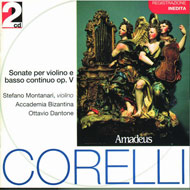
- Title: Sonata No. 12 In Re Minore, 'Follia'
- Released 2003 by Amadeus compact disc 169-2 (2 cd-set)
- Duration: 11'05"
- Recording date: unknown
- Accardo, Salvatore (violin) Beltrami, Antonio (piano) 'Corelli, Porpora, Tartini, Vivaldi sonatas'

- Title: Sonata Op. 5 N. 12 in Re minore 'La Follia'
- Released by RCA original early 60's Italian pressing (promo white label) LP ML-80
- Duration: unknown
- Recording date: unknown
- Alard, Delphin and Meyer edited the music for viola and bassso continuo
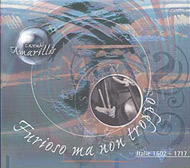
- Title: Sonate d-Moll, op. 5/12
- Published by Schott
- Score 18 p.
- Publisher No. VAB8
- Ensemble Amarillis: Gaillard, Héloïse (recorder), Cochard,
Violaine (harpsichord), Gaillard, Ophélie (cello) 'Furioso ma non
troppo, Italie 1602-1717'
- Title: La Follia
- Released 1999 by Ambroisie compact disc AMB 9901
- Duration: unknown
- Recording date: August 1998 in la fondation Tibor Varga, Sion
- Angelloz, Guy (flute), Batselaere, Arnold (organ) 'Flute et orgue a
Notre-Dame de Paris'
- Title: Arcangelo Corelli: La Follia
- Released 1985(?) by Pierre Verany compact disc PV 785094
- Duration: 4'55" (booklet indicates 4'49")
- Recording date: April 10 & 11, 1985 in the Notre-Dame of Paris
- Anonymous transcription for large orchestra (c. 1802)
John A. Rice wrote about this transcription in 'Empress Marie Therese and Music at the Viennese Court, 1792-1807' page 67-68:
Marie Therese had at her disposal many wind and brass players, whom she sometimes brought together in orchestras that must have made a brilliant and colorful sound. Her concert on 18 July 1802 ended with what she referred to as "Die Follia di Spagna mit allen Instrumenten von Eybler." Eybler is not known to have composed such a work (footnote 66: No orchestral variations on La Follia by Eybler are listed in Hermann [= Hildegard Hermann, Thematisches Verzeignis der Werke von Joseph Eybler, Munich, 1976]). But she owned, under the title Follia a più strumenti, an anonymous orchestral transcription of the variations on La Follia from Corelli's violin sonatas, Op. 5 (CaM, p. 62; see Fig. 1.3), which the diary allows us to attribute to Eybler. The orchestral parts call for (in addition to strings) pairs of flutes, oboes, clarinets, bassoons, horns, trumpets, and timpani (footnote 67: A-Wgm, XIII 29392).
- Title: Follia a più strumenti (or in the diary of Marie Therese: Die Follia di Spagna mit allen Instrumenten von Eybler
- Source: A-Wgm, XIII 29392 according to Pohl (Austria, Vienna, Gesellschaft der Musikfreunde, call-number (signatur) XIII 29392
- Assassin's Creed Unity (video game)
Assassin's Creed Unity at 20'14" and further
Duration: 36'55" direct link to YouTube
© 2014 by Xari et Jiji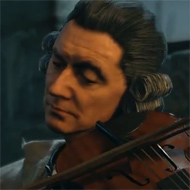
Le Lutin d'Ecouves wrote about the use of the Corelli Folia:
I had detected a little part of Corelli's Follia played with the solo violin in the Bastille in the video game "Assassin's Creed Unity (2014). Theme at 22:09 of this video and a variations at 23:35 to 26:53.
- Performer(s) unknown
- Title: Assassin's Creed Unity (video game)
- Released 2014
- Recording date:unknown
- Arita, Masahiro (flute), Bach-Mozart Ensemble Tokio 'Italian Baroque
flute music'
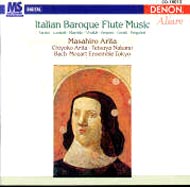
- Title: La Follia e-moll for traverse flute and basso continuo Op. 5 No. 12 (d klein)
- Released 1996 by Denon compact disc CO 18013
- Duration: 10'41"
- Recording date: January 20-23, 1996 in Akigawa Kiarara Hall, Tokyo, Japan
- L'Astrée ( Francesco D'Orazio violin, Alessandro Tampieri violin and baroque guitar, Alessandro Palmeri cello,
Francesco Romano theorbo, Giorgio Tabacco harpsichord)
- Title: Sonata "La Follia" per violino e basso continuo op.V n.12, Tema, Variazioni I - XXIII
- Broadcasted by RAI radio 3 (Italy) April 3 and October 30, 2005
- Duration: 10'24"
- Recording date: unknown at Cappella Paolina del Palazzo del Quirinale di Roma, Italy
- Autumn, Emilie (baroque violin) 'Laced, unlaced'
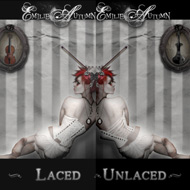
- Title: La Folia
- Released 2007 by Trisol Music Group 2 cd-set TRI 294
- Duration: 10'18"
- Recording date: unknown
- Autumn, Emilie (baroque violin) 'Laced, unlaced'
- Title: La Folia Live
- Released 2007 by Trisol Music Group 2 cd-set TRI 294
- Duration: 9'25"
- Recording date: unknown
- Balestracci, G.(viola da gamba), Pandolfo, P. (viola da gamba), Nassilo,
G (cello) Còntini, L. (arch lute) & Raschitti, M. (harpsichord)
'Arcangelo Corelli, Sonata per viola da gamba and basso continuo Opus
V, Vol II'
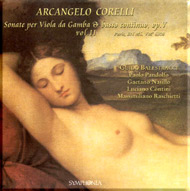
- Title: Follia
- Released 2002 by Symphonia compact disc 8 012783 011892
- Duration: 12'10"
- Recording date: October 2001 in Pieve di Tre Colli, Pisa, Italy
- Belder, P-J.(recorder), Schiffer, R. (baroque cello) & Stinder,
H. (harpsichord) '17th and 18th Century chambermusic'
- Title: Variationen über La Follia, opus 5, Nr. 12.
- Released 1992 by Erasmus compact disc WVH 058
- Duration: 11'04"
- Recording date: November 1991 in the Lutherse Kerk, Breda the Netherlands
- Belder, Pieter-Jan (recorder), Rainer Zipperling, Rainer (cello/viola da gamba) & Delft, Menno van
(harpsichord) 'The Art of the Recorder, Die Blockflöte - Pieter-Jan Belder'
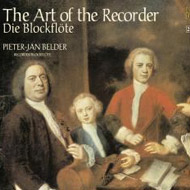
- Title: 'La Follia' for recorder and basso continuo (opus 5 n.12)
- Released 2004 by Brilliant Classics compact disc 92460
- Duration: 11'01"
- Recording date: unknown
- Benoist, Andree 'Piano Roll: La Folia, accompaniment only'
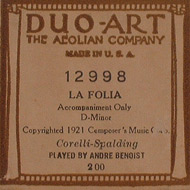
piano roll, 1921
Click picture for magnification- Title: 'La folia in D minor' by Corelli in an arrangement by Spalding, accompaniment only
- Released 1921 by Duo Art, The Aeolian Company 12998, made in the USA
- Duration: unknown
- Recording date: unknown
- Besset, Serge and ensemble 'd'apres La Follia de Corelli'
See Besset, Serge (composers letter B)
- Bezverkhny, Mikhail (violin) 'Yuri Korchinsky and Mikhail Bezverkhny: Musical Tournament'
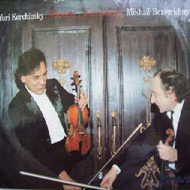
- Title: 'La folia'
- Released 1990 by Melodiya LP C90 29537 002
- Duration: unknown
- Recording date: 1988
- Bianchini, Chiara (Baroque violin), Darmstadt, Gerhat (Baroque cello), Gross, Alfred (harpsichord) 'Italian violin music 1600-1750'

- Title: La Folia op. 5/12
- Released 1986 by Edition Open Window Red-White, LP OW 002
- Duration: 10'50"
- Recording date: unknown
- Bobesco, Lola (violin) 'Lola Bobesco violin plays Bach and Mozart'
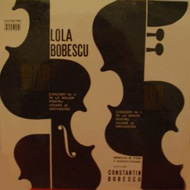
- Title: Sonata in Re Minor Op. 5 No. 5 (? instead of No. 12) 'La Follia'
- Released in the 1970's by Electrecord ( Romania ) White Label lp ECE 0844
- Duration: unknown
- Recording date: unknown
- Bohren, Sebastian (violin) 'La Folia'
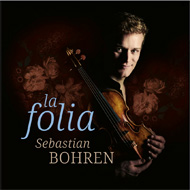 In the slipcase was written by Tully Potter (Übersetzung Anne Schneider):
In the slipcase was written by Tully Potter (Übersetzung Anne Schneider):
Und wie könnte man die Stärken der Guadagnini besser demonstrieren mit diesem Album mit barocken Arrangements? Es geschah, als er einen YouTube-Clip von Ida Haendel sah, die Corellis La folia-Variationen (die 12. seiner Sonaten, op. 5) aufführte. „Sie spielte diese erstaunliche virtuose Kadenz. Ich fragte meinen Kollegen Daniel Kurganov, was das sei, und er meinte, die Kadenz stamme von Hubert Léonard.“ So entstand das Konzept eines ganzen Programms, das das Ethos von La folia widerspiegelt, das ohrenkitzelnde Thema, das Komponisten wie Lully, Corelli und Marais, Alessandro Scarlatti, Geminiani, Boccherini und sogar Rachmaninov fasziniert hat.
- Title: Violin Sonata in D minor Op.5 No.12 'La Folia'
- Released 2022 by AVIE 2513
- Duration: 11'28"
- Recording date: 2021
- Bova, Aldo (recorder) and Stolz, Ernst (organ )
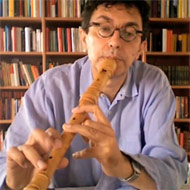
Duration: 5'45" direct link to YouTube
The first part as played by Aldo Bova & Ernst Stolz
© 2009 Aldo Bova & Ernst Stolz, used with permissionDuration:6'26" direct link to YouTube
The second part as played by Aldo Bova & Ernst Stolz
© 2009 Aldo Bova & Ernst Stolz, used with permission- Title: La Follia by Arcangelo Corelli
- Published at YouTube August 2009
- A distance collaboration between the two musicians
- More about Ernst Stolz you can read at " http://www.ernststolz.com/ernststolz.htm
- Bratza, Milan (violin) and Vrederic Jacsicas (harpsichord) 'The historic Violin'
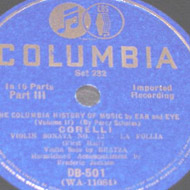
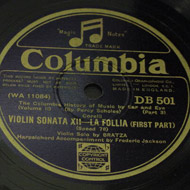
- Title: Sonata No 12 'La Follia'
- Released in 1930s Columbia Masterworks Music Appreciation 78 set. It is originally from Columbia's History of Music by Eye and Ear, Volume 3.
- Duration: unknown
- Recording date: 1930s
- Bress, Hyman (violin) 'The Violin: Vol. 1' (accompanied by the piano)

- Title: La Folia
- Released 1962 by Folkways Records LP FW03351, nowadays Smithsonian Center for Folklife and Cultural Heritage
- Duration: 8'13"
- Recording date: not mentioned in the documentation
- Brink, Robert (violin) and Pinkham, Daniel (harpsichord) 'Arcangelo Corelli, sonatas for violin and harpsichord, opus 5 Volume 1'
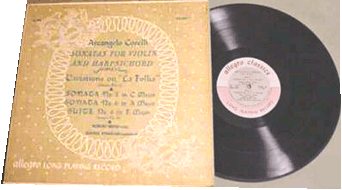
In the documentation was stated:La Follia has proved the most popular and is the oldest permanent classic of the virtuoso's repertoire. It was a favorite with the 19th Century performers who added luxuriant accompaniments and spectacular cadenzas. In the original form, as recorded here, it consists of twenty-three variations for violin and harpsichord on the theme of an old Portuguese dance. The dance was originally accompanied by tambourines and performed by men dressed in women's clothes who acted so wildly that they appreared to be out of their senses, hence the title 'Follia' meaning 'Madness'
This tune was used in vocal music by Steffani and Milanuzzi. In harpsichord solo variations by d'Anglebert, François Couperin (Les Folies Françoises), Alessandro Scarlatti, and Pasquini. And in an organ setting by Cabanilles. J.S. Bach employed it in the ' Peasant Cantata' (record Allegro alg-82). It is found in works by Gretry (in the Opera 'L'Amant Jaloux') and in 'The Beggar's Opera' to the words ' Joy to Great Ceasar'. Other composers who made use of La Follia include François Farinel, whom Corelli met in Hannover around 1680, Lully, Frescobaldi, Marais, Pergolesi, Vivaldi, Keiser, Cherubini, Liszt, and even Rachmaninoff (in his Variations on a theme by Corelli, Opus 42).- Title: Variations on 'La Follia' (Sonata No. 12)
- Released in 1951 by Allegro LP AL 109
- Duration: 12'28"
- Recording date: January 1951 in Boston, USA
- Brüggen, Frans (recorder), Bylsma, Anner (cello) & Leonhardt,
Gustav (harpsichord) 'Italienische Blockflotensonaten um 1700'
Andrea Lausi wrote about recorder-music in general and in particular the Brüggen-Bylsma-Leonhardt-trio (used with permission, 2005):
I have always considered the anthologies issued by the Brüggen-Bylsma-Leonhard trio for Telefunken (Italian Recorder Sonatas, Blockflötenmusik auf Originalinstrumenten...) among the key recordings of the ‘70s. Veritable chamber music lesson, these recordings shaped the perception of the recorder as a musical instrument for many years to come. What I find central to this is the quality, so-to-say the real magic, of Brüggen’s sound. The recorder is an instrument with a particular limited amount of overtones – it is actually a good approximation to a sonic laser with all the energy concentrated in the fundamental – and Brüggen’s playing puts this quality at the center of his constant focus. A playing where the center of the tone is never missed, the sound being always direct and full. These qualities blend with the play of other two musicians in interpretations of a simple nobility, where the 'abstract' timbre of the recorder – the quality Brüggen once defined as its 'dangerous innocence' – appears perfectly functional in putting in evidence all of the curves and shapes of the compositional architecture.
The Brüggen-Bylsma-Leonhard series included also a very impressive rendition of the Follia and, given such an overwhelming example to confront with, I have been always surprised that in the past years so many recorder players recorded the piece, which after all is definitely not a piece composed originally for the recorder. [...] and I find the Cavasanti-Guerrero-Erdas reading to be perhaps the first to cope with the mastery of BBL example. [...]- Title: Variationen über La Follia, opus 5, Nr. 12.
- Released 1968 by Telefunken LP SAWT 9518-A Series: Das Alte Werk
- Recording date: February 1967, Bennebroek Holland
- Brüggen, Frans (recorder), Bylsma, Anner (cello) & Leonhardt,
Gustav (harpsichord) 'Italian recorder sonatas'
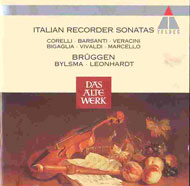 Ulrike Brenning wrote about La Follia as introduction for this recording:
Ulrike Brenning wrote about La Follia as introduction for this recording:
The work differs only in points of detail from the versions for violin and demands a high degree of technical competence on the part of its performance, since Corelli, an accomplished violinist, conceived the work as a virtuoso bravura showpiece. The folia or ostinato bass, after which the piece is named, is a solemn, weighty theme that is subjected to a total of twenty-one variations to produce a veritable fire-work display of ideas.
- Title: Variations on 'La Follia' Opus 5 No. 12 in G minor
for treble recorder and basso continuo from Sonatas by Arcangelo Corelli,
his V Opera London (Walsh) 1702.
- Released 1995 (prod. 1968) by Teldec compact disc 4509-93669-2 Series: Das Alte Werk
- Recording date: February 1967, Bennebroek Holland
- Duration: adagio 1'14" allegro 2'15" adagio 0'39" vivace 0'21" allegro 0'12" andante 0'30" allegro 0'41" adagio 1'25" allegro 2.49"
- Title: Variations on 'La Follia' Opus 5 No. 12 in G minor
for treble recorder and basso continuo from Sonatas by Arcangelo Corelli,
his V Opera London (Walsh) 1702.
- Brüggen, Frans (recorder), Bylsma, Anner (cello) & Leonhardt,
Gustav (harpsichord) 'Frans Brüggen Vol 2', Recorder works by 10 Italian composers
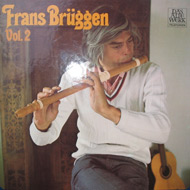 In the lp-box is written about La Follia as introduction for this recording:
In the lp-box is written about La Follia as introduction for this recording:
Corelli's variations on La Folia, from the beginning of the 18th century the composer's most famous work, were originally written for violin and figured bass and constitute, in this version, the last of the twelve 'Sonate a violino e violone o cimbalo', which first appeared in Rome with the superscription of 1st January 1700, and by 1720 saw no fewer than twenty reprintings, above all in Amsterdam and London.The present version for recorder (in which the only simplifications are of technical peculiarities like the chords or double-stopping of the violin version) had already been published in 1702 by Walsh in London. The imaginative title 'La Folia' (Walsh wrote 'La Follia') denotes nothing more than that the work is constructed on the bass pattern known as a 'folia', which first emerged in Spanish and Italian music in the early 16th century as a bass (i.e. as a harmonic framework) for vocal and instrumental movements, and thence, partly also combined with more or less fixed or varied upper melodic part, set out on its victorious path through Europe. In the instrumental music of Corelli's time, particularly in the sets of variations, this pattern atteined its richest flowering - not only Corelli himself, but also Pasquini, d'Anglebert, Cabanilles, Marais and Alessandro Scarlatti wrote sets of variations on La Folia, in so doing giving free rein to their imagination, particularly from the point of view of technique.
Corelli's 'sonata' is planned as a sequence of a theme and 21 variations. The theme preserves, along with the traditional 3/4 measure, the traditional descant melody and its sarabande character; thereafter movement and melodic figuration are increased from variation to variatio, and rhythm, tempo and compositional technique constantly changed, while the harmonic movement and its symmetric organisation (4 + 4, 4 + 4 bars, both halves repeated) remain firmly fixed. The frequent recurrence of long phrases building up from grave crotchet movement in sarabande rhythm to virtuosic semiquaver figurations in the separate movements gives the work its inner coherence and its accompanying dynamics; the abundance of ingenious melodic and constructional ideas and the extraordinary technical demands lend it that range of colour and that air of fantasy which already fascinated its contemporaries and made the work so uniquely famous.- Title: Variationen über 'La Follia' für Blockflöte in f' und B.c, op. 5, Nr. 12
- Released 1974 by Telefunken, Das alte Werk 3 lp-box 6.35073(-00-501)
- Duration: 10'10"
- Recording date: not mentioned in the documentation of the lp-set
- Alt-recorder in f', copy after P.I. Bressan built by Martin Skrowroneck, Bremen, Germany, 1966
- Brüggen, Frans (recorder), Bylsma, Anner (cello) & Leonhardt,
Gustav (harpsichord) 'Italian Recorder Sonatas'
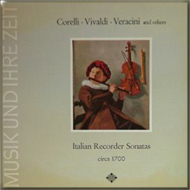
- Title: Variations on 'La Follia' for recorder in F and continuo Opus 5 No. 12
- Released by Telefunken vinyl SAWT 9518-A EX, re-released 1994 by WEA/Elektra compact disc 4509 93669-2
- Duration: unknown
- Recording date: February 1967
- Brüggen, Frans (recorder), Bylsma, Anner (cello) & Leonhardt,
Gustav (harpsichord) 'Arcangelo Corelli, Sonatas Op. 5 No 7-12 La
Follia'
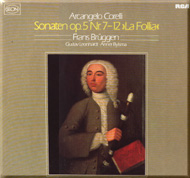
- Released by RCA SEON Red Seal LP RL 30393
- Duration: 9'30"
- Recording date: September 1979/March 1980 in De Lutherse Kerk, Haarlem
- Brüggen, Frans (recorder), Bylsma, Anner (cello) & Leonhardt,
Gustav (harpsichord) 'Arcangelo Corelli, Sonatas Op. 5 No 7-11 and No 12 La
Follia'
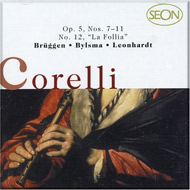
- Released 1990 by RCA SEON Red Seal compact disc
- Duration: 9'30"
- Recording date: September 1979/March 1980 in De Lutherse Kerk, Haarlem
- Brüggen, Frans (recorder), Bylsma, Anner (cello) & Leonhardt,
Gustav (harpsichord) 'Corelli's Sonatas Op. 5 No 7-12 La Follia'
- Released by RCA Victor Red Seal compact disc EURO RD 71055 (not available in North America).
- Duration: 9'30"
- Recording date: September 1979/March 1980 in De Lutherse Kerk, Haarlem
- Brüggen, Frans (recorder), Bylsma, Anner (cello) & Leonhardt,
Gustav (harpsichord) 'The art of the recorder'
- Title: La Follia, allegro
- Released 1995 by Teldec compact disc, Das Alte Werk 4509-99030-2
- Duration: 2'49"
- Brüggen, Frans (recorder), Bylsma, Anner (cello) & Leonhardt,
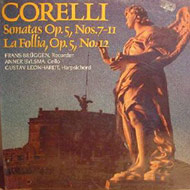 Gustav (harpsichord) 'Corelli, sonatas Op. 5, Nos 7-11, La Follia, Op.
5, No 12.'
Gustav (harpsichord) 'Corelli, sonatas Op. 5, Nos 7-11, La Follia, Op.
5, No 12.'
- Title: La Follia (in g minor)
- Released 1981 by Pro Arte lp PAL 1045, originally released
as Philips LP, and re-issued 1986 Pro Arte compact disc cdd 291 and
Sony compact disc.
- Duration: unknown but less than 9'30"
- Recording date: unknown but not after 1978
- Brüggen, Frans (recorder), Harnoncourt, Nikolaus (viola da gamba)
& Leonhardt, Gustav (harpsichord) 'Blockflötenwerke des Barock'
 David Lasocki wrote about La Follia as introduction for this recording:
David Lasocki wrote about La Follia as introduction for this recording:
The final work in the collection is a set of 23 variations on La Follia, a sixteen-bar ground bass that had been used as the basis of variations for well over a century and had by then picked up an 'accompanying' melody in chaconne rhythm. This is something of a tour de force, particularly in bowing technique.
- Title: Variationen über La Follia für
Blockflöte (in f) und Basso continuo
1) Adagio 2) Allegro 3) Adagio 4) Vivace 5) Allegro 6) Andante 7) Allegro 8) Adagio-Allegro - Released by Telefunken LP SAWT 9560-M Series: Das Alte Werk
- Title: Variationen über La Follia für
Blockflöte (in f) und Basso continuo
- Brunello, Mario (cello) and Battiston, Ivano (accordeon) 'In croce'
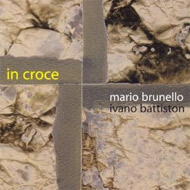
- Title: La Folia (arrangement for cello and accordeon)
- Released 2001 by Velut Luna compact disc order number
- Duration: 9'18",
- Recording date: unknown
- Campoli, Alfredo (violin) and Gritton, Eric (piano) 'Alfredo Campoli plays Mendelssohn'
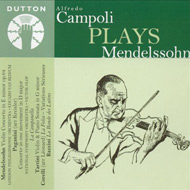
- Title: La Folia - Variations Serieuses
- Edition Hubert Leonard (with cadenza), revised by Issay Barmas, 3/-
- New release of old recording (78 rpm LP K1670-71), released 2002 by Dutton, compact disc CDBP 9718
- Duration: Part 1-4: theme and variations 3'15", Part 5-10: theme and variations 4'07", Cadenza: 4'15"
- Recording date: May 22, 1947 in Kingsway Hall, London
- Carolina Pro Musica 'Bridges from Europe to Peru'
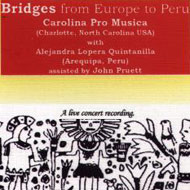
- Title: La Folia, Opus 5 No. 12
- Released by Carolina Pro Musica
- Duration: unknown
- Recording date:February 11, 2001 at St. Martin's Episcopal Church, Charlotte, NC, a live concert recording
- Cartier, J.B. edited the music for violin and piano
- Published by H. Lemoine c.1911
- Score 13 p. and 1 part, 36 cm
- Series: Maitres italiens du violon au XVIIIe siecle, Edition J. Jongen et Joseph Debroux
- Cavasanti, Lorenzo (alt-flute in f), Guerrero, Jorge Alberto (cello), Erdas, Paola (harpsichord)
'Lo Specchio Ricomposto (the mirror recomposed)'

Gilles Cantagrel wrote for the slipcase: (translation by Christopher Cartwright and Godwin Stewart):
Duration: 0'54", 848 kB.( 128kB/s, 44100Hz)
The opening of Opus 5 nr. 12 as played by Cavasanti, Guerrero and Erdas
© Cavasanti, Guerrero and Erdas 2004, used with permission - Title: La Follia Op.5/12
- Released July 2004 by Stradivarius compact disc STR 33684
- Duration: 10'21"
- Recording date: August 8-10, 2002 in Montevarchi, Arezzo, Italy
- alto flute in f built by Luca de Paolis after P. Bressan (c.1710), cello built by Claude Pirot (end of 18th century), harpsichord built by Tony Chinnery (2002) after Carlo Grimaldi
- See also the page Recommended Folia-recordings
- La Cetra d'Orfeo: Michel Keustermans (recorder and director), Hervé Douchy (violoncelle), Jacques Willemijns (harpsichord), .'Enfer & Paradis'
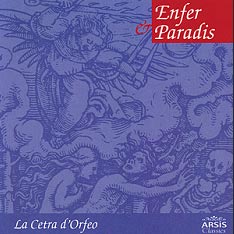
- Title: La Folia part 1, 2 and 3 (separate tracks on the disc)
- Released 2003 by Arsis compact disc
- Duration: 9'16"
- Recording date: unknown
- CarIo Chiarappa (Violin), Ottavio Dantone (harpsichord and organ), Mauro Valli (cello)
Paolo Poalini (Spanish guitar), Paolo Cherici (theorbo) "Musik und Malerei"
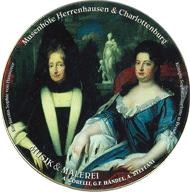 In the slipcase is written:
In the slipcase is written:
.Musik und Malerei vermahlen das ist das Anliegen unserer "Museum Collection", in der Musik und Malerei als zwei Ausdrucksformen des Kulturgefühls und Zeitgeistes einer Epoche oder eines kulturellen Zentrums zusammengeführt werden.
Auf Anregung der "Freunde der Herrenhauser Garten e.V." hat BRISA Entertainment GmbH diese CD-Dose in Zusammenarbeit mit der Stiftung PreuBische Schlösser und Garten Berlin-Brandenburg und dem Bomann-Museum, Celle, zusammengestellt. In Ton Text und Bild werden die Musenhöfe der Kurfürstin Sophie von Hannover und der Königin in PreuBen, Sophie Charlotte, als kulturelle Zentren des Barock deutlich gemacht. Die den beiden Höfen verbundene Musik von Agostino Steffani, Arcangelo Corelli und Georg Friedrich Handel vermittelt das Lebensgefühl um 1700 aufs Innigste.- Title: Sonata Nr.12 "Follla", d-moll: Adagio-Allegro-Adagio-Vivace-Allegro-Andante-Allegro-Adagio-Allegro
- Released 2000 by BRISA U.K. Ltd compact disc (in a round can as container) Ordernr. 48110-2
- Duration: 11'03"
- Recording date: not mentioned in the documentation
- Concertino Köln (Andrea Keller, Baroque violin, Helga Löhrer, baroque violoncello, Gerald Hambitzer, harpsichord) 'Price Waterhouse Konzertsommer 1997'
- Title: Sonata d-moll "La Follia" für Violine und b.c Adagio-Allegro-Adagio-Vivace-Allegro-Andante-Allegro-Adagio-Allegro
- Released by K & K Kultur & Kommunikation GmbH 3-cd-set (cd 2: track 16-24)
- Duration: 11'02",
- Recording date: July 9, 1997 in Schloß Charlottenburg-Orangerie, Germany
- Daskalakis, Ariadne (violin), Strümpel, Gabriella (violoncello),
Lerch, Helene (harpsichord) 'Ariadne Daskalakis, Matteis, Biber, Baltzar, Corelli, J.S. Bach, DG Bank Musik-Edition 1999'
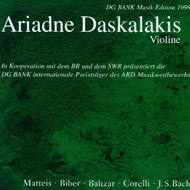
- Title: Sonata Op. 5, Nr 12 'La Follia'
- Edition: Lea Pocket Scores (Urtext)
- Released 1999 by Tudor Recording AG Zürich, compact disc 7081 in corporation with the DG Bank (German Bank), the Südwestrundfunk Baden-Baden and Bayerischen Rundfunk München
- Duration: 11'26",
- Recording date: August 27 and 28, 1999 in the Studio of the Südwestrundfunk, Kaiserslautern, Germany
- Daskalakis, Ariadne (violin), Strümpel, Gabriella (violoncello),
Lerch, Helene (harpsichord) 'Violino Arioso, Ariadne Daskalakis'
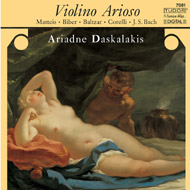
- Title: Sonata Op. 5, Nr 12 'La Follia'
- Edition: Lea Pocket Scores (Urtext)
- Released 2000 by Tudor Recording AG Zürich, compact disc 7081
- Duration: 11'26",
- Recording date: August 27 and 28, 1999 in the Studio of the Südwestrundfunk, Kaiserslautern, Germany
- David, F. edited and Hermann, F. transcribed the music for viola and
piano
- Title: Sonata la follia for viola and piano
- Published by International Music c.1948
- Score 15 p. and 1 part, 31 cm
- David, F. edited the music for violin and basso continuo
- Title: Folies d'Espagne: variationen fur Violine mit beziffertem Bass
- Published by Henri Petri, Breitkopf & Hartel 191?
- Score 15 p. and 1 part, 35 cm
- David, F. edited the music for violin and piano
- Title: Folies d'Espagne for violin and piano, entirely re-arranged for the concert stage according to an earlier version and provided with an original variation by Auer, Leopold.
- Published by Fischer 1922
- Score 25 p. and 1 part, 32 cm
- Series: Carl Fischer's music library no. 877
- Dillery, Patrick (flute), Kiss, Georges (harpsichord) 'La Folia'
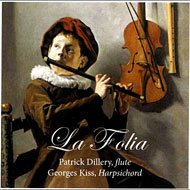
- Title: Sonata Op. 5, Nr 12 'La Follia'
- Released 2013 by Le Chant de Linos compact disc CL 1283
- Duration: 12'15"
- Recording date: 2011
- The Early Music Consort of London conducted by Munrow, David 'Renaissance
Suite' for the Joël Santoni film "La Course en tête"
(a film on the Belgium cyclist Eddy Merckx).
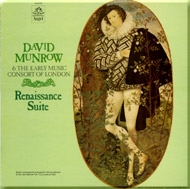 James Durant wrote as an introduction at the backside of the cover:
James Durant wrote as an introduction at the backside of the cover:
[...] Munrow extended his activities with the Consort to a heavy schedule of concerts, tours, and the making of numerous albums, encompassing the early music of many countries. His popular English television series Pied Piper considered music of all eras. In the eight years of Munrow's all-too-brief career before his death in 1976, he also wrote a book Instruments of the Middle Ages and Renaissance (Oxford University Press. London: 1976) and composed and arranged the scores for four feature films, including Ken Russell's The Devils, the EMI-MGM Henry VIII, John Boorman's Zardoz, and the French documentary La Course en tête, produced by Vincent Malle and directed by Joël Santoni.
It is Munrow's score for La Course en tête that is heard here. Focussing upon the European bicycle races at Grenoble, the film sensitively explores the anxieties and problems, as well as the pleasures and rewards, of the professional bike riders in competition. For his score, Munrow utilized arrangements of music by Hassler, Praetorius, Susato, Macque, Phalèse, and Corelli, and composed original themes in early music styles. [...]
Arcangelo Corelli (b. Fusignano, 1653; d. Rome, 1713) studied counterpoint with Simonelli and violin with Bassani. His travels as violin virtuoso and composer took him to Paris and throughout Germany. In 1685 he settled in Rome in the service of Cardinal Pietro Ottoboni. Corelli made a major contribution to the development of violin technique. As composer, his sonatas da camera and concerti grossi were the predecessors of the sonatas and concertos of Bach and Handel. David Munrow's "End Music" uses Variations on La Folie d'Espagne from Corelli's, Op. 5 No. 2.- Title: End Music - Variations of 'La Folie d'Espagne' from Corelli, Op. 5 No. 12 'Division Flûte' (1706) arranged for Recorder solo, Flute, Lute, Bassoon, Violin, Trumpet, Strings and Continue.
- arrangement from a manuscript Division of flute (1706), editor unknown
- Released 1974 by EMI as LP HQS 1415, in France as Pathe Marconi EMI 2C 064 - 12789, in Northern America as Angel S 37449
- Library of Congress Catalogue Card No. 77-751146
- Duration: 6'36"
- Recording date: unknown (not mentioned on the LP Angel release)
- Ehrhardt, Susanne (recorder) Ogeil, Jacqueline (harpsichord) Waugh,
Margaret (cello) 'La Follia, variations by Corelli, Vitali, Vivaldi, Scarlatti'
From the slipcase:'La Follia' has proven to be one of the most popular and enduring harmonic progressions from the Renaissance and Baroque period. Throughout history 'La Follia' has been used by many great composers including Corelli and Vivaldi, right through to Liszt and Rachmaninoff. This CD contains a wide selection of 'La Follia' variations by Baroque composers, including one of the most well known settings, by Corelli - 'La Follia' from Sonata Op 5, No 12. This work is Corelli at his best, displaying an endless imagination through a succession of variations in ever changing moods and metres. Likewise the setting by Vitali also featured, contains a wealth of variation and invention
- Title: Sonata Op 5 no 12
- Released 1998 by Move Records compact disc MD 3211
- Duration: 10'15"
- Recorded at Move Records studio, Melbourne, Australia without indication of any dates

- Ehrhardt, Susanne (recorder) 'Musik im Umkreis von Sophie Charlotte'
Lance Eccles wrote about the performance:The insert in the CD says the Corelli is for 'Altblockflöte und Basschalumeau', but I don't hear any Basschalumeau. The accompaniment seems to be cembalo (Michael Schönheit) and Cello (Bettina Messerschmidt).
- Year of release not indicated in the slipcase by GEMA without a catalogue number
- Duration: 9'36"
- Recording date: 1998 for the Preussische Schlösser und Gärten Museumsshop
- Enesco, Georges (violin) & unknown pianist 'Georges Enesco, violin'
- Title: Sonate en Ré Mineur pour violon et piano Op. 56 no 12 LA FOLLIA
- arrangement pour violon et piano: David, revision Petrie
- Released 1990 by Music Memoria compact disc MONO AAD 30322
- Duration: 8'53"
- Recording date: Enesco died in 1955, so it had to be recorded earlier
- Enesco, Georges (violin) & unknown pianist 'Historical Recordings - George Enescu' (Enescu instead of Enesco)
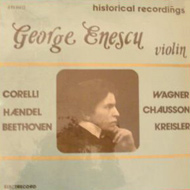
- Title: Sonata in Re Minor Op. 5 No. 5 'La Follia'
- Released in the 1980's by Electrecord (Romania) White Label lp ELE 02715
- Duration: unknown
- Recording date: Enesco died in 1955, so it had to be recorded earlier
- Enesco, Georges (violin) & unknown pianist
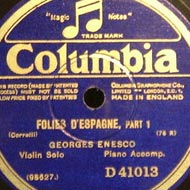
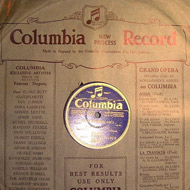
- Title: Folies d'Espagne, Part 1 & 2
- Released 192? by Columbia 12" 78rpm record, pressed in ENGLAND 192? numbers on deadwax: W98627 and 12240 / W98628 and 12241, ordernumber D41013
- Note that the name of composer is spelled as Correlli
- Duration: unknown
- Recording date: unknown
- Enesco, Georges (violin) & Schlüssel, Sanford (piano), unknown
title of cd
- First released by Columbia 50187/88D (matrices 98617/18 and 98619/20
- Re-released 1992 by Biddulph Recordings compact disc LAB 066
- Duration: 8'37"
- Recording date: 1929
- Ensemble Caprice Stuttgart 'Kammermusik von Corelli und Kuhnau'
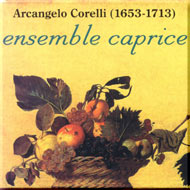
- Title: Sonate op. 5 Nr. 12 d-moll/g-moll (La Follia)
- Released December 1997 by Antes (Bella Musica Edition) compact disc
- Recording date: unknown
- Ensemble Fitzwilliam (Jean-Pierre Nicolas recorders, Michèle Dévérité harpsichord and organ, Bruno Cocset violoncello, violoncello piccolo and viola da gamba,
Yasunori Imamura theorbe and barock guitar)
'Corelli, Sonatas Opus V Nos. 7-12'
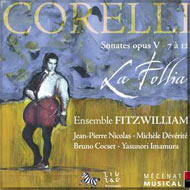
In the slipcase is written:
Jean-Pierre Nicolas chose the flute in D, pitched a third lower than the standard treble instrument in order to play the exact melodic lines and especially the virtuosic variations of the Follia
- Title: La Follia, 23 variations
- Released November 2005 by ZigZag territoires compact disc 2005.11.21
- Duration: 11'29"
- Recording date: February 28- March 4, 2005 in Chapelle de l'ecole St Geneviève Versailles, France
- Ensemble Fraal: Jaques Lesburqueres (flute), Hans-Michael Eckert (cello), Hans-Wolfgang Brassel (harpsichord) 'Italienische Impressionen'
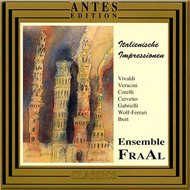 In the booklet is written:
In the booklet is written:
Just imagine if everyone had composed in the manner of Arcangelo Corelli, whose variations on an old Spanish Sarabande La Follia caused quite a stir, not only with his contemporaries ...
- Title: Variationen über das Thema 'La Folia'
- Released 2007 by Bella Musica Edition compact disc
- Duration: 9'36"
- Recording date: March 10-12, 1995 in Schlossbergsaal des SWF, Landesstudio Freiburg, Germany
- Ensemble Galilei (Liz Knowles: fiddle,
Deborah Nuse: Scottish small pipes and fiddle, Sarah Weiner: oboe recorders
and pennywhistle, Sue Richards: Celtic harp, Carolyn Anderson Surrick:
viola da gamba with Jan Hagiwara: percussion and Nancy Karpeles: bowed
psaltery) 'From the Isles to the Courts'
As mentioned in the slipcase some variations of Corelli are mixed into this Folia-medley, where the Marais-variations are more prominent.- arrangement by Liz Knowles, published by Major B Music (ASCAP)
- Released 2001 by Telarc compact disc CD-80536
- Duration: 09'16"
- Recording date: June 19-22, 2000 in Gordon Center for the Performing Arts, Owings Mills, Maryland
- Ensemble Il Giardino Armonico; Giovanni Antonini (recorder), Paolo Beschi (cello), Luca Pianca (theorbo), Lorenzo Ghielmi (organ and harpsichord)
'Italian Recorder Sonatas'
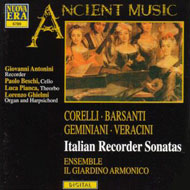
- Title: Follia
- Released 1992 by Nuova Era compact disc 6789
- Recording date and place: unknown
- L'Ensemble Musica Antiqua de Provence:
Christian Mendoze (recorder), Corinne Betirac (harpsichord), Federico Marincola (baroque guitar)
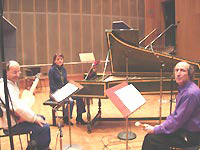
- Title: Sonate op 5 no 12 La Follia (including an interview)
- Broadcasted by Radio France April 29, 2006
- Duration: 9'51" (excluding an interview of 4'45")
- Recording date and place: April 29, 2006 live in Studio 118, France
- Eolina Quartet 'Eolina Quartet plays Janitsch, Kazandjiev, Guillemain and Corelli'
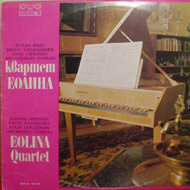
- Title: Variations 'La Follia'
- Released 19?? by Balkanton ( Bulgaria ) Blue Label LP BKA 10116
- Duration: unknown
- Recording date: unknown
- Fernandez, François (violin) and Wilson, Glen (harpsichord) 'Corelli violin sonatas Op. 5 nos. 7-12'
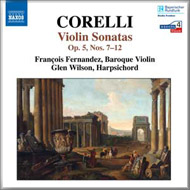
Glen Wilson wrote for the disc:There is no twelfth sonata. XII is entitled Follia, and is a set of 22 variations on the dance tune of that name which goes back to fifteenth-century Portugal and was a great favourite throughout the baroque era. The 'madness' implied in the title was said to reflect the wild mood of the dancers. Corelli takes us a step further into a state of general derangement. Geminiani, in one of his treatises, names Corelli's variations as the ultimate work of the violin literature, and says 'I have had the pleasure of discoursing with him myself upon this subject, and heard him acknowledge the Satisfaction he took in composing it, and the Value he set upon it.'
- Title: Follia
- Released 2007 by Naxos compact disc Naxos 8.557799
- Duration: 11'55"
- Recording date: Recorded in Kloster Bronnbach, Wertheim, Germany from 20th to 22nd March 2006
- violin built by Andrea Guarneri 1690, harpsichord built by Henk van Schevikhoven, Helsinki after a 1628 Andreas Ruckers
- Ferrarini, Claudio (flute) and Tasini, Francesco (harpsichord) 'Il grande
barocco Italiano - Corelli'
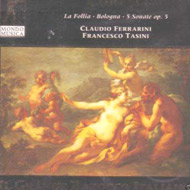
- Title: Sonata No 12 in D minor 'La Follia', transposed to G minor
- Released March 1997 by Mondo Musica compact disc MM 96008
- Recording date: March 15, 1996
- Including birdsounds
- Fiorentino, Maria Giovanna (Flauto dolce), Zanardi, Carlo (violincello),
Polato, Pier Luigi (arciliuto, tiorba), Loreggian, Roberto (clavicembalo)
'Arcangelo Corelli Opera V - Sonate per flauto dolce (Londra, Walsh 1702)'

- Title: Follia, Sonata XII in sol minore
- Released 1999 by Tactus compact disc CDTC650309
- Duration: 10'10"
- Recording date: 1996
- Fontanarosa, Patrice (violin) and Dintrich, Michel (10 string guitar)
'Duos pour violon et guitare (cd)' and 'Duo Fontanarosa and Dintrich, Volume 2 (lp)'
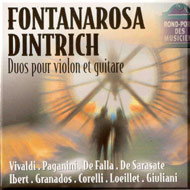
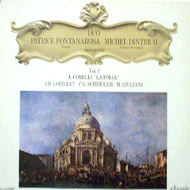 In the slipcase is stated:
In the slipcase is stated:
Born in Bologna, Italy, Corelli lived in Rome. He has produced the most significant example of a sonata for two or three instruments. He was an innovator in the concerto form which underwent an extraordinary development in the following centuries. "La Folia" certainly one of Corelli's most enchanting works, reveals his real discovery - the instrumental use of the 10 - string guitar and the violin. The resulting resonance lends to Corelli's music all its sensitivity, charm and originality. The balance achieved in the movements of the concerto is a miraculous poetical synthesis.
- Title: La Folia
- Arrangement by Michel Dintrich
- Originally released 1970 by Barclay as LP for Classic 991 025. Re-release 2003 by Accord compact disc 476 092-1 (including Ibert, Granados , de Falla, de Sarassate, Paganini and Vivaldi which are all not included at the LP-version)
- Duration: 12'09"
- Recording date: October 1968 and November 1970 in l'eglise Notre Dame du Liban, Paris, France
- Fontanarosa, Patrice (violin) and Dintrich, Michel (10 string guitar) 'Duo Fontanarosa and Dintrich'
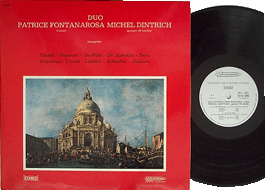
- Title: La Folia
- Arrangement by Michel Dintrich
- Released by Musidisc 2 LP-set silver label made in France 16005 Stereo
- Duration: 12'09"
- Recording date: October 1968 and November 1970 in l'eglise Notre Dame du Liban, Paris, France
- Fontanarosa, Patrice (violin) and Nordmann, Marielle (harp)
- Title: Sonata No 12 in D minor 'Les folies d'Espagne'
- Released 1996 by EMI Classics compact disc 5563592
- Recording date: February 1996
- La Fontegara Amsterdam: Coolen, Saskia & Hotslag, Peter & Tol,
Han (3 recorders) 'Common Grounds: Recorder Consort Music'
Hard to classify because they mixed the variations of Marais and A. Scarlatti and introduce some improvisations in the middle part.
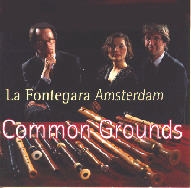 Erik Beijer wrote as introduction in the slipcase:
Erik Beijer wrote as introduction in the slipcase:
The 'Follia', too, became a rich stew in the hands of LFA: we get a taste of Corelli and Marais, but also a touch of Scarlatti and Carl Philip Emmanuel Bach. But what does it matter? In the art of arranging, varying and improvising, the question 'which note is whose?' has become absolutely irrelevant.
- Title: La Follia (arrangement La Fontegara Amsterdam) by Corelli, Marais and Domenico(?) Scarlatti (this must be a slip of the pen because Alessandro Scarlatti is musically quoted).
- Released 1995 by Globe compact disc GLO 5112
- Duration: 8'45"
- Recording date: December 1993 in Utrecht, The Netherlands
- Francescatti, Zino edited the music for violin and piano
- Published by International Music Co. c.1976
- Score 16 p. and 1 part 7 p., 31 cm
- Franco, Horatio (flutes) 'Mestizajes Novohispanos'
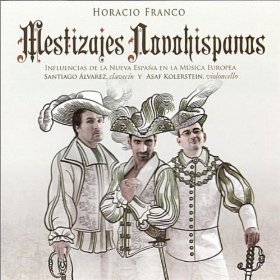 With Santiago Alvares harpsichord and Asaf Rolerstein cello:
With Santiago Alvares harpsichord and Asaf Rolerstein cello:
- Title: Variaciones sobre La Follia, OP 5 no. 12
- Released 2011 by Quindecim compact disc ASIN B004P9FBI8
- Duration: 9'31"
- Recording date: February 2010 at the Centro Académico Cultural Juriquilla, Mexico
- Friedrich, Reinhold (trumpet), Lücker, Martin (organ), Friendrich, Hartmut (trombone) 'Top'
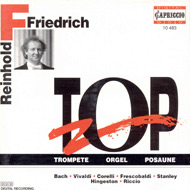 Oliver Buslau wrote for the slipcase:
Oliver Buslau wrote for the slipcase:
The oldest form of arrangement known in musical history is the variationof already existing themes. Some of these models really became archetypes: They were varied by so many composers that the original spiritual father fell into oblivion. Two of these essential themes are the English folk song 'Greensleeves' and the sarband tune 'La Folia'. The attraction of these themes lies in the comprehensible harmonic sequences, on which they are based and which have encouraged numerous composers to write so-called ostinato variations, that is improvisations over a bass, that is permanently repeated. This type of variation was already mentioned in a novella by the author of Don Quichote, Miguel de Cervantes, who called this piece 'Folia'. Therefore the famous theme from the Corelli concerto bears the name of a whole variation genre being at the same time its most popular representative. Corelli, the baroque master of the violin and 'inventor' of the concerto grosso, develops from the simple model a whole host of modes of expression, from grandiose festiveness to complicated counterpoint, from sweeping cantabile to brilliant virtuosity.
Reinhold Friedrich and Martin Lücker wrote for the slipcase:
Das führte zur 'Follia' von Corelli. Wirklich der helle Wahn diese Musik! (Follia=Wahnsinn, fixe Idee). Aus der originalen Vorlage (Violine und bezifferter Bass) haben wir eine Art organisierter Improvisation gemacht. Zunächst wurde die originale Violinstimme ihrer Länge wegen zwischen Trompete und Orgel aufgeteilt, und dann ging 's kos: Da wird auf der Grundlage der Continuo-Notierung improvisiert, figuriert und konzertiert, kaum etwas haben wir dabei notiert.
- Title: La Follia, Opus 5, nr. 12
- Released 1993 by Capriccio and Hessischer Rundfunk compact disc 10 483
- Duration: 13' 39"
- Recording date: June 25-30, 1993 in the St. Katharinenkirche Frankfurt am Main
- The organ of the St. Katarinenkirche was (re)built by Rieger Orgelbau, Schwarzach
- Gatti, Enrico: violin (Laurentius Storioni, Cremona 1789)
Nasillo, Gaetano: cello (Barak Norman, London c.1710)
Morini, Guido: harpsichord (Antonio Martini, Ravenna 2001) 'Corelli, Sonate a Violino e Violone o Cimbalo Op.5'
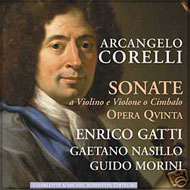 Enrico Gatti wrote for the slipcase (translated from the French by John Tyler Tuttle):
Enrico Gatti wrote for the slipcase (translated from the French by John Tyler Tuttle):
The twelfth sonata is "La Follia" by antonomasia, the one that was the basic for the compositions of Marais, Vivaldi, Reali, et al. It was customary to colclude a collection with a series of variations on the same bass (lateron, one will also find examples in Vivaldi, Tessarini, Tartini ...), and Corelli, in truth, deploys a vast range of ideas, metres and phrasings to best illustrate the proud, ancient Iberian theme. Pupil Francesco Geminiani spoke of it in these terms: " I do not pretend to be its inventor: other composers of the very highest level have embarked on the same voyage; and none of them with greater success than the celebrated Corelli, as can be seen in his Opus V, on the Aria de la Follia de Spagnia [sic]. I had the pleasure of discussing this with him and heard him acknowledge the full satisfaction he felt in composing it, and the worth he attributed to it (source).
- Title: Follia, in re minore
- Arrangement by Reinhold Friedrich and Martin Lücker
- Released by Arcana in a coproduction with WDR3 2x compact disc A 423
- Duration: 11'37"
- Recording date: May 25 till June 2003 in the church of Badia Cavan, Langhirano, Parma, Italy
- Gli Accademici di Milano (Renato Biffoli and Giuseppe Magnani violin
soloists, Nereo Gasperini cello and Bruno Canino harpsichord, Dean Eckertsen
conductor and editorial responsibility 'Corelli, concerti grossi, opus
5 (complete)'
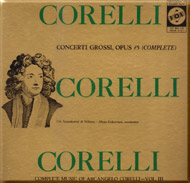
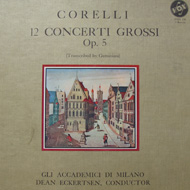
Joseph Braunstein wrote for the slipcase of the re-issue 1962:The last number of Opus 5 is not a sonata but a variation cycle which is not only the crown of the set but Corelli's greatest technical achievement. It has a precursor in the Ciacona, the last piece of the chamber sonatas Opus 2. The ciacona (Chaconne in French), the passacaglia (passecaille), as wel as the Portuguese folia, whose Italian spelling is follia are closely related. They are dances in triple time.
The origin of the follia was long a matter of dispute. It was thought to be Spanish, but the Portuguese musicologist Luis de Freitas-Branco has drawn attention to the fact that the noun folia (meaning obsession) and the verb foliar derived from it, are Portuguese and not Spanish words. The follias were known in Portugal as early as the fourteenth century. Yet the tendency to regard the follia as a Spanish dance developed only from the beginning of the seventeenth century and one called them 'Folies d' Espaigne'. At the end of the sixteenth century follias were included in collections of instrumental music. There they invariably appear as variations on an ostinato bass. They can be found in works of Italian, French and German composers and the theme of the follia was heard everywhere.
It seems very strange indeed that through four centuries dozens of composers have used that tune for variations. This phenomenon becomes more puzzling in view of the fact that the range of this tune is only a fourth plus a semitone. Yet it exercised an irresistible magnetic power on a host of composers. Percy Scholes compiled a list of 23 names but remarked "that it is certain that dozens of examples are omitted." His list includes Frescobaldi [red: which is not a folia], Corelli, Vivaldi, Domenico [red: Alessandro the father of Domenico is intended here] Scarlatti (Variazioni sulla Follia di Spagna), Bach (Peasant Cantata, 1742), Carl Philipp Emanuel Bach, Gretry, Cherubini, Liszt (Spanish Rhapsody for Piano, 1863) and Rachmaninoff with his Variations on a Theme by Corelli (!) for Piano. The tune was well known in Italy and Corelli became familiar with the ostinato technique presumably through the works of Girolamo Frescobaldi whose 'Cento Partite sopra Passacagli' (1637) is on account of its melodic, rhythmic and contrapuntal diversity a worthy predecessor of Corelli's 'La follia' and Chaconne and Passacaglia by elaborations has been thrown on the the market that, it is true, bear Corelli's name but go far beyond the violin technique of his time, elaborations which Pincherle defined as "calamitous disarrangements" of La Follia.
The student of this work who happens to be a violinist will quickly become aware of Corelli's basic conception. The composer's overriding interest centered on violinistic problems and the technique of bowing in particular . Thus, Geminiani's task was a very difficult one because he had to adapt the violinistic style to the ensemble.- Title: Follia, Sonata XII in sol minore
- Released 1958 (first time), this re-issue 1962 by Vox Productions LP-3set VBX 38 as part of the series 'Complete music of Arcangelo Corelli Vol. III'
- Duration: 14'15"
- Recording date: not mentioned
- Goldschmidt, Thomas Ulrich (violin) Lorenzen, Wolfram (piano) 'Corelli- Beethoven'
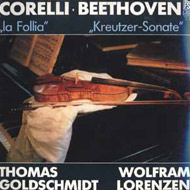
- Title: La Follia
- Released 1988 by FSM Germany LP Stereo 68715
- Duration: unknown
- Recording date: unknown
- Grehling, Ulrich (violin) Wenzinger, August (violoncello) Neumeyer,
Fritz (harpsichord)
- Title: Sonata 'La Follia'
- Released 1955 by Archive Production vinyl 25 cm long play 33 1/3 rpm record mono ARC 3008
- Edition recorded: Edition Schott 438l (Mainz B. Schott's Sohne, 1953)
- Duration: 12'15"
- Recording date: October 8, 1953 in the Paulus-Saal, Freiburg
- Grehling, Ulrich (violin) Wenzinger, August (violoncello) Neumeyer,
Fritz (harpsichord)
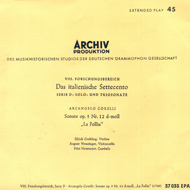
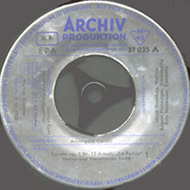
- Title: Sonate op. 5 Nr. 12 d-moll 'La Follia'
- Released by Archiv Produktion single vinyl extended 45 RPM mono 37 035 EPA, theme and var. 1-10 side A, var. 11-23 side B. Series: VIII Das italienische Settecento serie D: solo- und triosonate
- Edition recorded: Edition Schott 438l (Mainz B. Schott's Sohne, 1953)
- Duration: 12'15"
- Recording date: October 8, 1953 in the Paulus-Saal, Freiburg
- Grindenko, Tatyana (violin) and the Moscow Chamber Academy
- Title: Sonata No 12 in D minor 'La Follia'
- Released 1989 by Ondine compact disc Ode 735-2
- Duration: 10'05"
- Recording date: May 1989 at the Järvenpää Concert Hall
- Grumiaux, Arthur (violin) and Castagnone, Riccardo (harpsichord) 'Arcangelo Corelli. Sonate Op. 5 A Violino E Violone O Cimbalo'
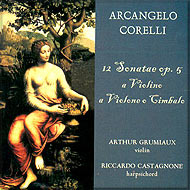
In the slipcase is written:
Incidentally, the suite in Italy at that time was called sonata da camera, or chamber sonata, so that it could be immediately distinguished from the sonata da chiesa. The 12th and last of the so-called 'sonatas' has nothing to do with either of these: it is a theme with variations. The theme, entitled 'La Follia' - a Spanish dance - was one of the most popular melodies of the day and was arranged by many Baroque composers. But it really only survives today in this last and most popular of Corelli's 12 sonatas.
- Title: Sonata No. 12 in D minor: Adagio - Allegro
- Released 2004 by Elite Classics Baroque Collection 2 compact disc-set 51-550-B labeled 'For sale in Russia'
- Duration: 13'26"
- Recording date: not mentioned in the documentation
- The same release contains the Follia of Corelli performed by Siegwald and Wieland Kuijken and Robert Kohnen as a bonus track
- Grumiaux, Arthur (violin) and Castagnone, Riccardo (harpsichord) 'Baroque violin sonatas'
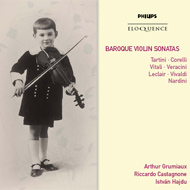
William Yeoman wrote for the slipcase:The last of Corelli's twelve sonatas comprising his Op. 5 consists entirely of a series of increasingly virtuosic variations on 'La Folia'. Originally a Portuguese peasant's dance, the Folia (the etymology of which is related to our 'fool') became the basis for improvisations by more courtly musicians throughout the Iberian peninsula before making its way northwards to France, Italy, England and the Netherlands during the sixteenth and seventeenth centuries. Corelli's version, like the rest of his Op. 5, was highly influential; Vivaldi's Op. 1 trio sonatas of 1705, for example, ends with a set of Folia variations as a direct homage
- Title: Sonata in D minor, Op. 5 No. 12 'La Folia'
- Released 2007 by Philips compact disc 2x cd-set mono recording 442 8240, originally produced 1957, Universal International Music
- Duration: 11'53"
- Recording date: July 1956 Bachzaal, Amsterdam, The Netherlands
- Grumiaux, Arthur (violin) and Castagnone, Riccardo (harpsichord)
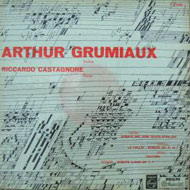
- Title: 'La Follia' Sonata OP.5 no 12
- Released by Philips LP A 00380 L (Made in Holland)
- Duration: 13'14"
- Recording date: 1975
- Grumiaux, Arthur (violin) and Castagnone, Riccardo (harpsichord) 'Corelli, 12 sonate a violine e cembalo op 5'

- Title: 'La Follia' Sonata OP.5 no 12
- Released 1975 by Philips LP 6700 096
- Duration: 13'14"
- Recording date: 1975
- Grumiaux, Arthur (violin) and Castagnone, Riccardo (piano) 'An Arthur Grumiaux recital'
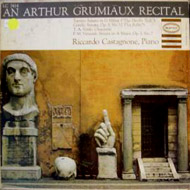
- Title: 'Follia'
- Released 1956 by Gold Label mono LP LC 3414
- Duration: 11'51"
- Recording date: July 1956, Amsterdam, The Netherlands
- Grumiaux, Arthur (violin) and Castagnone, Riccardo (piano) 'Grumiaux, the early recordings'


- Title: Sonata in D minor Op.5 No.12 'La Folia'
- Released 1993 by Philips 3-cd boxset PHCP-1260~2 (made in Japan) and 438-516 (438-517, 518 and 519) made in Germany
- Duration: 11'51"
- Recording date: July 1956, Amsterdam
- Arrangement by Riccardo Castagnone
- Grumiaux, Arthur (violin) and Castagnone, Riccardo (piano) 'Violin sonatas: Tartini, Corelli, Vitali, Veracini'
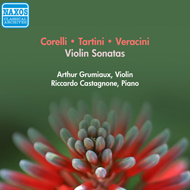
- Title: Violin Sonata in D minor, Op. 5, No. 12, "La folia"
- Released by Naxos compact disc 9.80482
- Duration: 11'48"
- Recording date: unknown
- Haendel, Ida (violin) and Parsons, Geoffrey (piano) 'Ida Haendel, violin Classical Recital'
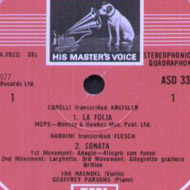
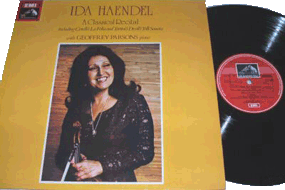
- Title: Sonata No 12 in D minor 'La Folia'
- Released 1977 EMI, A Christopher Parker recording, the first release LP ASD 3352
- Duration: 13'25"
- Recording date: june 1976
- Arrangement by Fritz Kreisler
- Haendel, Ida (violin) and Parsons, Geoffrey (piano) 'Baroque Transcriptions'
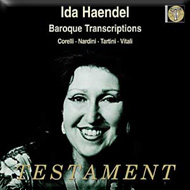
- Title: Sonata No 12 in D minor 'La Folia'
- remastered 2002 from the original release 1977 by EMI LP ASD 3352, SBT compact disc SBT 1258
- Duration: 13'25"
- Recording date: june 1976
- Arrangement by Fritz Kreisler
- Haendel, Ida (violin) and Parsons, Geoffrey (piano) 'July Classical Sampler 1977'
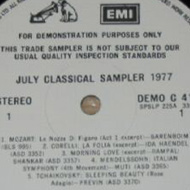
- Title: excerpt of Sonata No 12 in D minor 'La Folia'
- Released 1977 as a demo by EMI/HMV LP DEMO C41 (UK only release), originally LP ASD 3352
- Duration: unknown (excerpt)
- Recording date: june 1976
- Arrangement by Fritz Kreisler
- Haendel, Ida (violin) and Yampolsky, V. (piano)
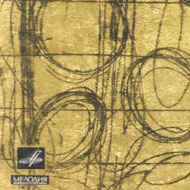
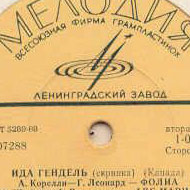
- Title: Folia
- Released as mono recording 1960's by Russian label Melodiya LP D 07287-07288
- Duration: 11'39"
- Recording date: 1960
- Arrangement by G. Leonard
- Haendel, Ida (violin) and Yampolsky, V. (piano)
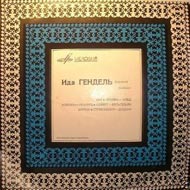

- Title: Folia
- Released as mono recording 1960 by Russian label Melodiya LP D 07287
- Duration: 11'39"
- Recording date: 1960
- Arrangement by G. Leonard
- Haendel, Ida (violin) and Yampolsky, V. (piano)
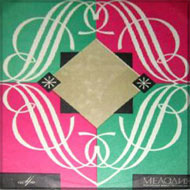
- Title: Folia
- Released as mono recording by Russian label Melodiya LP D-07287. Gost 5289-61.
- Duration: 11'20"
- Recording date: unknown
- Arrangement by G. Leonard
- Haendel, Ida (violin) and Yampolsky, V. (piano) 'Bach, Händel, Corelli, Schubert, Bartok, Stravinsky'
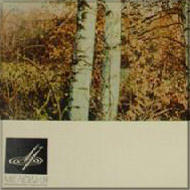
- Title: La Folia
- Released as mono recording by Russian label Melodiya LP D-07287, 07288 GOST 5289-68, Pink Label
- Duration: 11'20"
- Recording date: 1960
- Arrangement by G. Leonard
- Haendel, Ida (violin) and Yampolsky, V. (piano) vinyl without title
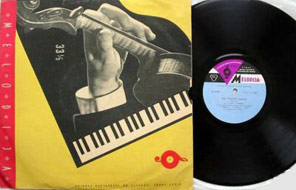
- Title: La Folia
- Released as mono recording by Russian label Melodiya LP D-07287, Ryga Factory GOST 5289-61
- Duration: 11'20"
- Recording date: 1960
- Arrangement by G. Leonard
- Hall, Mike (alto trombone) Bell, Rebecca (harpsichord) and Rice, Larry (double bass) 'Arcangelo Corelli, solo chamber sonatas opus 5'
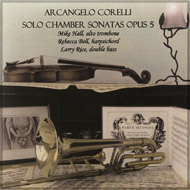
A very unusual line-up with alto trombone and harpsichord and double bass as basso continuo but it sounds all very natural to me.
The choice was made out of practical and orchestral considerations. The solo trombone sounds an octave lower than Corelli's violin, so they used the double bass as the bass instrument because it sounds an octave lower than Corelli's bass, but also because the two instruments compliment each other so well in the 21st century ear according to Mike Hall.
Duration: 1'04", 1011 kB. (128kB/s, 44100 Hz)
2 Variations, with multi-phonics of the alto trombone in the second variation
© James Michael Hall 2004, used with permission
Mike Hall wrote for the slipcase about Sonata 12 in D minor:
This sonata is performed essentially as Corelli published it, 23 variations on the 'Follia' theme. Perhaps Portuguese in origin, the centuries old "Follia" theme was a popular subject for variation sets of the 17th century. Some have described Corelli's variations as nothing more than bowing exercises, but Corelli makes his bass as active and involved as the solo. This adds considerable interest to a sonata that seems intended as a vehicle for virtuosic display. We employ orchestration that suits the wind soloist and we rely upon trombone multiphonics to take the place of the many passages that call for double-stopped notes on the violin. Trombone multi-phonics is the practice of singing a note with the voice, while at the same time, playing a lower note with the lips. While this is certainly not a Baroque technique, it is an accepted part of 21st century trombone technique. In the same way that Corelli sought to demonstrate the technical capabilities of the violin that flourished in his era, this recording seeks to demonstrate similar capabilities unique to the trombone in the 21st century. Indeed, this recording and its accompanying performance editions aspire to take a place in the unbroken, 300-year performance lineage established upon Corelli's solo sonatas.
- Title: Sonata No 12 in D minor 'Follia' variations
- Released 2004 by Conn-Selmer Kagarice Brass Editions compact disc KUCS1207
- Duration: 12'53"
- Recording date: September 24-26, 2001 and January 14-16, 2002 at Saint Lawrence Catholic Campus Center, Lawrence, Kansas, USA
- Alto trombone: Conn 36h E-flat alto trombone with B-flat/A valve attachment. Greg Black standard weight, custom mouthpiece, similar in internal size and shape to Bach 18.
- Hesperion XXI (with Manfredo Kraemer violin) directed by Jordi Savall
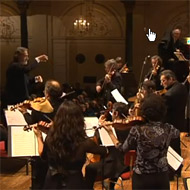
Live performance in Het Concertgebouw February 16, 2012
Duration: 7'23" direct link to YouTube
© 2012 by Jordi Savall and ZaterdagMatinee- Title: Concerto grosso "La Follia", opus 5, No. 12, composto della Opera Quinta d'Arcangelo Corelli, con due Violini, Viola e Violoncello di Concertini Obligati e Concerto Grosso
- Broadcasted by NTR Netherlands for radio and YouTube (promo) as part of De Zaterdagmatinee
- Duration: unknown
- Recording date: February 18, 2012 in Het Concertgebouw in Amsterdam, The Netherlands
- Holloway, John (violin) and the Zurich Chamber Orchestra
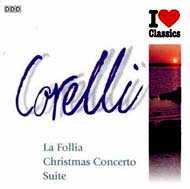
- Sonata for Violin and Basso Continuo, Op. 5: no 12 in D minor 'La Follia'
- Released July 27, 1999 by 'I Love classics' compact disc (2) #541
- Homolya, Istvan and Devich, Sandor edited the music Z 13 600
- Title: Sonata per violino e basso continuo (violino cello and continuo) 'Follia' Opus 5 No. 12
- Published by Editio Musica Budapest, H-1370 PO 322 Telex 22 5500
- Score 13 p. and 2 part, 346 bars
- Publisher No. Z 13 600
- Hoopes, Chad (violin), O'Riley, Christopher (piano)
Great program for top talents and to encourage all people to join playing the music. Some funny jazzy variations and some lying down as the photo indicates.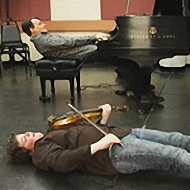
- Title: La Follia in an arrangement of Fritz Kreisler
- Broadcasted for the program 'From the Top at Carnegie Hall', Season 2, Episode 11: Jumping Through Hoopes
- Recorded in 2008 for NBC television at carnegie Hall, New York, USA
- Duration 8'20"
- From the Top at Carnegie Hall is a co-production of 'From the Top', WGBH and Don Mischer Productions in partnership with Carnegie Halll.
- More about this episode at season 2, episode 11
- Huang, Bin (violin) and Kim, Hyung-Sun (piano) 'Baroque Violin Favorites'
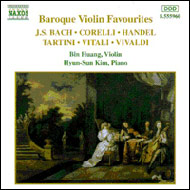
- Title: 'La Folia'
- Released 2002 by Naxos compact disc 8.5558960
- Duration: 9'02"
- Recording date: 23-24 January 2002 at the River Run Centre, Guelph, Ontario, Canada
- Jacobsen, Maxim edited the music for violin and piano. Cadenza by H.
Leonard.
- Published by Edition Peters c.1931
- Score 8 p. and 1 part, 31 cm
- Publisher No. 3443
- Jansen, Jan (organ solo)
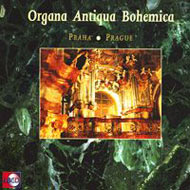 Unfortunately nothing is said in the documentation (slipcase) about this wonderful arrangement of the Folia-arrangement of the music by Corelli.
Unfortunately nothing is said in the documentation (slipcase) about this wonderful arrangement of the Folia-arrangement of the music by Corelli.
In an e-mail Jan Jansen wrote July 12, 2009:Ik speelde "La Folia" gewoon uit het manuscript voor viool en continuo. Harmonische toevoegingen kwamen logisch voort uit de bc. De regisratie en registerwisselingen zijn afhankelijk van de mogelijkheden van het orgel. (translation: I just played the Corelli variations from the manuscript for violin and basso continuo. Harmonic added parts were derived from the b.c. The registration and stops are of course dependable from the possibilities of the local organ.)
In the slipcase is written about Jan Jansen:Jan Jansen (1946) studied organ, piano and harpsichord at the Utrecht conservatory. In 1966 he won the 'chorale'prize at the national improvisation competition in Bolsward. As a pupil of Cor Kee he gained the Prix dÉxcellence for organ in 1970. Jan Jansen has taught at the Utrecht conservatory since 1973, and he was appointed organist of the Dom in Utrecht in 1987, where he performs weekly with the choir at Saturday afternoon concerts. He has played in Holland and abroa, and has made many recordings (radio, TV,LP,CD).
- Title: Sonata No 12 in D minor 'La Follia' in an arrangement for organ solo
- Released by Lindenberg compact disc LBCD 71/74 in association with the dutch Katholieke Radio Omroep (KRO) and Radio Netherlands World Service (RNW)
- Duration: 11'30"
- Recorded 1996 at the Anton Kartner Choir-organ (built in 1767), in Tekla, Bohemen
- Jelescu, Radu (violin), Buniato, Giannina (voice soprano), Carrubba, Sergo (pianoforte)
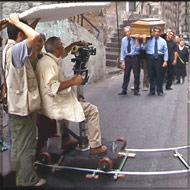
Duration: 3'52" direct link to YouTube
Fragment of the film 'Le cose che parlano' with Radu Jelescu's arrangement of La Follia
© 2006 Zelig srl Catania- Title: 'La follia' di Arcangelo Corelli
- Arrangement: Radu Jelescu
- Duration: 3'52"
- As part of the film 'Le cose che parlano', a film by Rosario Lizzio and Tiziana Bosco
- Production: Zelig srl Catania in collaboration with Comune di Catania - Assessorato al Turismo
- Recorded 2006 in Italy
- Joachim, J. & Chrysander, F. edited the Urtext edition
- Twelve violin sonatas opus V (including La folia)
- Published by Lea Pocket 1970
- Score 107 p., 17 cm
- Publisher No. Lea Pocket Scores 166
- Jones, Thomas (violin) Valler, Rachel (piano) 'A Kreisler Celebration'

- Title: La Folia (Arcangelo Corelli, arr. Fritz Kreisler)
- Released by Move Records compact disc MD3173
- Juda, Jo (violin) Hengeveld, Gerard (piano) 'Nardini and Corelli'
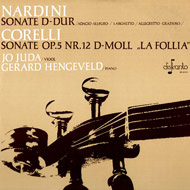
- Title: Sonate Op.5 Nr.12 d-moll La Follia
- Released by Diskanto LP
- Khitruk, Anastasia (violin) and Tchalik, Daniel (piano) 'La Folia'
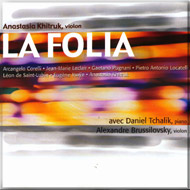 Baudime Jam wrote for the slipcase (translated by Michael Pochna):
Baudime Jam wrote for the slipcase (translated by Michael Pochna):
The first mention of the theme on which 'La Folia' is based occurs in 1505, and a number of compositions bearing that name appear throughout the 16th century. In 1611 'Tesoro', the first published dictionary of the Spanish language, gives us this definition: 'La Folia: Portuguese dance, very loud since in addition to many people on foot with little cymbals (Basque tambour) and other instruments, it includes portefaix in costumes carrying on their shoulders boys dressed as girls who shake their long sleeves, dance sometimes, and play their cymbals as well; the noise is so loud and the rhythm so fast that they all seem to be possessed by 'madness' whence the name 'Folia'.
During the seventeenth century, the spirit of the Fpolia changed: from a leaping dance it was transformed into a kind of passacaglia or chaconne, noble and stately. From then on, La Folia came intofashion with composers all across Europe, from Frescobaldi in Italy; Boyce and Arne in England, passing through Lully and d'Anglebert in France and Pergolesi and Bach in Germany. This theme has remained popular with composers such as Cherubini (The Portuguese Hostelry: 1798), Liszt (Spanish Rhapsody: 1863), and Nielsen (Mascarade: 1906).
In Corelli's work, the sixteen-bar tune recurs constantly in the bass, while the violinist proceeds continually through new material, alternating mood and tempo for twenty three variations. The edition used here is that of the nineteenth-century violinist Hubert Leonard, who has altered somewhat the order of Corelli's variations, and has expanded some of them as Corelli himself undoubtedly did in performance.- Title: La Folia, variations sérieuses
- Released 1999 by Suoniecolori compact disc SC 253312
- Duration: 11'10"
- Recording date 1999 in La Maison de la Musique de Nanterre
- Kneihs, Hans Maria (recorder) & Radulescu, Michael (harpsichord) & Kaiser, Michael (cello) 'Baroque Recorder Vol. 2'
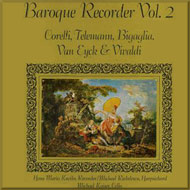
- Title: La Follia Variation Op. 5 No. 12 for Recorder and Bass Continuo
- Released 1972 by Klavier LP KS 512
- Duration: 9'55"
- Recording date: unknown
- Kokott, Marion (recorder) & Alexander Weimann (harpsichord), Douglas Vistèl (double bass) Doris Runge (baroque cello), Christian Hoffmann (Irish harp), Stefan Jagemann, Natajaran, Christoph Renner (percussion) and Helmut Abel (accordion) 'Floating senses, flute music'
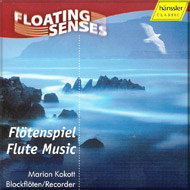 In the last variations all the musicians are mentioned and the gratitude for their contribution is shown.
In the last variations all the musicians are mentioned and the gratitude for their contribution is shown.
- Title: Sonata No 12, op. 5 in G minor 'La Follia'
- Released 2003 by Hännsler Classic compact disc 98.461
- Duration: 12'53"
- Recording date: not mentioned in the documentation
- Kol, Bracha (recorder) & Brodo, Amy (cello) & Shemer, David
(harpsichord) 'Baroque Favourites'

Ora Binur Shmit wrote for the slipcase:'La Folia' also belongs to the variations genre. Folia (or Follia, known also as Les Folies d'Espagne and by other titles) is a famous melody of the early 16th century, probably of Portugese origin, which was used by a great number of composers as a theme for continuous variations. The Folia has no ritornellos, is almost always in D minor and is geberally slow and dignified.
The Folia began, usually, with a statement in which all second beats were dotted. This threw a powerful secondary accent on the opening chord.
This masterly set of twenty-four variations, which concluded his Op. 5 is Corelli's most difficult as well as his most enduringly popular composition.- Title: La Follia, Op. 5 No. 12
- Released 1988 by Fine Art Collection CDI compact disc 18806
- Duration: Adagio/Allegro 3'25", Adagio/Vivace/ Allegro/Andante/Allegro/Adagio 4'28", Allegro 2'56"
- Recording date: 1988 at the Jerusalem Music Centre, Jerusalem, Israel
- Kottmann, Alois (violin) Dennemarck, Rudolf (piano) 'Portrait'
 In the booklet is written:
In the booklet is written:
With cycle of sonatas opus 5, in which the Sonata "Folies d'Espagne" belongs, Corelli finally established his fame as composer and violinist. This piece of music appeared in print in Rome, Amsterdam and London all in the same year - 1700. This was very unusual at the time (for example, Bach's works were not printed at all during his lifetime.
- Title: Sonata Folies d'Espagne, op. 5/12 (La Folia): Variationen über ein Thema von Farinelli
- Released 2002 by Melisma 2 cd-box OPUS 7202-2
- Duration:10'06"
- Recording date: January 31, 1976 at the Hessischer Rundfunk, Germany
- Kovács, Dénes (violin) Banda, Ede (cello) Sebestyén,
János (harpsichord) 'Twelve Sonatas for Violin and Continuo, Op.
5'
Dénes Kovács, János Sebestyén and Ede Banda
Duration: 11'38" direct link to YouTube
© ca. 1970 Hungaroton- Released circa 1972 on Hungaroton LP SLPX 11514-15
- Duration: 12'10"
- Recording date: circa 1970
- Kraemer, Manfredo (Hespèrion XXI conducted by Jordi Savall and others) 'Altre Follie'
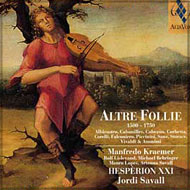 Rui Vieira Nery wrote for the slipcase:
Rui Vieira Nery wrote for the slipcase:
With the development of the virtuosic repertoire for the violin at the turn of the century it was only natural that the Folia should be included in it. In 1700 the great Arcangelo Corelli (1653-1713) used it as the basis for a series of exceedingly virtuosic variations with which he concluded his most influential collection of solo sonatas for violin and continuo, the famous Op. 5, the contents of which are known to have circulated in manuscript for more than a decade prior to this printing. In 1704 one of the most representative composers of violin music of the German and Dutch school, Henricus Albicastro, an artistic pseudonym of Johann Heinrich von Weissenburg (ca. 1660 -ca. 1730), published a sonata 'La Follia', which displays a clear Corellian influence in its virtuosic writing. And it was not by accident that a year later, in 1705, the young Antonio Vivaldi (1678-1741) also chose to conclude a decisive publication in which he placed the highest hopes for the future of his artistic career, his Op. 1 collection of trio-sonatas, with yet another magnificent set of Folia variations.
- Manfredo Kraemer (violin), Balazs Mate (violoncello), Xavier Díaz-Latorre (guitar), Carlos García-Bernalt (harpsichord)
- Title: Follia (1700)
- Released 2005 by Alia Vox compact disc AV 9844
- Duration: 11'00"
- Recording date: February 28-March 3 and June 6-9, 2005 in the Collégiale of the Château de Cardona, Catalogne
- See also the page Recommended Folia-recordings
- Kränzlein, Anna Katharina see composers letter K(ränzlein)
- Krainis, Bernard (recorder) et son ensemble baroque 'La flute a bec
(2) as part of the series 'Musique pour instruments anciens, vol. 6'
- Released by Mode Disques LP MDK 9 252. Year of release not indicated
- Duration: 10'23"
- Krainis Recorder Consort Bernard Krainis (alto recorder), Paul maynard (harpsichord), Barbara Mueser (viola da gamba) 'Music for the recorder Vol. 2'
as part of the series 'Eight centuries of music for recorders'
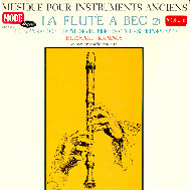

Bernard Krainis wrote for the recording:
In May of 1702 John Walsh, the famous London music publisher, issued 'Six Solos for a Flute and Bass' by Arcangelo Corelli. Five of these 'solos' were transcriptions for alto recorder of the celebrated violin sonatas from Opus 5 (which Walsh had published two years earlier). The remaining work, also from Opus 5, was the even more celebrated 'Follia' or 'Spanish Folly': a set of variations on a tune much admired by composers of variations before Corelli's time and since. Recorder transcriptions of all sorts of music, both vocal and instrumental, were commonplace in 17th and early 18th Century England. Players of the recorder (then called the 'flute') were apparently as numerous then as now, since publishers displayed much energy and imagination in supplying their needs.
- Title: La Follia, Opus 5 No. 12
- Released by Kapp Disques LP KS-3386. Year of release not indicated but it must be after 1957 because the source of that year was used
- Duration: 10'23"
- Source used: Archangelo Corelli: La Follia. New York: McGinnis and Marx, 1957
- The name Correlli (with double R) is proclaimed with large letters on the recording, but not in the smaller texts. The spelling of the name Arcangelo is as 'Archangelo' throughout the texts.
- Kreisler, Fritz edited the music for violin and piano
- Published by Carl Fischer c.1927
- Score and 1 part, 31 cm
- Publisher No. 31858
- Kreisler, Fritz
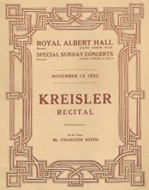
- Programme for solo recital published 1925 (concert was not recorded)
- The programme included Corelli's La Folia, Lalo's Symphonie Espagnole and a selection of lollipops including transcriptions of La Fille au cheveux de lin by Debussy and Molly on the Shore by Grainger.
- Recording date: November 15, 1925 at the Royal Albert Hall with Charlton Keith
- Kuijken, Sigiswald (violin: Giovanni Grancino, Milan 1700) Kuijken, Wieland (violoncello: Andrea Amati, 1570)
Kohnen, Robert (harpsichord: Joannes Daniel Dulcken, Anvers 1755) 'Sonate a Violino e Violon o Cimbalo op. V'
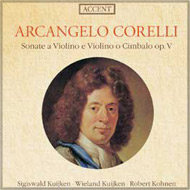
- Released 1984 by Accent compact disc ACC 10033 and ACC 48433 D
- Duration: 11'48"
- Recording date: April 1984 in L'eglise Protestante de Bruxelles Chapelle Royale
- Violin by Giovanni Grancino - Milano 1700, violoncello by Andrea Amati 1570, harpsichord by Joannes Daniel Dulcken - Antwerpen 1755)
- Kuijken, Sigiswald (violin) Kuijken, Wieland (violoncello) Kohnen, Robert (harpsichord) 'Arcangelo Corelli. Sonate Op. 5 A Violino E Violone O Cimbalo'

In the slipcase is written:
Incidentally, the suite in Italy at that time was called sonata da camera, or chamber sonata, so that it could be immediately distinguished from the sonata da chiesa. The 12th and last of the so-called 'sonatas' has nothing to do with either of these: it is a theme with variations. The theme, entitled 'La Follia' - a Spanish dance - was one of the most popular melodies of the day and was arranged by many Baroque composers. But it really only survives today in this last and most popular of Corelli's 12 sonatas.
- Title: Follia
- Released 2004 by Elite Classics Baroque Collection 2 compact disc-set 51-550-B labeled 'For sale in Russia'
- Duration: 11'53"
- Recording date: not mentioned in the documentation
- The same release contains the Follia of Corelli performed by Grumiaux and Castagnone
- Kulenkampff, Georg (violin) and orchestra conducted by Selmar Meyrowitz
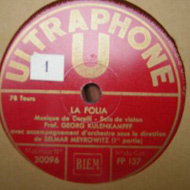
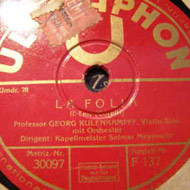
- Title: La Folia, part 1 and part 2
- Released by Ultraphone 78 RPM FP 137
- Duration: unknown
- Recording date: not mentioned in the documentation (1920's?)
- Kurosaki, Hiro (violin), Balsa, Emmanuel (cello),
Christie, William (harpsichord) Soundtrack: 'Jefferson in Paris', original
music composed by Richard Robbins. Period music performed by 'Les Arts
Florissants'/ Christie, William. Historical music selected and overseen
by David Bahanovich. From the liner notes by David Bahanovich, historical
music supervisor, Paris, January 1995:

'... It was said that Jefferson's violin playing helped him win his wife's hand in 1772, and it would not be surprising if Maria Cosway was also impressed by his musical abilities. I gravitated to Corelli's Violin Sonata Op 5 no 12 La Follia not only because Jefferson owned multiple editions of this work but also for its sheer beauty. Corelli's La Follia and its orchestrated version by Francesco Geminiani are heard throughout the film, each time helping to highlight the ever-changing emotional landscape. ...'.
Jim Stevenson commented in June 2001:the Geminiani version does not appear to be on the CD. And since the CD is designated ADD and a reference is made to Erato records, it may be that this is an old recording re-released. But I could find no other reference to it. This CD no longer seems to be available through retail outlets. I had to get a copy from used CD dealers.
- Violin Sonata Op. 5 No. 12 La Follia - Theme & 23 Variations
- Released: 1995 Angel Records compact disc CDQ 7243 5 55311 2 4.
- Duration: 10'21"
- Recording date: not mentioned in the slipcase or container
- Kussmaul, Rainer (violin), Wolf, Jürgen (cello), Praetorius, Lisedore
(harpsichord) 'La Folia'
- Title: Sonate XII (La Follia) für Violine und Generalbass
- Released c. 1950 by Impromptu LP CS 93402
- Duration: 12'27"
- Recording date: not mentioned on the backside of the cover
- see also the page Recommended Folia-recordings
- Legene, Eva (recorder) Gillespie, Wendy (viola da gamba), Wright, Elisabeth
(harpsichord)
- Recorded by Indiana University, School of Music (Early Music Institute) in Bloomington
- Sound cassette, digital stereo, 1986-1987 no. 187
- Recording date: October 7, 1986
- Leonard, Hubert & Marteau, Henri edited the music for 2 violins
and piano
- Published by B. Schott's Söhne New York/Mainz Schott Music Corp. c.1930
- Score 7 p. and 2 part, 30 cm
- Publisher No. Edition Schott 1542; 06995/96
- Leonard, Hubert edited the music for violin and continuo
- Published by Schott freres c.191?,
- Score 11 p. and 1 part, 36 cm
- Publisher No. S.F. 1165
- Leupold Trio: Eva Stegeman (violin), Wouter Mijnders (cello) and Sören Leupold (chitaronne)
- Title: La Follia
- Recorded and broadcasted live at AVRO Radio 4 (The Netherlands) January 6, 2008
- Duration: 10'02"
- Recording date: January 6, 2008 in Kleine Zaal Concertgebouw, Amsterdam, The Netherlands
- Lichtenberg, Leopold edited and fingered the music for violin and piano.
Cadenza by H. Leonard
- Published by G. Schirmer Inc. 1929
- Score 8 p. and 1 part, 31 cm
- Publisher No. Schirmer's library of musical classics v. 525
- Linde, Hans-Martin (recorder) Jappe, Michael (viola de gamba) Scheidegger, Rodolf (harpsichord)
'Corelli für Blockflöte, sechs Sonaten aus OP 5, Corelli'
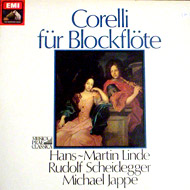
- Sonate nr. 6 D dur op 5
- Recorded 1981 by EMI LP EMI 1c 065-45 712
- Duration: 10'05"
- Recording date: 1981
- Linde, Hans-Martin edited the music for Treble Recorder and Basso continuo
Hans-Martin Linde wrote in the preface: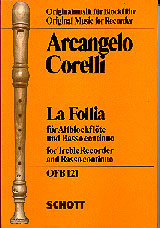
'La Follia', a dance melody similar in style to a sarabande, has inspired numerous composers to write variations on it. They include d'Anglebert (Pièces de Clavecin), Vivaldi (Op. 1, no 12) and Marais (Pièces de Violes, Deuxième Livre). Variations on the Follia melody for recorder over the Follia bass, described as 'Faronels Ground', appeared in the collection 'The Division Flute' (1706) (Edition Schott 5737). J.S. Bach in the aria of the Goldberg variations made use of the popular bass only. Its origin is unknown. It appeared already in early sources, and was described as 'Italian' by Spanish composers in the 16th century (cf. D. Ortiz, 'tenore italiano').
Corelli's 'La Follia', Op. 5, no 12, was published by John Walsh (London 1702) in a version for recorder transposed from d to g. It follows the original version for violin exactly, except for the double-stop parts.
There are no thrill signs in the original text (British Museum, London). Other additions made by the editor have been indicated as such. The variant in bar 160 is also to be found in F. Geminiani's Concerto grosso version of Corelli's Op. 5, nr. 12. The pauses that have been inserted by the editor should facilitate the division of the variation sequence.- Published by Schott, Mainz 1972
- Score 20 p. and 1 part, 30 cm
- Publisher No. OFB 121
- Locatelli Trio: Wallfisch, Elizabeth (violin), Tunnicliffe, Richard
(cello), Nicholson, Paul (piano) 'Corelli: 12 sonatas, Op. 5'
- Title: Sonata No 12 in D minor 'La Follia'
- Released November 1990 by Hyperion compact disc (2x) CDA 663812
- Recording date: 1989
- Manze, Andrew (violin) and Egarr, Richard (harpsichord) 'Corelli, violin
sonatas, Op. 5'
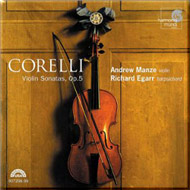 Andrew Manze and Richard Egarr wrote for the slipcase:
Andrew Manze and Richard Egarr wrote for the slipcase:
Opus 5 ends with twenty-four variations on the simple harmonic sequence, said to have originated in the Iberian peninsula: Follia. Many sets of variations in general, and of the Follia in particular, survive on paper, although one suspects that far more were improvised. than were ever written down. One violinist contemporary of Corelli who studied in Rome, Michel Farinel (1649-c.1700), introduced the Follia to England (where it was known as 'Farinel's Ground'). Perhaps it was part of a Roman violinist's everyday repertoire, in which case Corelli's notated version in Opus 5 was perhaps didactic in intent. He certainly provides an A-to-Z of violin technique circa 1700, including variations dedicated to arpeggios, consecutive thirds, running sixteenths and the indispensable messa di voce, the long, sustained bow stroke which was considered to be the key to good violin playing. Alongside these techniques, Corelli also leaves plenty of room for the performers' personal follies.
- Title: Sonata XII in D minor, 'Follia', adagio, allegro, adagio, vivace, allegro, andante, allegro, adagio, allegro '
- Released 2002 by Harmonia Mundi USA compact disc HMU 907298.99
- Duration: 12'12"
- Recording date: November 5-8, 2001 and February 5-8, 2002 at Skywalker Sound, Nicasio, California
- Manzone, Jaques-F. (violin), Degenne, Pierre (cello), Pillet-Wiener,
Nicole (harpsichord) 'Corelli, Sonatas Op. 5'
- Released 1965 by Decca France LP 7.151
- Recording date: unknown
- Markov, Albert Eduard (violin)
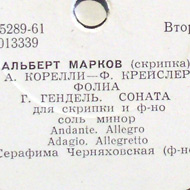
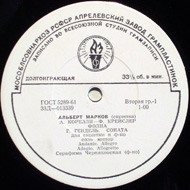
- Title: Sonata No 12 in D minor 'La follia'
- Released 1953 by the Russian label Torch as vinyl 5289-61
- Duration: unknown
- Recording date: unknown
- Martini edited the music for violins and choir
- Title: 15 Variationen über die Sarabande 'Aria della Follia'
- Published by Schott
- Score 146 p.
- Publisher No. CON38-70
- Melkus, Eduard (violin) Atmacayan, Garo (cello) Dreyfus, Huguette (harpsichord)
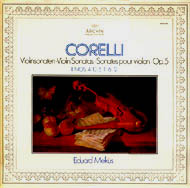 Eduard Melkus wrote as an introduction:
Eduard Melkus wrote as an introduction:
Since no authentic ornaments for 'La Follia', the last work in Opus 5, were available, the original text has been left untouched, although an eighteenth-century violinist would certainly have added some improvisations. Only the last variation was extended to include Veracini's coda. Otherwise we avoided Verancini's versions of Opus 5, since they entail too sweeping changes in the whole composition.
- Title: Sonata No 12 in D minor 'La follia'
- Released by Archiv F20A 20073
- Duration: 11'53"
- Recording date: January 9-12 and March 27-29, 1972 in Palais Schönburg Wien, Austria
- Melville, Alison (recorders) Harris, Lucas (archlute and baroque guitar) Jackson, Nadina Mackie (baroque bassoon), Medicky, Borys (harpsichord), Morton, Joëlle (bass viol)

- Title: Sonata op. 5 no. XII, 'Folia'
- Released 2010 by Pipistrelle Music ordernumber PIP1110
- Duration: 11'10"
- Recording date: February 18-20, 2010 at the Chapel of Royal St George's College, Toronto, Canada
- Mendoze, Christian (flûte à bec) and Musica Antiqua: Philippe Foulon (violoncelle), Brigitte Tramier (harpsichord),
Jean-Michel Robert (théorbo and guitar) '30e Anniversaire'
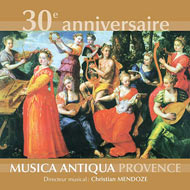
- Title: Sonata no 12 Follia
- Released 2011 compact disc
- Duration: 10'17"
- Recording date: unknown location
- Mendoze, Christian (flûte à bec) and Musica Antiqua: Philippe Foulon (violoncelle), Brigitte Tramier (harpsichord),
Jean-Michel Robert (théorbo and guitar) 'Sonates pour violon op. 5 intégrale vol 2'
- Title: Sonata no 12 Follia
- Released 1999 by Parnassie compact disc PAR 04
- Duration: 10'17"
- Recording date: February 22 and 25, 1997 in unknown location
- Menuhin, Yehudi (violin) and Giesen, Hubert (piano) 'The Young Yehudi
Menuhin, The HMV Recordings 1929-30'
- Title: Sonata No 12 in D minor 'La follia'
- Released January 2001 by Biddulph LAB 032
- Recording date: December 11, 1930
- Menuhin, Yehudi (violin) and Giesen, Hubert (piano) 'Menuhin encores'
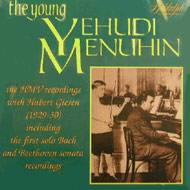
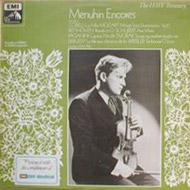
- Title: Violin sonata no. 12 in D minor: 'La follia'
- Released 1976 by His Master's Voice LP HLM 7077 Mono.This is an album of transfers from old 78's to 33 released in 1976.
- Recording date of La Follia 1930
- Milevski, Piotr (violin) Gee, Lawrence (piano)
- Title: Sonata in D minor, op. 5 no. 12 ('La Folia')
- Recorded by Indiana University, School of Music (Early Music Institute) in Bloomington for the Artist Diploma in Violin
- Sound tape reels, stereo, 1983-1984 no. 160
- Duration: 9'15"
- Recording date: October 13, 1983
- Milstein, Nathan (violin) Pommers, Leon (piano) 'The Art of Nathan Milstein
- Beethoven, Brahms, Dvorauml;k, etc'
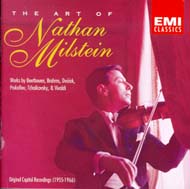
- Arrangement by Hubert Leonard
- Released 1959 by US Capitol as LP SP-8481
- Re-released 1993 by EMI as 6-pack compact disc CDM 64830
- Duration: 9'15"
- Recording date: January 27-29, 1959
- Milstein, Nathan (violin) Pommers, Leon (piano) 'Quattro Sonate Italiane'
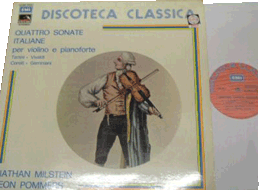
- Arrangement by Hubert Leonard
- Released by EMI Capitol as LP 3 C 053-81638 (Italian pressing)
- Duration: 9'15"
- Recording date: January 27-29, 1959
- Milstein, Nathan (violin) Pommers, Leon (piano) 'Italian sonatas'
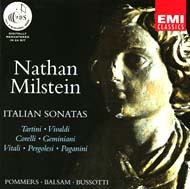
Mistein plays Corelli variations with piano as basso continuo
Duration: 9'15" direct link to YouTube
© 1998 EMI- Arrangement by Hubert Leonard
- Released 1959 by US Capitol as LP SP-8481
- Re-released 1998 by EMI as compact disc CDM 66873
- Duration: 9'15"
- Recording date: January 27-29, 1959
- Milstein, Nathan (violin) Pommers, Leon (piano) 'Corelli, La Follia part 1 & 2'
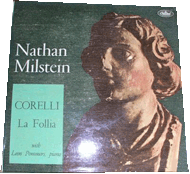
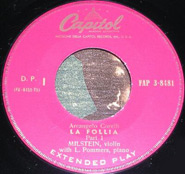
- Arrangement by Hubert Leonard
- Released 1961 by La Voce del Padrone/Capitol, Extended Play (EP) mono FAP 3-8481
- Re-released 1998 by EMI as part of compact disc CDM 66873
- Duration: 9'15"
- Recording date: January 27-29, 1959
- Mönkemeyer, Nils (viola) and Kammerakademie Potsdam 'Folia'
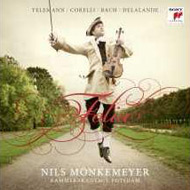 Bayerische Rundfunk wrote about the disc:
Bayerische Rundfunk wrote about the disc:
Selbst Corellis berühmte "Folia"-Variationen - natürlich für die hellere, strahlendere Violine komponiert - wirken bei Mönkemeyer so unstrittig "richtig", so lebendig, schmissig und wild, dass die guten fünf Zentimeter mehr zwischen Wirbeln und Kinnstütze nicht ins Gewicht fallen - allenfalls positiv, wegen der extra Portion warmem, satten Sound.
- Title: Sonata No. 12 in D minor/G minor "La Folia" (adapted for Viola & Strings)
- Released 2011 by Sony compact disc 88697801132
- Duration: 12'25"
- Recording date: unknown
- Musical Amphion (Rémy Baudet violin, Jaap ter Linden cello, Mike Fentross theorbo & guitar, Pier-Jan Belder harpsichord)
conducted by Pieter-Jan Belder 'Corelli, Complete Works'
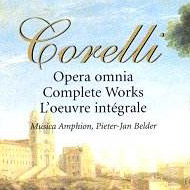 In the slipcase is written:
In the slipcase is written:
The last and most celebrated sonata contains the variations on the passionate theme La Folia, which areexceptionally virtuosic for Corelli. 'La Folia' was to become one of the most famous tunes in music history. The melody was taken from a Spanish dance, like a sarabande, but wild and exuberant as in the original sense of the word folia: madness or frenzy. It was gladly embraced by a whole line of western composers, from Lully, Corelli, Marin Marais via Alessandro Scarlatti, Carl Philipp Emanuel Bach to Liszt and Rachmaninov.
As a homage to his great example, Corelli's pupil Francesco Geminiani published a series of twelve concerti grossi in London from 1726, based on Corelli's sensational Violin Sonates op.5. What has been a highly virtuosic piece for solo violin in Corelli's hands became a merciless exercise for string orchestra in Gemininani's- Title: Follia
- Released 2004 by Brilliant Classics compact disc No. 8 (10 cd-set)
- Duration: 10'57"
- Recording date: Summer 2004 in Amsterdam, The netherlands
- Nielsen, Thorvald edited the music for violin and piano
- Title: La Folia variations serieuses violin og klaver
- Published by W. Hansen 1949
- Score 11 p. and 1 part 5 p., 31 cm
- Publisher No. 3443
- Nishizaki, Takako (violin), Wolf Harden (piano) 'Fritz Kreisler Edition, Vol. 6'
- Title: Violin Sonata in D minor, Op. 5, No. 12, "La folia" (arr. F. Kreisler)
- Released 2005 by Naxos compact disc 8.557872
- Duration: 11'36"
- Recording date: unknown
- Nishizaki, Takako (violin) and Dennis, Terence (piano) 'Takako Nishizaki plays Suzuki Evergreens, Volume 5'
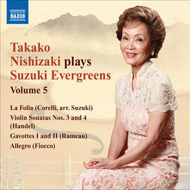 In the slipcase is written:
In the slipcase is written:
The fifth volume of the Takako Nishizaki Plays Suzuki Evergreens starts with an arrangement by Shinichi Suzuki of Arcangelo Corelli’s variations based on the popular dance, La Folia. Corelli, with his twelve sonatas for violin and keyboard, his trio sonatas and his dozen concerti grossi, exercised a strong influence on his successors, with many of his works familiar before his death in Rome in 1713 and their final publication. His Op. 5, No. 12 is a set of variations on La Folia, a dance that was to form the basis of various compositions by his contemporaries and successors.
- Title:Violin Sonata in D minor, Op. 5, No. 12, "La folia" (a part of the original by Corelli and an arrangement by S. Suzuki: Suzuki is a trademark of the International Suzuki Association and the Suzuki Violin School music books are published by Alfred Publishing Co. Inc.)
- Released 2010 by Naxos compact disc Ordernr. 8.572382
- Duration: 7'06" (arr. Suzuki) and 6'35" (Corelli)
- Recording date: April 23-27, 2008 at WEL Academy, Waikato University, Hamilton, New Zealand
- Norman, Theodore; a transcription for solo guitar
- Published in Music for the Classical Guitar, Book II
- © 1964 by G. Schirmer Inc.
- Oberlinger, Dorothee (recorders and direction), Vestidello, Walter ( cello), Rado, Giancarlo (archlute and baroque guitar), Ose, Karsten Erik
(bass recorder), Rosato, Giampietro (harpsichord and organ) ' Italian Sonatas'
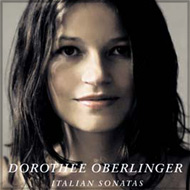 Dorothee Oberlinger wrote for the slipcase in 2007:
Dorothee Oberlinger wrote for the slipcase in 2007:
There were apparently quite a number of skilled recorder-players in 18th century England, and by 1702 at the latest, Corelli was a household name to them: this was the year when local publisher John Walsh brought out several recorder arrangements of the op.2 & 4 trio sonatas as well as of the famous op.5 violin sonatas. In the latter case, however, the arrangements were only made of the last six of the set of twelve, which are set in the sonata da "camera style". In the last sonata of the set, op. 5 no. 12 in G minor, Corelli sets the melody of then popular Portuguese dance "La Follia" with a total of 21 variations, in whose ostinato harmonies the bass line is quite virtuoso in places
- Title: Sonata in G minor op.5 no.12 "La Follia" Version for Alto Recorder & Continuo (London, 1702)
- Released 2007 by Deutsche Harmonia Mundi compact disc 88697115712
- Duration: Adagio 01:27, Allegro 01:58, Adagio 00:47, Vivace 00:19, Allegro 00:14, Andante 00:41, Allegro 00:33, Adagio 01:44, Allegro 02:53
- Recording date: February 28th, March 1-2, 2007 in Deutschlandfunk Kammermusiksaal, Köln, Germany
- Oberlinger, Dorothee (recorders and direction) and Ensemble 1700

- Title: Follia, op. 5 no. 12
- Broadcasted by dutch radio AVRO October 3, 2011 for the program "Avondconcert"
- Duration: 9'57'
- Recording date: July 8, 2011 during a live performance at the RheinVokal Festival in Abteikirche Rommersdorf (Stadtteil Heimbach-Weis)
Neuwied, Germany
- Olujic, Tatjana (violin) and Toskov, Aleksandar (piano) 'Recital'

- Released by Yugo LP RTB 230405
- Duration: unknown
- Recording date: unknown
- Orchestre Philharmonie de Hambourg conducted by Jochum, Eugen 'Centenaire
Eugen Jochum'
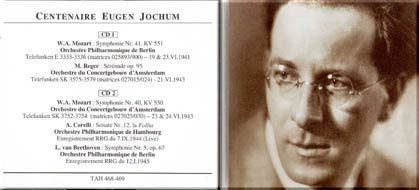 Eugen Jochum wrote for the slipcase (page 15):
Eugen Jochum wrote for the slipcase (page 15):
I stayed [in Hamburg] fifteen and a half years for the entire Nazi period, the war and the defeat. This was only possible because of the open-mindedness that has always been a characteristic of this city. My personal and political opinions would have surely made it impossible for me to live in Berlin, Dresden or Munich.
- Released compact disc(2-cd box) TAH 468-469
- Duration: 13'25"
- Recording date: September 7, 1944 live , recorded by RRG
- Ostafi-Dancu, Ioana (cello) and Ungureanu, Mihai (piano)
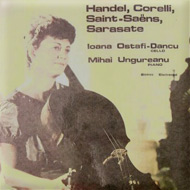
- Title: La Follia op. 5 No. 12
- Released by Electrecord LP ST-ECE 03593 (made in Romania)
- Duration: unknown
- Recording date: Spring 1988 in a recital at the Romanian Athanaeum (Inregistrare realizata in Sala de marmora a Casei Scinteii, 1988)
- Paganini Duo
- 1. Adagio 2. Allegretto 3. Andante 4. Allegro moderato 5. Adagio
- Arranged by Meier, Gerd
- Released by Thorofon Capella compact disc MTH 326
- Recording date: 1987
- Pera ensemble
(with aoud, kanun, kemence, ney, baroque oboe, 2 Baroque violins, baroque cello, theorbo/baroque guitar, harpsichord and percussion 'Cafe, Orient Meets Occident'
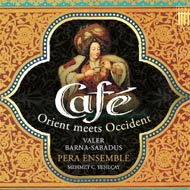
- Title: Sonatas for Violin and Basso Continuo, Op. 5: no 12 in D minor "La Follia"
- Released 2012 by Berlin Classics compact disc 0300400BC
- Duration: 7'22"
- Recording date: unknown
- Perlman (violin) & Sanders (piano) 'Bits and pieces'
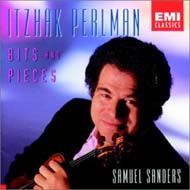
- Released October 1994 by EMI Classics compact disc 0777 7 54882 27
- Duration: 10'40"
- Perlman (violin) & Sanders (piano) 'Kreisler - Perlman, Encores'
John Siepmann wrote in 2006 for the slipcase:But this recital [...] is an act of hommage not only to Kreisler but to the long tradition of great violonist composers who came before himn, and of which het was the last representative. The point is implicit in the opening track. Arcangelo Corelli (1653-1713) is widely regarded as the most illustrious founder of that tradition. Ironically he is perhaps best known for a theme he never actually composed. La Folia is in fact a anonymous Iberian dance song from the 17th century, much varied by composers from that time onwards (among them Franz Liszt and Kreisler's friend an collaborator Sergei Rachmaninov).
- Title: La folia
- Released 2006 by EMI Classics, Series Gemini compact disc EMI 0946 350879 2 5 (2CD)
- Duration: 10'33"
- Recording date: January 13-16, 1992 in the BMG Studios, New York. .
- Petrenz, Siegfried edited the music for traverso and basso continuo
- Title: La Follia
- Published by Universal Edition, Braun, Gerhard and Heidecker, Martin
- Score 32 p., 23,2 x 30,5 cm
- Publisher No. UE19496
- Petri, Michala (treble recorder) Petri, Hanne (harpsichord) Petri, David
(violoncello) 'Greensleeves - Michala Petri'
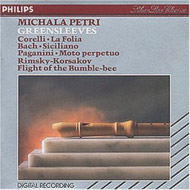

- Title: 'La Folia' Sonata Op. 12 No. 5
- Arrangement 'by an unknown master'
- Released 1982 by Philips LP 28PC-45 and compact disc 420897-2
- Duration: 9'37"
- Recording date: July, 1981 in London
- Petri, Michala (treble recorder) and Esfahani, Mahan (harpsichord)
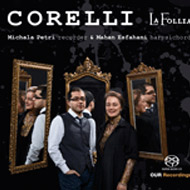
Mahan Esfahani wrote for the slipcase August 2014:The score (or set of parts, rather) used by us comes from a facsimile set of an undated publication by the famous eitheenth-century London publisher John Walsh. As stated on the printed title pag, the set of six sonatas was "transposed and made fit for the flute (that is , the recorder, as opposed to the "German" or traverso flute) and bass with the approbation of several eminent masters". The anonymous transscriber made rather clever allowances for a wind instrument, particularly with respect to the violinistic figurations found in the variations on "La Follia". The bass part rather sloppily replicates most of the figures found in the original Roman printing of 1700, and in general the publication lacks the aesthetic finesse of either that printing or the one by Roger of Amsterdam.
- Title: Violin Sonata in D Minor, Op. 5, No. 12, "La Follia"(arr. for recorder and basso continuo)
- Arrangement by Petri & Estafani
- Released 2015 by OUR recording compact disc ordernumber 6.220610
- Duration: 10'13"
- Recording date: May 5-8, 2014 in Garnisonskirken, Copenhagen, Denmark
- The Purcell Quartet: Elizabeth Wallfisch, violin (Petrus Paulus de Vitor, Brescia, 1790),
Richard Boothby, cello (anonymous English, c1750), viola da gamba (David Rubio, 1978, after Guillaum Barbey, Paris) Robert Woolley, harpsichord (single manual by Feldberg Whale,
1980, after Mucciardi, Italian 18th century)
'La Follia and other sonatas'
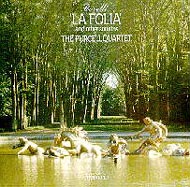

- Released 1987 by Hyperion compact disc CDA66226, in cheaper edition 2008 Hyperion Helios CDH 55240
- Duration: 9'56"
- Recording date: May 22-23, 1986 in St. Barnabas's Church, London
- The Purcell Quartet (Wallfisch, Elizabeth: violin & Boothby, Richard:
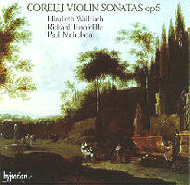
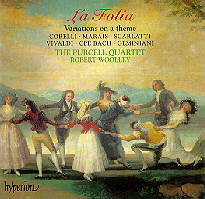 cello & Woolley, Robert: harpsichord) 'La Folia, variations
on a theme'
cello & Woolley, Robert: harpsichord) 'La Folia, variations
on a theme'
This cd assembles 'La Folia'-inspired works by six composers, starting with the original Corelli Sonata and ending with Geminiani's orchestral arrangement of it. The C.P.E. Bach and A. Scarlatti works are for solo keyboard. The six pieces are all taken from a series of earlier Hyperion cd's individually devoted to the respective composers. Duration of the six folias (incl. Marais, Vivaldi) 68'22"The Purcell Quartet plays all variations by Arcangelo Corelli
Duration: 9'56" direct link to YouTube
© 1998 by The Purcell Quartet- Title: Sonata in D minor, Op. 5 No 12
- Released 1998 by Hyperion compact disc CDA67035
- Duration: 9'56"
- Recording date: May 22-23, 1986 in St. Barnabas's Church, London
- Quadro Janas (Lorenzo Cavasanti: recorders, Dorothee Oberlinger: recorders, Jorge Alberto Gurerrero: cello,
Paola Erdas: harpsichord)
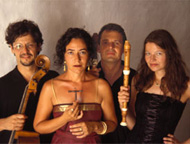
Andrea Lausi wrote about this performance January 11, 2005 in an email:
Duration: 10'12", 9592 kB. (128kB/s, 44100 Hz)
Quadro Janas live performance in an arrangement for two recorders
© 2004 Quadro Janas, used with permission
A comment on the Quadro - since Dorothee joined the Trio of the Lo Specchio Ricomposto I actually started considering this a sort of 'issue 0' for the quartet. Dorothee is a very good player, and also the trio was very good. But the four of them together really exceedes the mere sum of the components! There is something really unparalleled in the quality of the 'ensemble' sound which was (almost) never heard before. QJ resembles the Quadro Hotteterre, actually the Quadro in their name is an obvious hommage to the Dutch group, which is now unfortunately disbanded, and I have always considered Kees Boeke and Walter van Hauwe with the highest respect. More astonishing, the recording you have is from the FIRST concert QJ performed together. I was not there, but when they came back with the DAT tape I was really thrilled. I must also bow my head to Lorenzo and Paola for the recording sound quality: Lorenzo has a portabe profi equipement, and they did all the mike positioning by themselves, with the festival staff only helping with the on-off button. And when a few months later I finally had chance to listen to the quartet live, it was even better. It's a great group!
- Title: La Follia, Op. 5 No 12 in an arrangement for two recorders and b.c.
- Recorded during a live performance by Quadro Janas
- Duration: 10'13"
- Recording date: December 2004
- This music was used in an organic animation called La Folia by Jean Detheux
- The webpage of Quadro Janas can be found at http://www.janas-ensemble.it/eqcomponenti.htm
- Reger, Max edited the music for piano and orchestra (2 flutes, 2 oboes,
2 bassons, 2 kettledrums, a soloviolin, 2 violins, violincelli, and contrabasses)
- Title: La Folia, variations sérieuses pour le violon par Corelli, cadenza par H. Léonard
- Published 1914 by Schott Frères, Bruxelles
- Publisher No. S.F. 5614
- Reinecke, Carl
The free sheet music for piano is available at http://www.sheetsearch.com/sheets/7713/corelli-album-fuer-klavier-reinecke/
Francesco Ricci wrote in an e-mail August 19, 2011:. I found some informations about its publication on Imslp (http://imslp.org/wiki/Corelli_Album_%28Corelli,_Arcangelo%29")... It says 1895-96, the year of 1st publication.
Concerning Reinecke version I found these links with Corelli:
- Reinecke piece has 11 var. instead of Corelli's 22 var.
- Var.n.4-5 in Corelli are gathered in Var.4 (Reinecke) so Var.6 (C) become Var.5 (R)
- Var.7-10 (C) missing in R.
- Var.11 (C) become Var.6
- Var.12 missin'
- Var.13 become Var.7 (R) and Var.14 become Var.8 but very freely transcribed, in this last case
- Var.15(C) is Var.9 (R)
- Var.16,17,18,19 (C) missin'
- Var.20(C) is Var.10(R)
- Var.21 missin and last Var.22 (C) "sounds like" last Var.11 (R) but we cannot say it's the same piece, just the bass line is the same.- Title: "Arcangelo Corelli, Alnum für Klavier, Auserlesene Stücke", Folies d'Espagne d-Moll
- Pages 50-59 (with fingersetting)
- Published by VEB Breitkopf & Härtel, Musikverlag Leipzig
- Publisher No. 472-155 /B-303/64
- Respighi, Ottorino (1879-1936)
- Title: A. Corelli, Follia di Spagna (T.R.E.O.) Opus P 195. Trascrizione per violino solo con accompagnamento di piccola orchestra di Ottorino Respighi
- Il lavoro risulta dal Catalogo della Proprietà Editoriale della S.p.A.G. Ricordi & C. aggiornato al 31 dicembre 1956, ma non vi sono tracce né di manoscritto, né di edizione a stampa
- It seems that this arrangement of the music is never recorded nor published
- Romano, Conrado (violin) and Doris Rossiaud (piano) "Conservatorio di musica di Vicenza, Musica, Maestro!"
- Title: Sonata n. 12 "La follia"
- Released unknown date compact disc Conservatory without CD number but the Italian official seal that you see in
all Italian CDs states: CONSV1004
- Duration: unknown
- Recording date: October 13, 1952 in Ginevra, studio della radio Suisse Romande, Schwitzerland
- Roos, Frédéric de (flûte a bec) & Houtman, Nathalie (flûte a bec) with the ensemble La Pastorella:
Dirk Vandaele and Marianne Herssens (violins), Hans Devolder (alto), Hervé Douchy (violoncelle), Eric Mathot (contrebasse),
Alain de Rijckere (basson), Philippe Malfeyt (archlute and guitar), Guy Penson (harpsichord) 'Corelli in London,
Sonate & concerti per flauto'
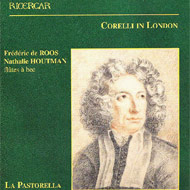
In the slipcase Frédéric Roos wrote (translation Peter Lockwood):
These 18th century editions are the basis for the programme that Frédéric de Roos has compiled: it includes not only various sonatas and concerti but also the famous variations on La Folia and the Concerto latto per la notte di Natale, in which the timbre of the recorder accents the music's pastoral character. [...] the 12th sonata stands out from the others, it being the renowned La Folia, a series of variations on the bass that had already been popular for over a century. [...] We have also chosen (to) make a free interpretation of Walsh's arrangements of La Follia, judging that the respect for the strong emotions that we find in Corelli's work would have been much more important for our virtual player and for us than a strict respect for the arranger's notes.
- Title: Sonate en sol mineur "La Folia" Op 5/XII for flûte alto et basse continuo: Adagio, Allegro, Adagio, Vivace, Allegro, Andante, Allegro, Adagio, Allegro.
- Ensemble directed by Frédéric de Roos
- Released 2004 by Ricercar compact disc RIC 235
- Duration: 11'48"
- Recording date: May 2003 in Eglise Saint-Apollinaire in Bolland
- Rosand, Aaron (violin) & Sung, Hugh (piano) 'The Romantic Baroque
Violin'

- Title: Sonata in D minor, op.5 No.2 'La Folia'
- Released 1996 by Biddulph Recordings compact disc LAW-006
- Duration: 10'44"
- Recording date: August 30 & September 1, 1991 in the Curtis Institute of Music, Philadephia
- Rubato Appassionato (Antonio Tejeda (recorder), Eyal Streett (Baroque oboe), Sasja Agranov (Baroque cello) 'Nord versus Sud'
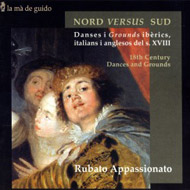
- Title: Follia Op. 5 /12 (Sonate, Opera V, Roma, 1700 & London, 1702 - Joe Walsh)
- Released 2005 by La mà de guido compact disc LMG2068
- Duration: 13'05"
- Recording date: April 1-2, 2005 in the capella de la Mare de Deu de L'Esperança Barcelona
- Saint-Saënt, Camille 'Oeuvres du XVIIIe Siècle'
- Title: 'Corelli: Les Folies d'Espagne'
- Sheet music transcription for violin and piano published by unknown
- Publisher's number 9905
- Transcription et réalisation de la basse chiffrée par Camille Saint-Saëns
- Savall, Jordi (viola da gamba [soprano]), Bruno Cocset (basse de violon),
Michael Behringer (harpsichord) 'La Folia, 1490-1701'
- Title: Follias, Op. 5 Roma (1700)
- Released 1998 by Alia Vox compact disc AV 9805
- Duration: 11'08"
- Recording date: July 31 and/or August 1-2, 1998 in the Studio Fondation Tibor Varga, Sion (Switserland)
- See also recommended recordings
- Schaarsmidt, Helmut (oboe), Hebb, Bernard (guitar), Ribke, Gunter (cello) 'Oboen-Sonaten des italienischen Barock'

- La Follia g-moll
- Released 1988 by Christophorus compact disc CD 74537
- Recording date: June 1987 in the St. Vitikirche Zeven
- Schaller, Erwin arranged the music for two guitars
- Title: Follia con Variationi
- Published 1981 by Preissler, Hans Libbert
- Score 13 p., 31 x 23 cm
- Publisher No. JPA21
- Schneider, Michael (recorder), S. Bauer (harpsichord & organ), Ozaki (lute),
Schneider (cello) 'Recorder Music of the Italian High Baroque'
- Title: Sonata in A minor La Follia.
- Duration: 11'06"
- Released 1995 by Capriccio compact disc 10512
- Duration: 11'06"
- Altblockflöte nach Stanesby jr: von Shigeharu Hirao, Kyoto
- Review in Early Music Review September: 20 (1995)
- Schneider, Michael (recorder), S. Bauer (harpsichord & organ), Ozaki (lute),
Schneider (cello) 'European Baroque Sonatas, Blockflotenmusik des italienischen Hochbarock'
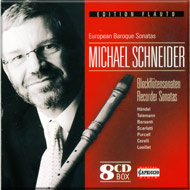 In the slipcase was written:
In the slipcase was written:
Both 'La Follia' and the Corelli sonata were composed for violin, but the flute versions are derived from 18Ih century sources which show the popularity of these works among the flautists of the time. The sonata is one of a series of five works named in sources as works by Corelli, which however has not prevented many researchers from doubting their authenticity, as these works vary in style from other works by Corelli.
- Title: 'La Follia' op.5 No. 12 for recorder and basso continuo
- Released 2007 by Capriccio 8cd-set, Edition Flauto cd4 49550
- Duration: 11'06"
- Recording date: 1995
- Altblockflöte nach Stanesby jr: von Shigeharu Hirao, Kyoto
- Schröder, Jaap (Baroque violin),
Joyé, Elisabeth (harpsichord),
Sala, Christian (viola da gamba),
Vidaller, Jérôme (Baroque cello), Bayle, Bertrand (lute and Baroque guitar) "Ariane & Bacchus ou les Passions Baroques".
- Title: La Follia
- Released 2007 by 'Les Heures Musicales de la Vallée de la Bresle' compact disc
HMVB2
- Duration: 10'52"
- Recording date: October 31-November 3, 2007 in Théâtre du Château d'Eu, France
- Schwarzer, Egon (recorder) and Mihajlovic, Egon (harpsichord and organ) ' Vivi felice - Musik des 15.- 18. Jahrhunderts aus Italien, Spanien und Dalmatien'
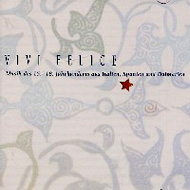
- Title: La Follia
- Released 2004 by Cybele compact disc 200.403
- Duration: 9'05"
- Recording date: unknown
- Serenata Ensemble (arranged for recorder)
- transposed to the key of g minor
- Released by Pierre Verany compact disc PV 789022
- Recording date: September 14, 1988
- Sestakova, Andrea (violin) and Macudzinski, Rudolf (piano) 'Corelli, Tartini, Schubert'
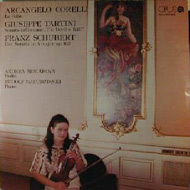
- Title: La Folia
- Released by Opus LP 9111 0629 Blue-black (CZ Press)
- Duration: unknown
- Recording date: March 1978 in the Studio of Opus in Pezinok
- Shinozaki, Rick K. (violin) and Todd, Sally (piano)
- Arrangement by Fritz Kreisler
- Recorded by Indiana University School of Music in Bloomington sound tape reel 1993-1994 no. 483
- Duration: 9'53"
- Recording date: February 2, 1994
- Shumsky, Oscar (violin) Kaye, Milton (piano)
- Released 1982 by Musicmasters LP 20037
- Score by Kreisler, Fritz
- Shumsky, Oscar (violin) Kaye, Milton (piano) 'Fritz Kreisler Music for violin and piano, volume three'
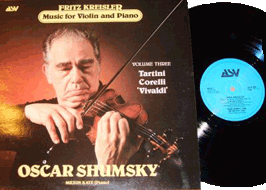
- Title: La Folia
- Released by Academy Sound and Vision (ASV) LP ALH959 (stereo, made in England)
- Place and date of recording not mentioned in the documentation
- Score by Kreisler, Fritz
- SineDux 'A.Corelli, Die originalbegeleitung zu Ihrer Instrumentalstimme, Violine'
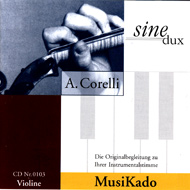 As a teaching device, only the b.c. of the harpsichord and cello is played while the student can include the solo
part of the violin for the complete sonate. The name of the players is not mentioned in the documentation.
As a teaching device, only the b.c. of the harpsichord and cello is played while the student can include the solo
part of the violin for the complete sonate. The name of the players is not mentioned in the documentation.
- Title: Violinsonate Nr. 12 ('La Folia')
- Released by Sine Dux MusiKado, Köln, Germany CD 0103
- Duration: 13'28"
- Place and date of recording not mentioned in the documentation
- Sklar, Maurice (violin) and Sung, Hugh (piano) 'The Romantic Baroque Violin'
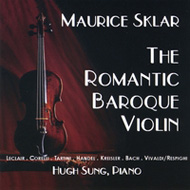
- Title: Violinsonate Nr. 12 ('La Folia')
- Released 2008 by Artists of Faith Music 2-cd-box 692125011070
- Duration: 10'30"
- Recording date: unknown
- Arrangement by Fritz Kreisler
- Societa Corelli 'Vivaldi, Corelli, Galuppi, Bonporti'
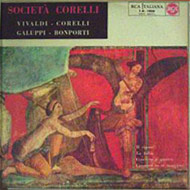
- Title: La Follia
- Released 1958 by RCA Italiana Red Seal LP ML 1880
- Duration: 6'33"
- Recording date: unknown
- Societa Corelli 'Vivaldi, Corelli, Galuppi, Bonporti'
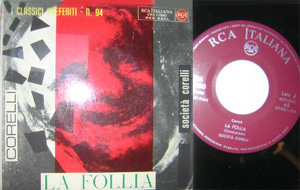
- Title: La Follia, sonata for violin and bass
- Released 1958 by RCA Italiana Red Seal 45 rpm EP ERA 1-1880
- Duration: 6'33"
- Recording date: unknown
- Sonatori Fiorentini (Antonio Aiello: violin, Andrea Landi: cello, Matteo Venturini: organ)
'Diavolo e Follia'
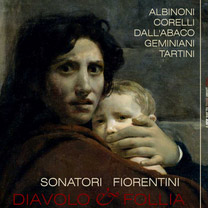
- Released 2014 by OnClassical compact disc order number OC30B
- Duration: 11'14"
- Recording date: 2009 in Chiesetta di San Miniato, Pisa, Italy
- The basso continuo and sometimes lead voice is played on the organ
- Spalding, Albert (violin) 'Albert Spalding plays Tartini - Sonata in G minor, Bach - Prelude in F sharp minor, Corelli - Sonata in A, Sonata in D, La Folia'

- Released 1953 by Remmington LP RLP-199-23
- Duration: unknown
- Recording date: unknown
- Sterne, Colin edited and realized the edition with arrangement for recorder
and figured bass (harpsichord or piano)
- original score published circa 1710 by John Walsh
- Published by Hargail Music Press, 1956.
- Score 16 p. and 1 part, 31 cm
- Publisher No. 3443
- Hargail classical anthologhy no. 14
- Stubbs, Stephen (baroque guitar), Maxine Eilander (Spanish aand Italian harps),
Erin Headly (viola da gamba, lirone), Milos Valent (violin, viola) 'Teatro Lirico'

Just a few variations are played following the traditional sheet music but with an unusual setting; here the part for solo violin is substituded by mainly the harp. The purpose of this short piece is that it is the ouverture of a compact disc with some improvisations on the Folia bass and some other folias.- Title: Sonata "Follia" op. , no. 12: Adagio
- Released February 2006 by ECM New Series 1893 4763101
- Duration: 2'13"
- Recording date; February 2004 in Propstei St. Gerold
- See also the page Recommended Folia-recordings
- Suk, Josef (violin) & Hála, Josef (piano) 'Evergreens'
- Released April 21, 1995 by Lotos compact disc number 9
- Duration: 11'32"
- Suk, Josef (violin) & Barta, Ales (continuo) 'Sonatas (12) for violin
and basso continuo, Op. 5: no. 12 in D minor 'La Follia'
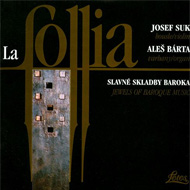
- Title: La Follia
- Released 1995 by Lotos compact disc number LT 0083-2
- Recording date: unknown
- Szeryng, Henryk (violin), Dreyfus, Huegette (harpsichord)
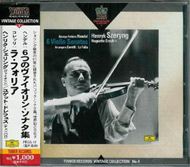 'Handel: 6 Violin Sonatas & Corelli: La Folia'
'Handel: 6 Violin Sonatas & Corelli: La Folia'
- Title: Sonata in D Minor Op.5-12 La Folia
- Released by Deutsche Grammophon Universal Music, Tower Records Vintage Collection Vol. 4, compact disc KK PROA17
- Duration: 10'55"
- Recording date: November 9-13, 1981, Paris
- Szigeti, Joseph (violin) & Otto Klemperer Los Angeles Philharmonic Orchestra 'Joseph Szigeti: A Centenary Tribute' features concert performances and broadcasts (1939-56)'
- Title: Sonata for violin & continuo in D minor ('La Follia'), Op.5/12 No 2 in D minor, 'La Folla'
- Released 1992 by the Music & Arts label 4-compact disc set
- Duration: 12'33"
- Recording date: 1945
- Szigeti, Joseph (violin) & Otto Klemperer Los Angeles Philharmonic Orchestra 'Klemperer in Los Angeles'
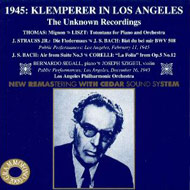
- Title: 'La Folia' from Op. 5 No. 12
- Released 2000 by Grammofono compact disc AB78643 (mono recording)
- Duration: 12'33"
- Recording date: Public Performances December 16, 1945 Los Angeles, USA
- Szigeti, Joseph (violin) & Otto Klemperer Los Angeles Philharmonic Orchestra 'Liszt Strauss Bach, the unknown recordings'
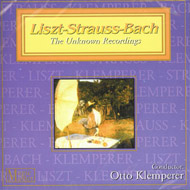
- Title: 'La Folia' from Op. 5 No. 12 (orchestral version)
- Released 1998 by Magic Master compact disc MM 37069
- Duration: 12'33"
- Recording date: Public Performances December 16, 1945 Los Angeles, USA
- Szigeti, Joseph (violin) & Otto Klemperer Los Angeles Philharmonic Orchestra 'Klemperer Maestro Mistico'
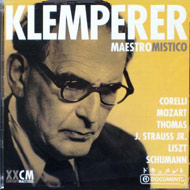
- Title: Sonatas (12) for Violin and Basso Continuo, Op. 5: no 12 in D minor 'La Follia' by Arcangelo Corelli
- Released 2004 by Maestro History double compact disc 203185 (mono recording)
- Duration: 12'33"
- Recording date: Public Performance December 16, 1945 Los Angeles, USA
- Szigeti, Joseph (violin) & Farkas, Andor (piano) 'Corelli, La Folia'
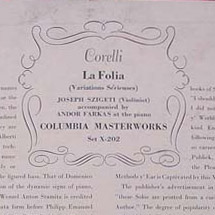
- Title: La Folia, Variations Sérieuses
- Arrangement by Leonard
- Released in the 1940's by Columbia, Columbia Masterworks collection 78RPM record number X-202.
- Szigeti, Joseph (violin) & Farkas, Andor (piano) 'Corelli, La Folia'
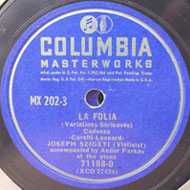
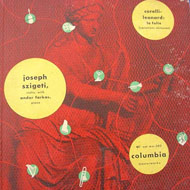
- Title: La Folia, Variations Sérieuses
- Arrangement by Leonard
- Released in the 1950's by Columbia, Blue and Silver "Magic Notes - Masterworks" Label) 2 record set (Made in U.S.A.) collection 78RPM record number MX 202 (71187-D // 71188-D)
- Recording date: Ca. 1950
- Szigeti, Joseph (violin) 'Joseph Szigeti: the recordings with Bela Bartok and Andor Foldes'
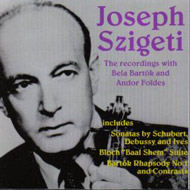
- Title: Sonata # 12 in d minor 'La Folia'
- Released 1993 by Biddulph Recording 2compact disc-set LAB 070-71
- Recording date: unknown
- Szreder, Robert (violin), Schaijk-Lambermont, Herma van (organ)
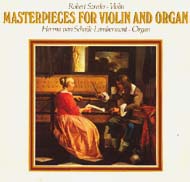 'Masterpieces for violin and organ'
'Masterpieces for violin and organ'
Hein Zomerdijk wrote for the cover:Originally, this theme was a Portugese dance, but during the course of the 17th century, on an Iberian peninsula, it was said to have originated from a certain melody - 'Les Folies d'Espagne' (the Spanish fools). It became very popular in many parts of Europe and was chosen by several composers as a basis for writing variations on a theme. The original sarabande or chaconne rhythm could even be combined with the specific technique of a recurrent bass part and also forms the basis for Corelli's 'La Folia' - although in the middle section a smooth rhythm is used for three variations.
- Released 1980 by Eurosound LP ES 46.482
- Duration: 9'30"
- Recording date: September 15 and 16, 1980 in Abdij van Berne in Heeswijk, The Netherlands
- Takako, Nishizaki (violin) & Harden, Wolf (piano) 'La follia'
transcription by Fritz Kreisler for violin and piano.- Released 1983 by Camerata LP CMTX-1506
- Duration: 11'55"
- Recording date: July 26/27, 1982 at Festeburgkirche Frankfurt
- Tamminga, Liuwe (organ)
Live performance of an arrangement for organ solo Barcelona, May 14, 2008
Duration: 8'12" direct link to YouTube
© 2008 by Tamminga and Catalunya Música- Title: La Follia
- transcription for organ solo by Liuwe Tamminga
- Broadcasted by Spanish radio 'ELS concerts' September 9, 2008
- Duration: 8'12"
- Recorded by Catalunya Música May 14, 2008 in the Catedral of Barcelona, Spain
- Tangerine Dream 'Josephine the mouse singer'
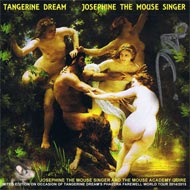 At service-cd was written:
At service-cd was written:
'Arcangelo Corelli's La Folia' is a symphonic, almost Bach-like track with synth strings leading the way on a jaunty piece of modern day classically influence synth music.
Arcangelo Corelli's La Folia
Duration: 7'40" direct link to YouTube
© 2014 by Tangerine Dream- Title: Arcangelo Corelli's La Folia
- Released 2014 by eastgate music & arts compact disc (cupdisc) ordernumber 069 CD
- Duration: 7'40"
- Recording date: unknown
- Tembembe Ensamble: Leopoldo Novoa ( marimbol, guitarra
de son, jarana huasteca, arpa llanera y tiple) ,
Enrique Barona (voz, huapanguera, jaranas, marimbol, leona, pandero y maracas), Eloy Cruz (guitarra barroca jarana barroca y tiorba)
Invitados: Ulises Martínez (violín, cajón de tapeo y voz), Ada Coronel (vihuela y voz), Andrés Flores (jarana y voz), Donají Esparza (baile tradicional) 'Diferencias e invenciones: Nuestro son barroco ' - Title: Folía para violín
- Broadcasted by a Mexican Radiostation during the anual festival 2009 in Guanajuato which is a state very close to Zacatecas in Mexico. It is a mixture of everything, including dance, theatre and plain entertainment. Savall has been there several times.
- Duration: 11'51"
- Recording date: October 22, 2009 in Templo de la Valenciana in Guanajuato, Mexico
- More about the performance at http://www.festivalcervantino.gob.mx/fic09/node/410
- Temmingh , Stefan (recorder) and Olga Watts (harpsichord) 'A. Corelli: Sonatas, Op. 5, Nos. 7-12'
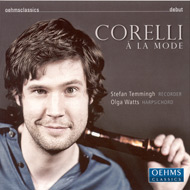
- Title: Sonata in G minor, Op. 5, No. 12, "La Follia" (arr. F.M. Veracini)
- Released 2009 by Oehms Classics compact disc OC598
- Duration: I. Adagio 0'40", II. — 0'35", III. Allegro 2'00", IV. Larghetto 0'45", V. Allegro 0'32", VI. Adagio 0'39", VII. Allegro 0'30", VIII. Adagio 1'27", IX. Allegro 1'11", X. — 1'21", XI. Allegro 1'16"
- Recording date: September 17-22, 2007 in der Kirche Neumünster, Zürich, Switserland
- Trio 21meter60 'Nothing but Tuba, Werke von Monteverdi, Piazzolla, Morricone, Schnyder, und Anderen'
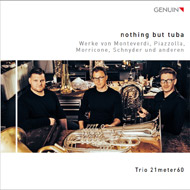 Arrangement for 3 tubas
Arrangement for 3 tubas
- Released 2021 by Genuin
- Duration: 7'36"
- Recording date: August 17-20, 2020 at the Bethanienkirche, Leipzig
- Trio Sonnerie 'Sonate violino e violone o cimbalo, Op. 5: 1-12'
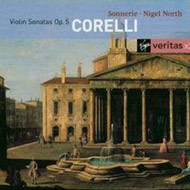 Monica Hugget: violine; Mitzi Meyerson: cembalo; Sara Cunningham: cello;
Nigel North: baroque guitar built by Robert Mavrinac 1982.
Monica Hugget: violine; Mitzi Meyerson: cembalo; Sara Cunningham: cello;
Nigel North: baroque guitar built by Robert Mavrinac 1982.
In the slipcase is written:
In the 'Follia' variations, a baroque guitar helps to bring out the Spanish roots of the theme.
- Released 1990 by Virgin Veritas double compact disc VCD 5 45978 2, re-released 2003 double compact EMI Virgin Veritas disc 24356 22362
- Duration: 11'10"
- Recording date: May 1988 & March 1989 Forde Abbey, Chard, Dorset.
- Trio Uccellini (Ende, Vincent van den (recorder), Wakelkamp, Frank (violoncello),
Blok, Gerard (harpsichord) 'Passionate Baroque'
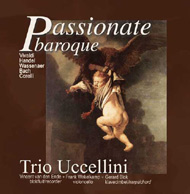 Anton Vooghelaar wrote for the slipcase:
Anton Vooghelaar wrote for the slipcase:
Playing Corelli's 'La Folia'hundreds of times has never filled us with boredom. Again and again it is a wonderful piece to play, rendering endless possibilities. It is an ideal piece of music for members of estabished ensembles to explore one another's horizons, to wait and see how they will react to one another, how the musical impulses of one musician are being understood and creativity worked out by another. It is attractive because of the full measure of always impressing virtuosity and of course because of the large range of changes, in spite of an endless repetition in harmonic scheme. The recorder as well as the continuo are fully recognized being equally important.
It is interesting to know, that the basso ostinato which 'The Follia' literally is based upon, has inspired numerous composers, amongst whom Rachmaninov. One variation from his 'Corelli-variations' (in major!) enabled us to create a wonderful moment of light in our interpretation'.- Title: La Follia
- Released November 2000 by Uccellini Productions compact disc ordernumber 26-00
- Duration: 11'52"
- Recording date: October 23 and 24, 2000 in Maria Minor Utrecht, The Netherlands
- Trio Veracini (John Holloway violin, David Watkin violoncello, Lars-Ulrik Mortensen harpsichord)
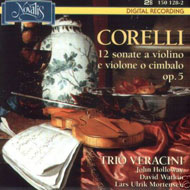
John Holloway wrote for the slipcase:Follia: 1st version violino e violone; 2nd version violino e cimbalo, ornamentation improvised
Follia (more commonly spelled folia in Portugal, Spain and Italy) is the name given to a musical framework used for songs. dances and sets of variations during the Baroque period. There are two distinct phases in its history: the first, from the late 15th century in Portugal to the third quarter of the 17th century in Spain and Italy was strongly associated with the guitar, and with songs and dances accompanied by the guitar. It was usually fast, with the wildness of spirit suggested by the name. In 1671 Francesco Corbetta published a set of Folia variations in which all the second beats were dotted; this, some changes to the harmonic structure of the early folia and the emergence of a virtually fixed melody led rapidly to the later folia. Almost always in D minor, the later folia was generally slower and more dignified than its forerunner. The earliest version is a 1672 Air des Hautbois by Lully, and in this form it flourished especially in France and England. Variations by Vivaldi, Alessandro Scarlatti, C.P.E. Bach, Marin Marais and others are all eclipsed in renown by these by Corelli, the most famous music he wrote.- Titles: Follia a violino e violone (12'34") and Follia a violino e cimbalo (12'18")
- Released by Novalis double compact disc 150 128-2
- Duration: 12'46" ("Follia a violino e violone" = violin and violincello) and 12'18" ("Follia a violino e cimbalo" = violin and harpsichord)
- Recording date: November 1995/March 1996
- La Turbulente 'Vol 2 'La Follia' & Sonataes da Camera, Opus IV no
2, 3, 6, 7, 8, 10 Opus V no 9, 11, 12
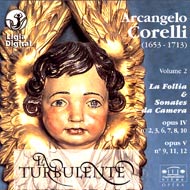 Susi Möhlmeier and Frédérique Thouvenet: recorder, Catherine
Latzarus: harpsichord and Nicolas Hartmannn: cello
Susi Möhlmeier and Frédérique Thouvenet: recorder, Catherine
Latzarus: harpsichord and Nicolas Hartmannn: cello
- Released 1997 by Ligia Digital compact disc Lidi 0301051-97
- Duration: 10'55"
- Recording date: October 1996 in the Opéra de Vichy
- University of Lviv Chamber Orchestra, 'Rummer Orchester der Universitat
Lviv'.
- Available as a tape cassette
- Released by Orchestra: Ukraine, 290054, Lvhv (Lemberg), Lubinska 96/78 Burko Serhlj TELEX 234128 TELCOP SLI FAX 72 67 39
- Veilhan, J.C. edited and realized the edition with arrangement for recorder
and figured bass based upon the J. Walsh arrangement for recorder and
basso continuo
Veilhan wrote about the Walsh arrangement (1702):In 1700, A. Corelli published his op. V, 12 sonatas for violin and bass, which immediately met with an immense success, thanks in great part to the 'Follia' that included the work. As early as 1702, the London editor John Walsh published a transcription of the last 6 sonatas of the op. V - including the 'Follia' - for recorder and bass, under the title: 'Six Solos for a Flute and Bass by Archangelo Corelli being the second part of his fifth opera containing preludes allmands corrants jiggs sarabands gavotts with the Spanish Folly. The whole exactly Transpos'd and made fitt for a flute and a bass with the aprobation of several eminent masters'.
This is the version that is always chosen by recorder players. If it is not quite as 'exactly Transpos'd' as he claims, Walsh's realization is nonetheless well adapted to the recorder, and this no doubt is the reason why - in addition to the interest of Corelli's composition - his transcription has known undisputed success until today
It is clear that Walsh intended to present a simplified transcription of the 'Follia' avoiding the low f sharp (the boring of double holes on the instrument being a rare occurance in the 18th century), as well as the high register, whenever possible. However, if certain 'octaviations' are indeed required by the compass of the recorder - more limited than that of the violin - others could have been avoideed in Walsh's version use of high notes. Also, Walsh deletes - in the recorder version - all double-stops written by Corelli for the violin. Yet these double notes are perfectly manageable on the recorder if the performer simulaneously plays the alto recorder with the left hand (the recorderstabilized by resting on the left knee), and the soprano recorder with the right hand: this process today employed in contemporary music, was practiced during the 18th century on the flageolet and double flute, and hails back at least to the double aulos of the Greeks ... Obviously, the double not performance of certain variations is left here to the taste of the personal player.- Title: Follia pour flûte à bec alto et Basse continue
- original score published circa 1702 by John Walsh
- Published by Alphonse Leduc & Cie, 1983
- Publisher No. A.L. 27000
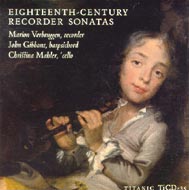
- Verbruggen (recorder), Gibbons & Mahler 'Eighteen-century recorder
sonatas'
- Released 1988 by Titanic Records compact disc TiCD-35
- Duration: 10'35"
- Recording date: July 1978 at the Lindsey Chapel, Boston
- Verhagen, Reine-Marie (recorder) & Mathot, Tini (harpsichord): Corelli
Ensemble
- Live registration of a concert for broadcasting by the Concertzender, The Netherlands
- Duration: 9'59"
- Recording date: May 24, 1997 at De Waalse Kerk, Amsterdam
- Broadcasted by De Concertzender September 15 and 18 (replay), 1997
- Voorhorst, Lucius pupil of Frans Vester (traverso Hemsing 1725 a=415)
& Dekker, Gerard pupil of Gustav Leonhardt (harpsichord, Schutze 1964)
& Bol, Hans (viola da gamba) 'Works of Corelli, Quanz, de Konink,
Locatelli, Händel'
- Released 1971 by Bovema/EMI Haarlem The Netherlands LP EMI-HMV 5C-053-24533
- Duration: 12'04"
- Recording date: August 1971 place of recording unknown
- Wagnermeyer, Franz (trumpet) and Kovács, Robert (organ) 'Festivo!'
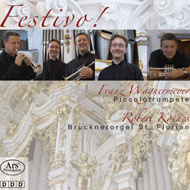
- Title: Sonate d-Moll op. 5 Nr. 12 fü Trompete and Orgel 'La Folia'
- Released 2007 by ARS Produktion compact disc ARS 38 476
- Duration: 10'35"
- Recording date: June 14-17, 2007
- Watillon, Sophie (viola da gamba), Stinders, Herman (harpsichord), Noiri,
Shizuko (lute) Leertouwer, Detmar (cello) "The Art of the viola bastarda,
or lyra viol"
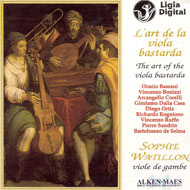
- Released 1994 by Ligia Digital compact disc Lidi0106020-94
- Duration: 9'48"
- Recording date: August 5-7, 1994 at eglise de Franc-Waret, Namur Belgium
- Weinberg, Norman (percussion), Sharpe, Kevin (piano)
- Graduate recital, recorded by Indiana University, School of Music in Bloomington
- Sound tape reel, 1983-1984 no. 36
- Duration: 11'47"
- Recording date: July 22, 1983
- Zathureczky, Ede (violin) and Petri, Endre (piano) 'Concerto for violin,
Viski & La Follia, Corelli-Leonard'

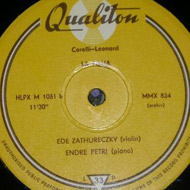 Arrangement for violin and piano by H. Leonard
Arrangement for violin and piano by H. Leonard
- Released 196? by Qualiton LP HLPX M 1051 not stereo but only mono
- Duration: 11'30"
- Zipf, Richard (organ)
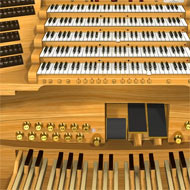
Arranged for 4 manual organ by Richard Zipf (2010, 2011, 2012, 2013). Performance on Hauptwerk Virtual Pipe Organ using Palace of Arts Budapest Pipe Organ Sound Sample Set (Gravissimo sCSA). Original MIDI sequencer unknown.Richard Zipf plays his arrangement for organ solo
Duration: 9'07" direct link to YouTube
© 2013 by Richard Zipf- Title: Corelli: La Folia
- Released May 2013 by Richard Zipf for YouTube
- Duration: 9'07"
- Recording date: 2013
- Zucker, Laurel (flute solo) 'Inflorescence III, music for solo flute'
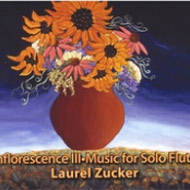 Arrangement by Laurel Zucker
Arrangement by Laurel Zucker
- Title: La Folia Variations: Movement I. Theme for Solo Flute, Movement II (variation 1), Movement III (variation 2), Movement IV (varaiations 3 and 4), Movement V (variation 5)
- Released 2008 by Cantilena Records
- Duration: movement I 0'52", movement II 0'22", movement III 0'35", movement IV 1'04", movement V 2'54"
- Recording date: unknown
So, to the very famous variations in trio on la Follia by Corelli, which open the concert, the response in false symmetry
at the very end will be the trio of the Folies d'Espagne by Marin Marais, his exact contemporary
the other side of the Alps two admirable pieces of equal length on the same motif, that Portuguese dance of the folia which passed
through Spain (whence the name "Folies d'Espagne" given to it by the French) and whose popularity soon swept
throughout Europe in the 17th century.
Lully adopted the famous theme and d'Anglebert won fame with his variations for harpsichord on the same subject.
This is before one finds it in Italy with the 23 variations from Corelli, and then again in France from Marin Marais.
Would extravagance itself not be a symbol of the Baroque, a precious asset of the imaginary and a pretext for everything daring,
for all metamorphoses?
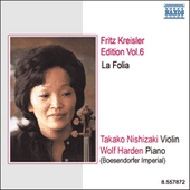
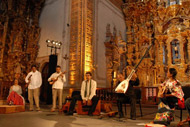 In the announcement during the concert was stated (thanks to Carlos E. Osuna for writing out the announcement of the piece):
In the announcement during the concert was stated (thanks to Carlos E. Osuna for writing out the announcement of the piece):
Ahora a tocar ahora una de las pocas piezas que si esta solita: es una Folia del compositor italiano Arcangelo Corelli,
que vivio a fines del siglo XVII y principios del siglo XVIII. La Folia o mas bien como comunmente se conocian
las Folias, no se por que tenian nombre en plural.
Decian en una obra espanola de teatro del principio del siglo XVII, que las Folias es, son las aguelas de todos los Sones
(lo ponian asi con "g": las aguelas de todos los Sones), porque eran el Son mas antiguo. Es un son que existe desde mediados,
por lo menos desde mediados del siglo XVI, y que de alguna u otra manera se ha conservado vivo desde aquel entonces.
La esencia de nuestro proyecto consiste en el mezclar estos sones muy antiguos que existen desde el siglo XVI
con los actuales sones tradicionales de Mexico (como los sones huastecos, jarochos, planecos de Michoacan, con los
arriben~os de por aqui de toda esta region) y encontrar las similitudes que sabemos que estan ahi.
En esta ocasion... Bueno, el ano pasado, debo decir que tuvimos el gusto de estar en este mismo recinto
con Jordi Savall, y el estaba muy sorprendido porque el traia una pieza italiana, y la empezo a tocar, la
pieza barroca, y uno de nuestros companeros, Patricio Hidalgo inmediatamente empezo a tocar una pieza jarocha
encima de ella. Entonces era como ensenarle una pieza tradicional mexicana a un musico barroco.
Lo que hicimos ahora fue traer una pieza barroca y ensenar.. mostrarsela a un musico tradicional mexicano,
a Ulises, que son unas folias para violin escritas por este compositor italiano, que sin embargo son un son,
como cualquier otro, no son como una pieza barroca muy especial, son tan son como la Bamba o cualquier otro.
Y de hecho, cuando lo estabamos tocando con el, les decia: estas figuras melodicas de aqui parecen huastecas, del violin.
Y luego decia: estas no parecen huastecas, estas son huastecas: es una pieza huasteca. Entonces, decidimos dejarlo que el
convirtiera estas folias barrocas que estan todas escritas: esta es una fotocopia del facsimil del original,
pero que las tratara libremente como lo hace con la musica viva y que las convirtiera en una pieza jarocha,
huasteca de hace 300 anos, de hoy. Yo creo que si la musica esta viva, funcionara, y aqui encontramos a la abuela
de todos los sones viendo a sus tataranietos huastecos en el esplendido violin de Ulises.
Now we are going to play one of the few pieces that are not paired: it is a Folia by the Italian composer Arcangelo Corelli, who lived at the end of the 17th century and beginning of the 18th century. The folia, or as it was more commonly known Folias (I have no idea of why the name is used in plural)... A Spanish theatre work from the beginning of the 17th century said that the Folias were the grandmother of all "sones", because they are the oldest "son". It is a "son" that exists at least from the middle of the 16th century, and which has been kept alive since then. The essence of our project consists of mixing these very old "sones" from the 16th century with today's traditional Mexican "sones" (Huastec-, Jarocho-, Michoacan planeco- and also arribeño-sones from this region) and discover the similarities that are there. On this occasion... Well, last year, I have to say that we had the pleasure to be at this same venue along with Jordi Savall, and he was very surprised because he brought an Italian piece, and when he started to play it, one of our colleagues, Patricio Hidalgo, immediately started playing a Jarocho piece on top of it. It was like teaching a traditional piece to a baroque musician. What we did now, was to show a baroque piece and teach... show it to a Mexican traditional musician, Ulises, and these are the folias for violin written by this Italian composer (Corelli), that are however a "son" like any other "son", and not like a very special baroque piece, as they are just a son like the Bamba or any other son. And when we were playing them with him, I told them: these melodic figurations seem Huastec, in the violin. And then I said: these, not only appear to be Huastec, these are Huastec: it is a Huastec piece. Then, we decided to allow Ulises to transform these baroque folias which are completely written (this is a photocopy of the facsimile of the original), and treat them freely, the same way he does with live music, and transform them into a Jarocho piece, a Huastec piece from 300 years ago, as of today. I believe that if this music is alive, it will work, and here, the grandmother of all "sones" will be watching all her Huastec granchildren under the splendid violin of Ulises.
Simple Folia for harpsichord intended for didactical purposes. First published 1749, reprinted in 1779
Duration: 2'21" direct link to YouTube
|
| Opening of Les Folies d'Espagne (1749)* | |
|---|---|
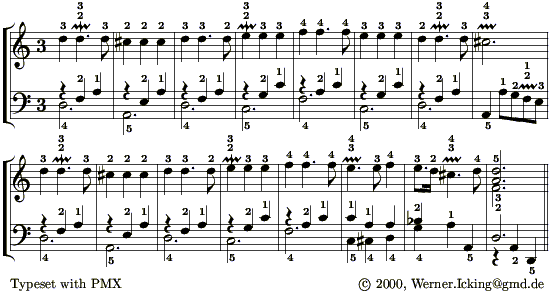 |
* In the original publication
of the sheet music the fingering is indicated to emphasize that the piece was written as an exercise for pupils |
- Baumont, Olivier editor of the edition
- Title: Les Folies d'Espagne in: Les Amusements du Parnasse, Méthode courte et facile pour apprendre à toucher le clavecin
- Published 1984 by Edition Henry Lemoine, Paris
- p. 5 and 6
- De Luca, Fernando (arcadian name; Ducande, Valerno) (harpsichord)
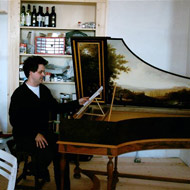
Fernando De Luca plays Folies d'Espagne
Duration: 2'13" direct link to YouTube
© 2013 by Fernando De Luca- Title: Les Follies d'Espagne
- Released November 2013 at YouTube by falernoducande
- Duration: 2'13"
- Recording date: November 2013 in Rome, Italy
- Gómez Álvarez, José Enrique 'Esbozos Antiguos'
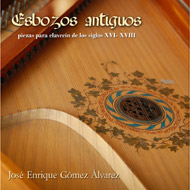 José Enrique Gómez Álvarez wrote about this piece in an e-mail 14 April 2014:
José Enrique Gómez Álvarez wrote about this piece in an e-mail 14 April 2014:
Why I have chosen this piece by Corrette? Well it is a piece that belongs to his treatise to learn how to play the harpsichord. It is a didactical piece where the fingering is indicated. It is a good example of home made music not intended for the virtuosi. I like the piece particularly because it shows that the popular piece was arranged for several purposes.
- Title: Les Folies d'Espagne: 1rer variation, 2e variation, 3e variation, 4e variation in: Les Amusements du Parnasse, Méthode courte et facile pour apprendre à toucher le clavecin
- Released January 2014 by Prodisc compact disc 7509848801549
- Duration: 3'03"
- Recording date: December 2013 in Mexico City, Mexico
- Instrument: Bentside spinet build by Alejandro Vélez in 2001
Jeffery Cotton was studying with Hans Werner Henze back in 1984 when Henze conducted his 'Aria de la Folia Espanola' at the Edinburgh Festival, which is also a massive orchestral Folia and which Cotton describes as a wonderful piece of music. In 2002 Jeffery Cotton has received the 2002 Aaron Copland Award.
Despite the very complex nature of 'La Folia for string orchestra and harp', it appealed to me instantly. Although there is obviously a collision between the old traditional melodic music and the modern style-figures the music seems very natural and smooth without fiercely forced ideas. After the opening in a very traditional way, the theme is still approached with caution in the first variation before making the journey to unfamiliar Folia-territory. Now and then the theme emerges again (4'11", 5'55", 12'01") as a beacon to lead the listener in a gentle manner. But better judge for yourself because the work can be downloaded in its full length at the page of the composer mentioned below.
 Jeffery Cotton wrote about his Folia-composition:
Jeffery Cotton wrote about his Folia-composition:
In my 'La Folia' I continue an ongoing pursuit: to write
music about music. This is an idea that came to me from Mahler by way of
Henze. This work is not a standard set of variations on the Folia theme.
Here, the theme itself haunts the margins of the piece, not so much in an
integrated, nicely-tied-together sort of way, but rather such that this
ancient idea seems to be trying to force its way into the present, into
my present. This approach to composing has always made sense to me, since
what I do – write orchestral and chamber music – has always seemed to me
an odd, anachronistic thing, belonging more to the past than the present,
and as such, a little mad.
In 1982 Gregorio Paniagua produced an album
called 'La Folia', a set of variations on the theme which seem to emphasize
the insanity aspect: the orchestration includes viols, crumhorns, sitar,
a klezmer band, and the sound of a car engine starting. It is a stunning,
hilarious compilation. In his very impressionistic notes for the album,
Paniagua made the following observation, which sums up perfectly my own
feelings about 'La Folia', and about writing music in general: 'All
the composers in the world who write their own Folia don't keep a close
account of what they are doing. They mature patiently like the tree that
does not haste his sap; They soak up everything and remain confident in
the torments of spring, without anxiety that they might not know another
spring. And spring comes and a quiet weariness overcomes them, even if they
are patient, carefree and calm, as if all eternity lay before them. They
can then love their Folia and their solitude; they endure the pain it causes
them and succeed in investing the sound of their complaint with beauty.'
More information about the oeuvre of Jeffery Cotton can be found at: http://www.jefferycotton.net/jcn/work_information.asp?WorkID=17. At this very functional and complete site you can listen to the entire Folia-composition in MP3-format (15 Mb) and download the complete partiture (pdf-format for Acrobat reader).
You'll need a MP3-player (like Winamp, or XingMp3player) to listen to the file below. You can download it from the web (www.mp3.com, or www.xingtech.com)
- Metamorphosen Chamber Orchestra, Scott Yoo conductor
The instrumentation is Violin I, Violin II, Violas, Cellos, Basses, Harp. Metamorphosen did it with 5-4-4-3-2 in the strings
- Dedicated to Dan Coleman
- Yet to be released
- Duration: 14'54"
- Recording date: March 9, 2001 at the Jordan Hall, Boston
- The complete Folia can be downloaded at http://www.jefferycotton.net/jcn/work_information.asp?WorkID=17
- Commissioned by Metamorphosen Chamber Orchestra
- Cotton, Jeffery
- For more details see the link above (http://www.jefferycotton.net/jcn/work_information.asp?WorkID=17)
- Duration: 14'54"
- Score: 55 pages (you can download the entire score from Jeffery's site). The instrumentation is Violin I, Violin II, Violas, Cellos, Basses, Harp.
Theme and 4 variations (and starting the first four bars of the 5th variation). First published 1811 by W. Mitchell, London England.
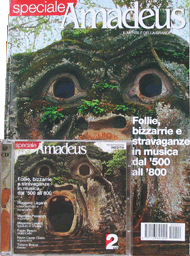
- Laganà, Ruggero (fortepiano) 'Follie, bizzarrie e stravaganze in musica, dal '500 all '800'
- Title: Follia di Spagna
- Released 2005 by Amadeus Darp, Milano, Italy double compact disc AMS 092-2 DP together with a magazine special devoted to the Folia Theme (April 2005)
- Duration: 3'53" (duration of Divertimento X: 18'49")
- Recording date: August 18-19 and November 15-19, 2004 in Chiesa di S. Maria Incoronata, Martinengo (Bg), Italy
- All variations nicely indexed
- See also the page Recommended Folia-recordings
 |
John Craton |
John Craton wrote about his composition March 2012:
I have long had a fascination with the original theme, after I studied the Corelli variations as a freshman violin major in undergrad years ago. As I recall, I had recently completed making an arrangement of the Salieri variations for violin & piano (which are published by Wolfhead Music) and decided to write a series of variations of my own. Some of these had been juggling around in my head for many years. The variations I wrote are in neo-classical style, thereby giving homage to the great works of Corelli and Salieri, but the variations are all original.The work was premiered by Ljubomir Velickovic (violin) and Dmitry Cogan (piano) in Sacrameto, California, US, in January 2010.
- Craton, John
- Title: Variations on "La Follia" Subtitle: In the tradition of Arcangelo Corelli & Antonio Salieri
- Published 2007 by Wolfhead Music
- Duration: app. 9 minutes
- Pages: 12 pp., piano; 5 pp., violin; 8½” x 11”
- For ordening and an impression of the openingspage for violin and piano see http://www.wolfheadmusic.com/folliavar.htm
- More about the composer you can find at his website http://www.craton.net/index.html
Despite the modern harmoniques and rhythm the Folía theme is clearly recognizable in every variation. Because of the rich influences of baroque, folk, flamenco and repetitive minimal music, these variations are very easy and enjoyable to follow from the start with its rich embellishment and syncopated countermelodies. Through a set of continuous variations, in which the folia is clearly evident as the harmonic basis, the piece develops from introspective sections to sections of greater intensity, resolving the accumulated tension at the very end.
 |
David Crittenden |
I freely composed over the bass progression commonly used by previous composers, but aside from that, my piece is not modeled after any other composer's treatment of la folia. I've always felt that the progression was beautiful and moving, so when the time came for me to compose a set of guitar quartets, it seemed natural to turn my efforts to this traditional form. Structurally, my piece (a set of continuous variations) has a two-measure introduction and a brief coda, and some of the variations have elisions between the end of one section and the beginning of the next.
As you listen to my piece, I think you will find that, while remaining largely consonant, it employs a modern harmonic language.
- Crittenden, David
- Title: Quartets for guitars, three intermediate works
- Published 2010 by Summy-Birchard Music (Alfred)
- Duration: app. 5'30"
- Premiere by students (Christopher Garwood, Stephen Krishnan, Tom Polzine, and David Tramm) of Alan Johnston in Minneapolis, Minnesota at the Suzuki Association of the Americas conference in Minneapolis in 2006
- You can learn more about this composer at his website http://davidcrittendenmusic.com/

- Adam Crystal
- Title Bonding, original music of the Netflix series
- Released 2019 by Lakeshore Records without order number
- Duration: 1'03" and 1'14"
- Recording date: unknown
- Website https://www.adamcrystal.com/
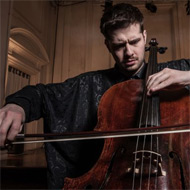
Ballet commissioned by Balletto Teatro di Torino (2010).
Follia II per violoncello solo (duration 6'12")
Lamberto Curtoni wrote about the piece:
The idea of "echi e follie" came to existence during my live concerts, in which i usually play classic peices and try to give them a touch of modernity. I decided to use Marin Marais's variations on the folia theme, and develop them in various directions.
It's entirely for cello, and all its tecniques. the music is very physical, and I tried to give it emotional freedom in order to create a connection between the cello's voice and the cellist's. "Echi e follie" is an outpouring of different emotions. Also in Matteo Levaggi's work you can see this very important feature.
"Echi e follie" is a musical project that I wrote on commission from the Balletto Teatro di Torino with choreography by Matteo Levaggi. The debut took place in February 2010 in Collegno (Turin) in the Lavanderia a Vapore (http://www.lavanderiaavapore.it/) one of the most important Dance center of Italy. Lavanderia a vapore was the true laundry of the mental hospital of Collegno (suburb of turin).
It was then taken on tour and is a project that we still have among the proposals.
In summer 2010, the title became La folia :"Echi e Follie" was also performed at the Ravello Festival in 2010.
I started to actualize the theme of "La Folia", writing sections that they like the bass and at times creating new sonorities created by delays or dissonance. In the Scene there's solo cello. (i work with my sound engineer with live electronics and file)
The lineup includes more movements and not everyone is in the bass line or theme of the Folia Marais is recognizable. Similarly, I wrote some scores titled "ECHI" who are opposed to "FOLLIE" and have different themes.
- Curtoni, Lamberto
- Title:
Echi e follie per violoncello solista, archi ed electronics, the parts:
- LUCE I
- ECHI II
- MADRIGALE
- PESTE
- LUCE II
- ECHI
- LUCE Beatriceʼs Song
- TRASPARENZE I
- URLI
- LET HER FINISH HER DANCE
- TRASPARENZE II
- CHI PASSA PER STA STRADA - Published by Casa Musicale Sonzoglo
- Duration ca. 70 minutes
- Three sound fragment (1'06", 0'46" and 1'55" respectively) you can find at http://www.lambertocurtoni.com/it/audio.php
- More about the composer you can find at his website http://www.lambertocurtoni.com/it/progetti.php
- The score is for rent at the publisher http://www.sonzogno.it/it/compositore?id=623&lang=it&epoca=1&opera=2391
- Title:
Echi e follie per violoncello solista, archi ed electronics, the parts:
